Why did you start your business? We’re pretty sure it wasn’t because you wanted to sell one product every blue moon, or because you don’t care about the services you provide.
Let’s be honest: We all want to make a difference, and we want to be recognized for delivering exceptional experiences. Without a positive reputation built on genuine feedback from satisfied customers, you can wave goodbye to local or worldwide recognition.
Related: 5 tips for building your brand with product & packaging design
You’ve probably noticed that bigger brands tend to have this nailed down. You see that red-and-white logo and instantly recognize Coca-Cola, or that blue background and yellow text belonging to IKEA. Even those multi-million-dollar brands had to start from somewhere. How on earth do you create something memorable—something that a customer will recognize and trust right away?
One answer is product packaging. Packaging is the first thing someone will notice on a shelf or when they receive a delivery to their home. The more they relate to it, the more likely it is that they’ll purchase or recommend it to others.
However, before you reach stardom, there are several ways to increase the chance of getting noticed. From the way you speak about your brand to how you package your products, here’s how to tell a memorable brand story.
Colors draw in the customer
Without color, the canvas is blank. A customer won’t look twice at your product if it doesn’t stand out to them in the first place.
Think about what feelings you want someone to get from your product. Should it make them feel like having fun, like a quirky craft beer? Should it make them feel cared for, like a health-related product? Make a list of how you want your product to make customers feel, and find ways to translate that to your packaging.
It can be easy to match colors with feelings: calming blues, bright yellows, passionate reds. A customer could be drawn to a certain color, depending on what they’re looking for. Colors can help you convey your brand identity, as well.
Who is your audience?
As with any form of marketing, keeping your audience in mind throughout the process is a must. Who will buy your product, and what product packaging will appeal most to that particular audience? Think about colors, shapes, sizes—even the wording on each individual product’s package.
Customers often read the text on a product to reinforce their purchasing decisions in their minds. [] For example, younger audiences prefer brighter, eye-catching colors with quirky shapes and blocky fonts. Older audiences who purchase luxury products prefer colors like black and gold, combined with elegant fonts and sophisticated language. It’s all about knowing who you’re selling to. Once you do, the rest will come far more easily.
Delivery boxes
No matter the size of your business, it’s not only important to have great product packaging on the shelves. When a customer makes a purchase online, they should feel the same excitement for their delivery as they do for the product in the box.
Depending on the size of your business, you might need to batch-order boxes for delivering your products. Businesses often need extra help to meet customer demand. BCS box-making machinery can help to create quality, durable boxing that makes an impact.
Consider sprucing up your boxes with custom-branded stamps, tape and delivery labels—as well as adding extra protection for your product inside each box. Think about padding, branded freebies, and money-off coupons as ways to encourage repeat purchases from your customers.
Logos & graphics
If you’re not including your logo and other branded imagery on your products, how do you expect a customer to know it’s you? When people see a familiar logo, they know almost instantly whether they trust that business enough to buy the product.
Graphics, although not always brand-specific, can often make or break your product packaging. If you’re selling healthy products, you’re more likely to succeed with a green, leafy design. Think about what works, and use a bit of common sense to gauge how you want the product to come across.
Product blurbs
Your brand story is important. So important, in fact, that many businesses make space on their product packaging to write a little about how their business started. Other companies write about their values, such as Lush and their natural, eco-friendly approach.
You can probably think of a few other examples of brands who do this well—which means they’re doing things the right way. The care and effort you take here will pay off when customers remember your story and take it to heart. Shoppers will appreciate an attractive design with an inspiring blurb more than one with a cut-and-dry description. Don’t forget that it’s often the packaging of a product that sells it, not just what’s inside.
Key takeaway
Customers need to recognize your products before building trust and loyalty in your brand. Find your brand’s voice and tell its story—your product packaging depends on it.
From its roots in the Middle Ages, layout design has evolved significantly. What was once the provenance of monasteries spread to the office, and later, personal computers. The overarching goals of publishers haven’t changed, though—to find an audience and communicate an important message. However, the nuts and bolts of desktop publishing are undergoing a revolution on par with the changes precipitated by Gutenberg. When planning your business’s layout design strategy, will you be ahead of the curve?
Related: How visual stimulation improves client retention
Illuminated manuscripts

Early examples of beautiful page layouts can be found in medieval illuminated manuscripts. The work process of the manuscript creators sounds remarkably modern: they would plan the overall layout of the page, including the ornately decorated drop capital and the decorative border, then they would draw straight lines on the parchment or vellum where the text would go. The medieval publishers showed specialization in splitting the duties of the rubricators (who filled in the red text), illuminators (the illustrators—forerunners of today’s graphic designers), and other scribes and artists. By the late Middle Ages, commercial scriptoria in cities were competing with the small-shop cloisters and monasteries.
From the story of illuminated manuscripts we can see the importance of advance planning in thoughtful layout design, and the inevitability of commercialization and mass production.
Gutenberg printing press
If you’ve ever looked for a public-domain book, you are probably familiar with Project Gutenberg. How did the Gutenberg printing press change layout design? By using movable type to expedite the printing process, a single press could produce thousands of pages per day, as opposed to a few hand-drawn copies.
During the post-Gutenberg era, some of the personalization of book layouts was lost. The use of two columns of justified text looks very modern. It lacks some of the opulent artistic qualities of the illuminated manuscript page. This era can be thought of the moment when word processing and layout design split into two distinct fields. This is still reflected in specialized programs, some aimed at text-based projects, and some more specifically aimed at visual layout design.

Pre-computer layout design
If you’ve watched a show set in the 1960s or 1970s, you know that “copy and paste” were once anything but metaphors. Before desktop publishing software, art directors, publishers, and printers physically designed their documents. Writers and journalists used typewriters, which evolved to electric typewriters, then standalone word processors. Many of the conventions of layout design were established during this period. The standardization of templates influenced the look of today’s books, newspapers, and magazines, even though they’re often consumed on different platforms.
Mid-century layout design shows that competing mediums for design can coexist. While this era saw innovation in design tools, traditional artists and printers were still part of the media landscape.
Computer desktop publishing
Thirty years ago, the arrival of “What You See Is What You Get” (also known as WYSIWYG) displays radically changed layout design. Arguably, this led to an initial decline in quality: without the ability to control kerning, letter-spacing, or font selection, the printed outputs from programs like Type Processor One or PageMaker were primitive, at best.
With each improvement in screen displays, processing memory, and style sheets, desktop publishing became a disruptive threat to traditional layout design. The swift evolution of WYSIWYG editors demonstrates the necessity of taking upstarts seriously—but of course, that’s easier to see in hindsight!
Proprietary layout software
Around the year 2000, the big names in desktop publishing—InDesign, Scribus, OpenOffice, Publisher, and Pages—rolled out their products. These are still major players in the professional market.

The quality of the output increased dramatically in this time period. As personal computers evolved to their now-familiar form, designers could control the digital page to look like the printed page.
Cloud-based layout design software
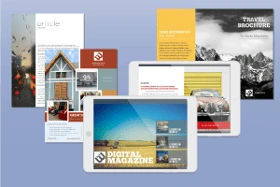
In the second decade of the new millennium, desktop publishing underwent another seismic shift. Rather than only license-based options, layout design software began a transition to the cloud. Some of the major players stopped offering their products à la carte, switching to a subscription model. Many print magazines and newspapers ceased publication, either shutting down or becoming web-only.
As internet connections became faster, browsers more reliable, and memory capacity increased, creators and consumers expected to be able to do more, to do it more quickly, and to do it better. As email became dominated by web platforms, word processing went to the browser (for example, with Google Docs), and tablets and smartphones introduced an explosion of apps, desktop publishing went to the cloud, as well.
Lucidpress is one of those sleek, cloud-based desktop publishing tools. With an easy-to-understand interface, auto-saving and web publishing, and deep integration with the applications that are a part of modern business workflows (Google Docs, Dropbox, and even Facebook), it’s bringing layout design out of the sphere of specialists. You no longer need an advanced degree to create high-quality print and digital publications—nor do you have to break the bank on your design software suite.
The future of desktop publishing
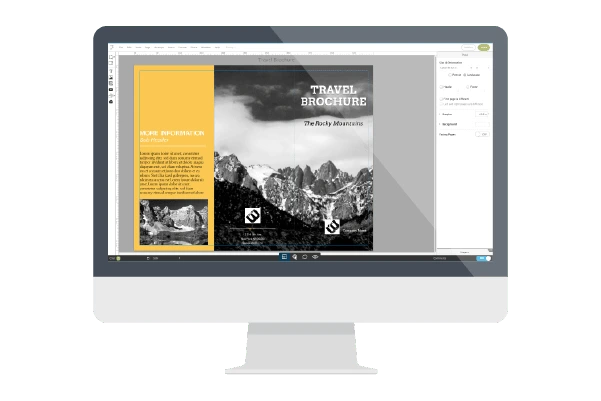
It won’t be long until the notion of your layout design being tied to a single “desktop” will be as quaint as the idea of a monk cloistered away with his vellum, or a magazine made with actual glue. More designers use laptops, tablets, and cloud-based products than ever before. This space is opening up to the public.
Since the software-as-a-service (SaaS) landscape is changing so quickly, it’s worth re-evaluating your business’s needs. What documents do you need to design to connect with your customers? How many resources are you willing to expend on desktop publishing software? Do you need the ability to share and collaborate with your team? Are you creating brochures, letterheads, flyers, reports or eBooks to be distributed?
Create striking visual content in minutes with our easy-to-use desktop publishing software. Get started for free today!
Sometimes the best idea is the simplest one. That was certainly the case for the founder of J Dawgs, a Utah-based hot dog restaurant that recently opened its fifth location.
One day, Jayson “J” Edwards, then an unfulfilled Asian Studies major, walked past an abandoned red shack in Provo, Utah, and decided that it would make a great hot dog stand. Naturally, he dropped out of school and got to work.

Seven years later, J opened his first restaurant outside of Provo and attributed his success to a single factor: “the food.”
Related: 5 branding lessons we can learn from Metallica
J was right about one thing: the quality of a product determines whether customers will keep coming back to it. But letting a product speak for itself, alone, isn’t a very good marketing strategy—especially for a small, relatively unknown business. It might work in the long run, but it takes a very long run to get there (seven years for J, in fact).
That’s what makes a brand’s personality—the human personality traits that it projects to potential customers—so important. It introduces people to your brand so they can form a positive impression even before they take a chance on your product. (Fortunately, J’s branding has now caught up with his product: see his new page).
In this post, we’ll look at five brands that we think each exemplify one of the dimensions of great brand personality.
1. Sincerity — lululemon
In order for customers to trust a brand with their business, they must first believe that the company actually desires their well-being.
That’s exactly how lululemon comes across with its lowercase, low-key approach to branding. It’s got all the passion of other brands without the tension that comes from trying too hard to impress. Lululemon’s straightforward approach convinces users that this brand has nothing to hide, that it is exactly what it professes to be.
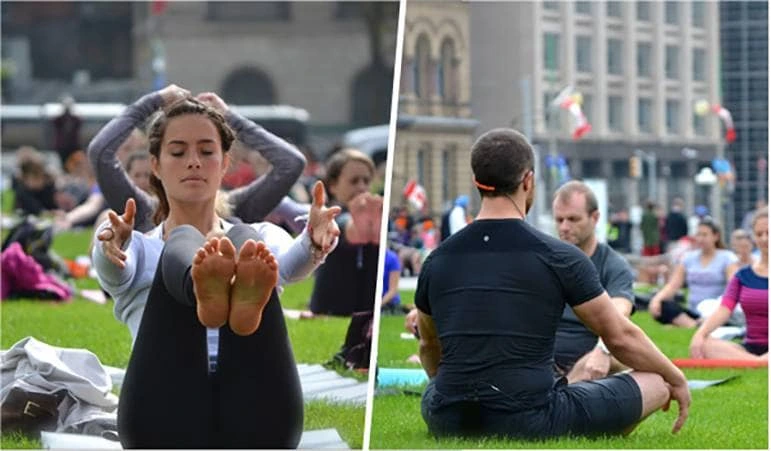
The lululemon blog’s focus on real stories about real people, such as those who participate in yoga on Canada’s Parliament Hill, reinforces its sincerity.
Businesses can develop a similarly sincere brand by setting realistic expectations with customers from the start instead of overhyping a product to force a sale.
2. Excitement — Johnny Cupcakes
While we all value our sincere friends for their truthfulness, they aren’t always the ones we turn to for fun on a Friday night—which is where excitement comes in.
Energy and inventiveness are at the heart of a brand’s excitement. Those are both strong suites of Johnny Cupcakes, a one-of-a-kind “t-shirt bakery” whose designs all manage to look vintage and fresh at the same time. We particularly admire the shaking cupcake-and-crossbones logo that appears whenever you’re waiting for another page to load: its movement suggests the energy underlying the whole establishment.
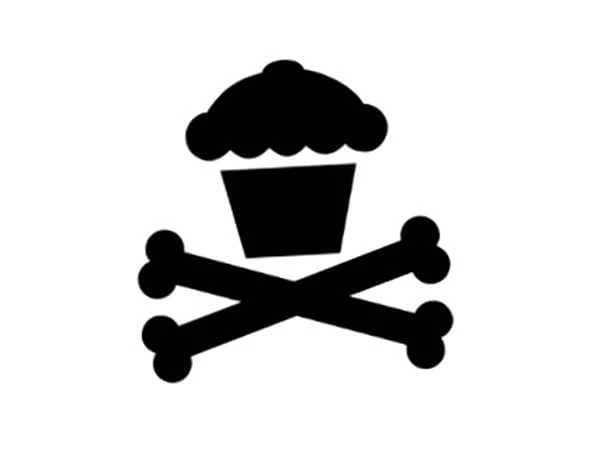
Companies wanting to give off exciting vibes should look for ways to incorporate pop culture references into their marketing. Such trendiness won’t just earn them more clicks—it will also convey to customers the thrill of buying and using their products.
3. Competence — Genius

A brand is considered competent if consumers perceive it to be dependable, intelligent and successful.
Genius.com manages to convey dependability with its barebones design, intelligence with its no-nonsense moderating system, and success with its insightful explanations of the history and vision of the site. Originally launched as a meeting ground for people to interpret rap lyrics, Genius is now home to helpfully annotated texts ranging from literary classics to fast food menus.
Takeaways for your business:
- Be sure to maintain a consistent brand identity as your business expands.
- Share customer success stories with your users to further cement brand competence.
4. Sophistication — Vango Art
Not every customer is looking for the pure functionality offered by competent brands. Sophisticated brands like Vango appeal to their clients’ more refined sensibilities.
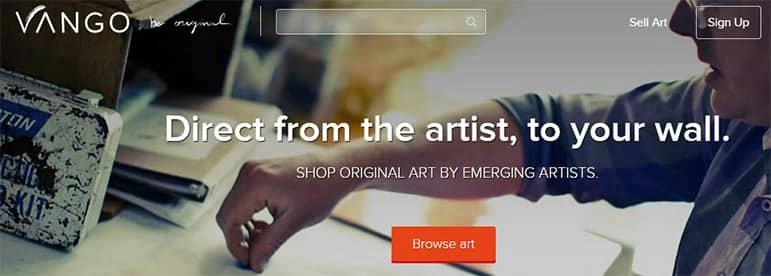
Everything from Vango’s cursive slogan (“Be original”) to the muted background colors contributes to a general sense of delicacy, balance and restraint. The real draw, of course, is the art itself, most of which appears to be the very soul of elegance.
To develop your brand’s sophistication, make it your goal to inspire, soothe and console your clients. For example, you might start a social media campaign, complete with a hashtag inviting users to share relevant, uplifting stories.
5. Ruggedness — Pebble Smartwatch
While a sophisticated approach might appeal to artistic types, it could just as easily leave behind the rough-and-tumble rovers.
In fact, a brand’s ruggedness can deliberately challenge the overblown sophistication of other brands. That’s exactly the case for Pebble, which produces a smartwatch that’s in direct competition with more expensive (and more indulgent) high-end watches. The ad below, with its retro pixel artwork and sassy tone, makes a strong appeal for getting back to basics. This tongue-in-cheek branding helps Pebble tap into the trend of anti-consumerism—without making you think it’s just a cheap watch.
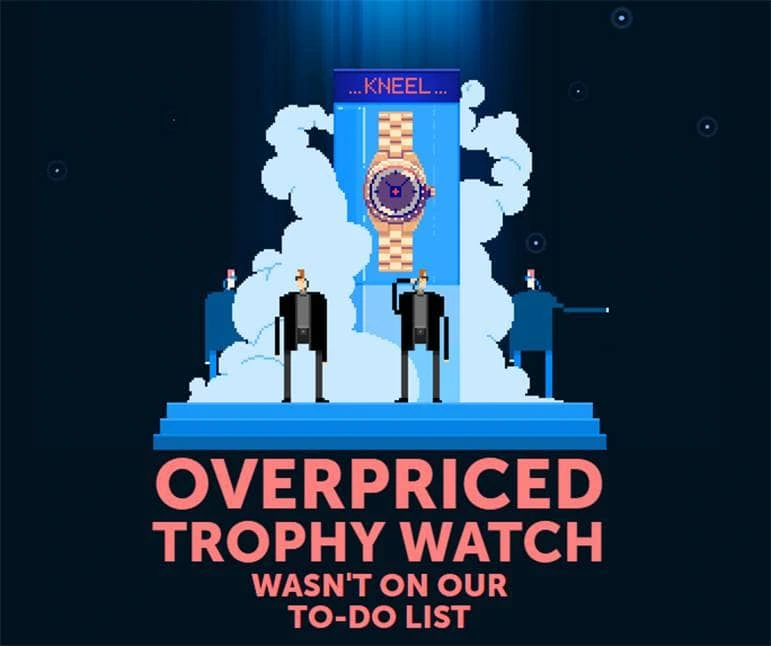
To build up a rugged brand personality, emphasize outdoor use cases and functionality over appearance. That’s not to say that your product should look bad; just don’t make it showy.
What does this mean for my brand?
While we’ve picked out brands that we think exemplify each of these characteristics, no brand can or should fit perfectly into a single category. Instead, you may blend several of these characteristics together for optimum results.
If you’re unsure where to begin, consider listing what you know about your audience. Your brand personality should be a response to their needs and interests. Once you know what speaks to them, you’ll begin to understand what kind of brand personality they will appreciate.
Learn more: Do you know the 10 essential brand assets for digital success?
Perhaps the term “long-form content” has made its way into the Promotions tab of your inbox a few times recently. Typical best practices for creating digital content suggest short-form content frequently seen in social content and webpages are easier to digest. However, there is a growing demand for long-form content in digital marketing.
What is long-form content?
Basically, long-form content is content with a word count of 1,200 words or more (according to Forbes). It can be a traditional blog post as well as a magazine, an eBook or a white paper, and a lot of voices are saying it’s the next big thing.
Do you have a negative knee-jerk reaction when you see someone touting long-form content’s wonders? Maybe what comes to mind is 7,000 words of text forming an intimidating mass that could cause minor head trauma if picked up and swung. Or possibly horrible flashbacks to school textbooks.
Let me start by saying that I am a millennial through and through, so thinking about a lot of boring text doesn’t really get me going. However, I am a believer in using long-form content in your content strategy.
Why?
Because if content (of any kind) is good enough, then people will stay on board for the long haul. []
This means they’ll spend more time with your brand and come to rely on you for dependable information and thought leadership.
Sure, our attention spans are getting shorter, but I like to think that, in many cases, what that really means is that we’re getting better at quickly determining what we want to spend time on and what we don’t care about. To survive a digital world filled to the brim with content, we have to pass on a lot of things, and do it quickly.
But think, for example, of the enormous success of The Lord of the Rings film trilogy. Though each of the films had a runtime of about 3 hours, the trilogy became a sensation and earned a whopping $2.9 billion worldwide. Why were people willing to follow 9 hours of film? Because there was a good story to tell. It was engaging and entertaining, and it was important to people.
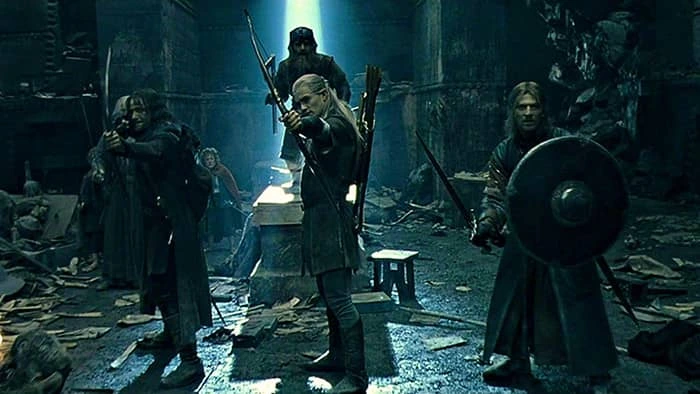
To really drive this point home, think about all the people that weren’t satisfied with just 9 hours of LOTR and bought the extended editions so they could get even more of what they loved. If you’re on an exciting roller coaster, you’re not waiting for it to end—you want more!
So how can your content marketing capture people’s attention like The Lord of the Rings? It boils down to two things: looking good and being interesting. The trilogy was visually stunning, and it had a captivating story. With hard work, your content can achieve the same results.
If you find an engaging story to tell and give some thought to the design of your content, you can create something that will add value to your readers and keep them coming back for more. The film example demonstrates that length and storytelling easily coexist when the story’s right—but what about good design?
How can long-form content look good?
To speak to aesthetically motivated fears, I actually think that good long-form content can sometimes be more visually appealing and less intimidating than its alternative. Take for example, these two versions of the CRM tool Highrise’s website.
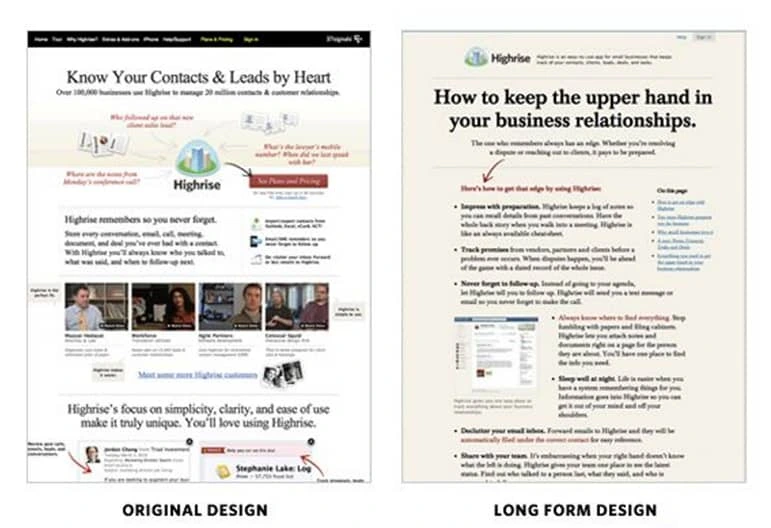
My first impression is that the original design is overwhelming and all over the place. It stresses me out trying to decide where to begin. The long-form design, on the other hand, is inviting and easy to follow. It’s designed in a way that is engaging, even while being longer. And here’s the kicker: Highrise’s long-form redesign increased conversions by 37.5%.
One reason that people may be more comfortable with a long-form design like Highrise’s is that it jives with what we’ve become accustomed to over hundreds of years. We’ve been reading books for a long time, so the layout of a long-form piece of content recalls familiar memories of your favorite novel. This effect is the result of careful design, and that’s where I feel Lucidpress can make a big difference. But more on that later.
What are some other benefits of long-form content?
In 2012, serpIQ conducted a study of more than 20,000 keywords and found that the top 10 search engine results had an average content length of more than 2,000 words, with the average number of words in the #1 spot at 2,416. Since long-form pages rank better in search engines on average, it’s likely more people will find your page and become customers. A few words from Google hint at the SEO possibilities of long-form content marketing:
“Users often turn to Google to answer a quick question, but research suggests that up to 10% of users’ daily information needs involve learning about a broad topic. That’s why today we’re introducing new search results to help users find in-depth articles.”
Pandu Nayak, creator of the Panda algorithm update
Another long-form content success story is Crazy Egg. They increased conversion rates by more than 30% with the use of long-form content. Also, this long-form content was approximately 20x longer than the previous version. That’s pretty dramatic, but so is a 30% increase in conversions. Here’s what Conversion Rate Experts had to say on the matter:
“The media would have us believe that people no longer have any capacity to concentrate. In reality, you cannot have a page that’s too long—only one that’s too boring. In the case of Crazy Egg’s homepage, visitors wanted their many questions answered and that’s what we delivered.”
I completely agree.
How to get started creating long-form content:
1. Determine your area of expertise. This will help you know what topic to write about. For me, I work in content marketing, so I feel like I have something to offer there. For you, it may be design, SEO, entrepreneurship, or, I don’t know, beekeeping. You’ll be able to tell the best story if you’re talking about something you’re closely involved with.
2. Research. For this post, I started out by googling “innovative long-form content.” Build on your expertise by looking deeply into current trends, statistics, and conversations.
3. Identify your target audience. All content needs to be relevant to your audience, but it’s especially important for keeping your reader’s attention with long-form content
4. Decide on your medium. It may be a blog post, but it also might be a magazine, an eBook or a white paper. Determine the type of content that will give your story the best presentation and resonate most with your audience. For example, this post could have worked with a white paper or eBook template, but it wouldn’t have been right for a magazine. A magazine might be better for a monthly newsletter with highlights across several different areas rather than a singular focus.
5. Start writing, then tell everyone you know about it once you’re done!
Standout examples of long-form content
Now that we’ve talked about the benefits of long-form content, let’s take a look at the innovators. There are some companies and organizations out there who are really nailing long-form content, and I’d like to go over 5 examples. Let’s dive in.
1. NewsCred
NewsCred has mastered the art of the seemingly impossible by making the white paper sexy. They understand visual storytelling, and they’ve invested a lot in the future of content marketing. Here’s a page from one of their white papers:
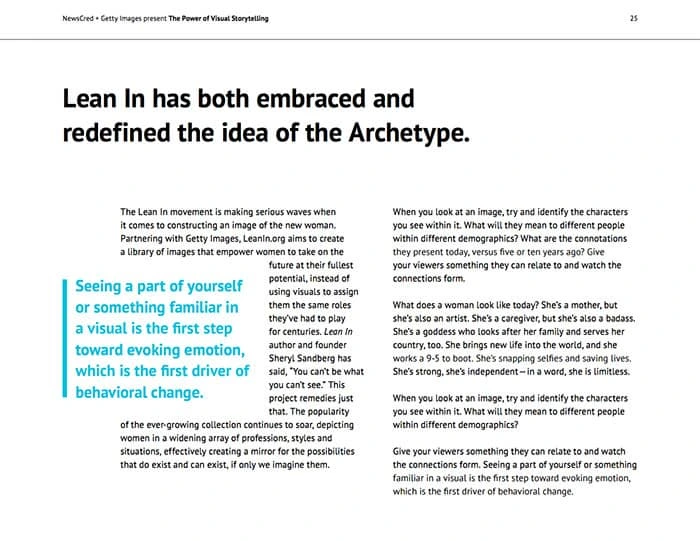
It’s manageable, it’s compelling, and it goes on for 35 pages. And you know what? I read through all of it. It captured my attention, and I walked away with valuable insights. NewsCred shows not just how long-form content can be compelling, but content in general. The long-form aspect of their content isn’t a gimmick—it’s just the best way to present the story they’re telling.
What NewsCred got right:
- Thought leadership (statistics, quotes, innovative ideas)
- Scannable and easily digestible
- Great design and striking images
2. Insider Journeys

Take a look at the beginning of this piece of content on Insider Journeys’ blog. Does it look like the start to an intimidating, boring content piece?
No. It’s immediately engaging and intriguing. Right when I opened it up, it had my attention, which it kept as I scrolled through page after page of what I think is best categorized as a mini-site.
I think this piece is the most elegant and beautiful long-form content I’ve come across in my research. It also defies expectations of what long-form content is. As you progress through the mini-site, there are intriguing facts, fun stories, and even a recipe for “the perfect Vietnamese coffee.”
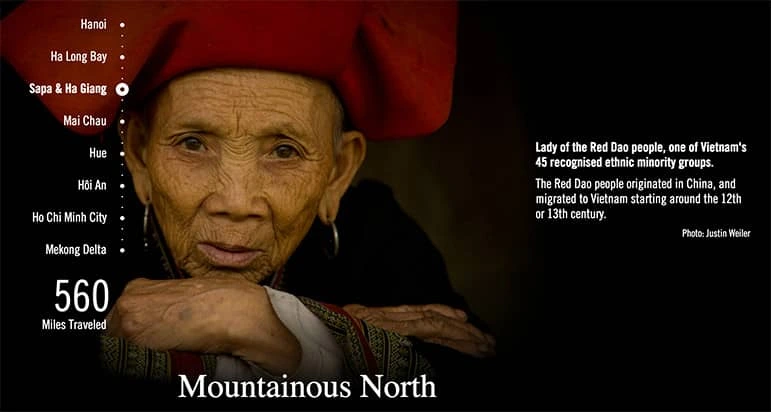
On Insider Journeys’ mini-site, we see a marriage of design, copywriting and storytelling presented in a refreshingly compelling way. They’ve set the bar for what businesses can strive for with their content, and I have a hunch that content like this will stand out as the web gets increasingly crowded.
What Insider Journeys got right:
- Great organization and natural progression keeps readers from getting lost while scanning
- Powerful storytelling
- Image-based presentation that holds readers’ attention
3. Towergate Insurance
Wait! Don’t click away because you saw “insurance” and nearly died from boredom. Yes, insurance isn’t the most entertaining subject you may come across, but Towergate has made a noteworthy accomplishment with long-form content by making insurance accessible.
The piece of content I’d like to specifically point out is a guide to commercial property insurance, which isn’t really my cup of tea. But I was impressed with how, after a quick scan, I was able to comprehend the main idea of a fairly dense topic.
Towergate’s clarity kept me from getting lost in volumes of unbroken text. This effect was enhanced by the clean layout of the content. Take a look:
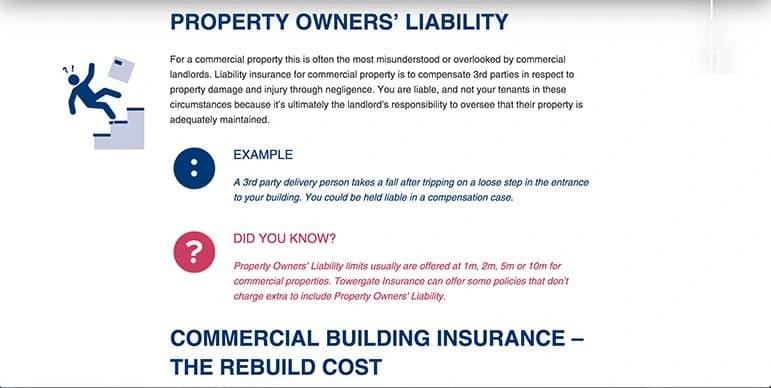
What Towergate got right:
- Straight to the point (still possible with long-form content)
- Clean layout
- Relevant section titles that aid in comprehension
I’d like to give credit to this great Moz article for helping me find this and the previous example.
4. Hip-Hop University

This example, along with the following one, are examples of long-form content that was made in Lucidpress. Before I go further, I want to be transparent about my motives here. First of all, I think these are great examples of well-designed, interesting long-form content made by smaller organizations. Beyond that, at Lucidpress, we really feel that businesses and organizations can benefit from using our product to revitalize their content marketing, especially in the long-form content space where design is crucial.
“Lucidpress template design makes everything very user friendly. I signed up to Lucidpress with no experience, but was able to achieve all of my needs and more.”
Albert Carter, co-founder of Hip-Hop University
Now back to Hip-Hop University’s digital magazine. There are two big reasons why I really like what they’re doing with this magazine. First of all, it’s a great example of long-form content presented in a unique way. Second, I appreciate Hip-Hop University’s commitment to furthering digital publishing and embracing its potential for content marketing.
Long-form content goes beyond the blog. You can have phenomenal long-form content in the form of digital magazines, eBooks, and as we saw earlier, white papers.
What Hip-Hop University got right:
- Innovative medium
- Professional cover that makes people want to read
- Blend of informative content and storytelling
5. International Academy of Wedding and Event Planning
This academy did a beautiful job with its 2016 Wedding Trend Report, and it’s all made in Lucidpress. This report is similar in form to an eBook, and it shows how diverse long-form content can be. The 2016 Wedding Trend Report combines illustration, photos and text to keep the content interesting, and it even utilizes Lucidpress’s interactive features with an embedded Youtube video.

What the International Academy got right:
- Interactive presentation
- Beautiful use of graphic elements
- Extensive thought leadership
Go forth and be awesome
I hope that something in this post has resonated with you and sparked some ideas about long-form content. It might be worth noting that this post is itself a piece of long-form content, and that’s because I really do think that long-form content will play an important role in content marketing’s future.
Go out and start experimenting with your content to find what fits best with your brand. You’ll need to determine what story you want to tell, and then tell it in a genuine, transparent way that lets your passion shine through. If it’s a good story, people will listen.
Learn how Lucidpress can streamline your brand’s content marketing and keep your whole team on the same page.
We love stories. We use them to understand our world, to make connections with others, and to find meaning in our lives. Ever notice how, at a party with a lot of loud conversations, when someone starts getting into a great story, the conversation dies down and everyone turns to listen? That’s the power of stories. We can’t resist the good ones.
That being said, it’s no surprise that the brands who tell great stories are being noticed. At its best and most powerful, content marketing is storytelling. [] That’s what the phrase “storytelling marketing” is getting at—a story-focused approach to your marketing and brand building.
Related: How to use storytelling to raise conversion rates
In this post, I’ll cover four examples of brand storytelling from top companies and talk about how all of us can learn from and apply their best practices. So keep reading to see what Apple, Airbnb, John Deere, and Jell-O can teach us about storytelling marketing and building a brand.
1. Apple and Steve Jobs
Apple was destined to make it onto this list. Ever since my family got our first Mac, I’ve been a fanboy. And as for Steve Jobs, his life and work have inspired me personally and professionally in deeply affecting ways. He’s one of my superheroes. Personal stakes aside, Apple can tell a great story. And often, Steve Jobs was the one who told those stories.
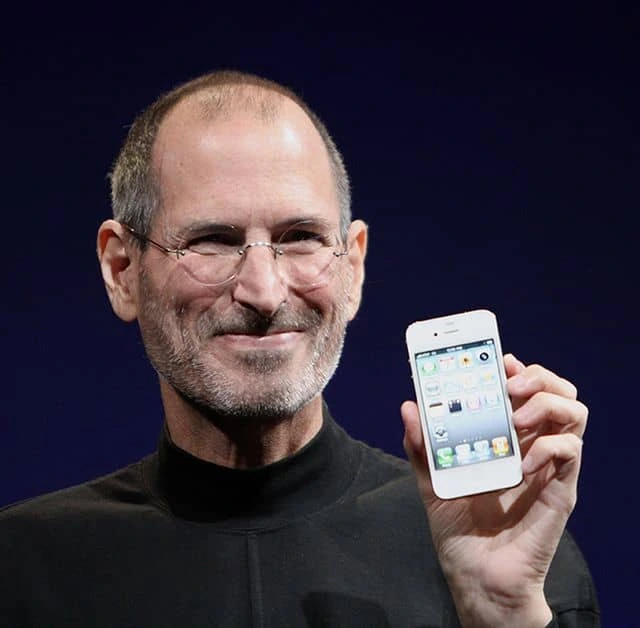
Jobs’ introduction of the first iPhone in 2007 is the stuff of legend. I still get goosebumps watching it and basking in the masterful storytelling. Steve begins by telling the audience why they should care about what he’s about to tell them. Because of what Apple had done before, and because Apple knew their market so well, it was almost a given that people were invested in Steve’s presentation. But he doesn’t make that an excuse to ignore good storytelling principles.
Steve begins the presentation by masterfully building suspense. A touchscreen iPod? A phone? An internet communicator? What is he up to? Then, even as the audience is starting to catch on, he lingers in the suspense a bit longer before making the reveal: a three-in-one mobile phone that would change the world forever.
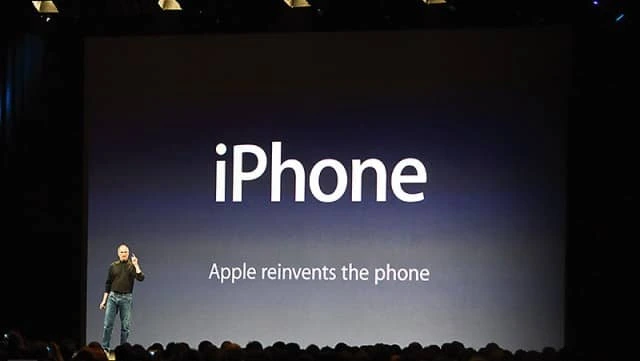
Jobs was building the iPhone’s brand even before the audience had seen it, and the story was consistent with the company brand Apple had already built. Apple knew they’d made something exceptional. It was up to Steve to tell the best story, and he did.
Today, Apple continues Steve Jobs’ tradition of storytelling marketing. They do a great job of telling a story about what it looks like for customers to successfully use their products. Apple weaves their products seamlessly into the story. They also show how their products help people create their own stories, and Apple highlights the stories people create.
An example of this is the “Start Something New” initiative that showcases art people are creating with Apple products. With this page, Apple is providing a platform for their customers to tell the brand’s story, a technique that can produce the most authentic and engaging results.
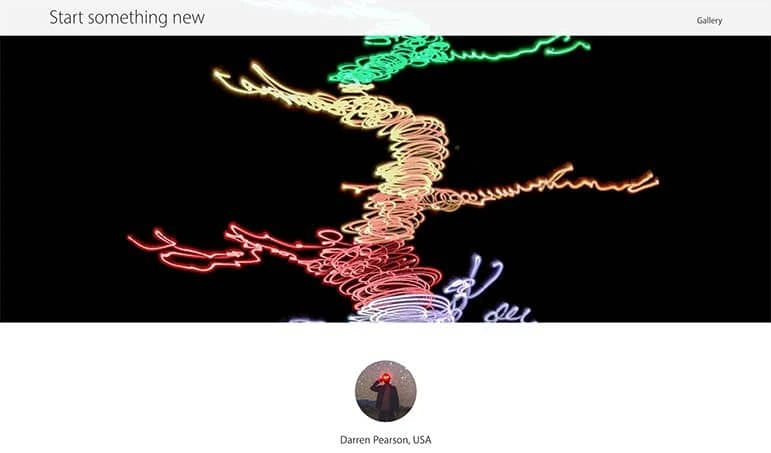
I will say that this site has some big UX issues, which is uncharacteristic of Apple, but I love the idea. Apple’s TV spots for the iPhone 6S also follow this principle. The spots don’t linger on gratuitous close-up shots of the iPhone and how pretty it is (though boy are Apple products pretty). They show relatable but slightly-cooler-than-is-realistic people using the iPhone to do really cool things.
What can we learn from Apple?
- Hook the audience first, introduce your product second
- Build suspense
- Focus your story on customers successfully using your product
2. Airbnb
I’ll just come right out and say it: Airbnb blew me away with their content. It’s the kind of stuff I would enjoy reading just because. After browsing the content for a bit, I was totally hooked. And I never once felt like I was being marketed to. But I can say that I definitely wanted to go stay somewhere with Airbnb after reading.
So their approach works. Airbnb’s content is totally focused on people—on the people who own the homes listed and the travelers who go there. They show how connecting with others is important to their brand and how their brand makes that possible. It’s a very human approach, and it works perfectly. In a very clear statement about the importance of stories to the Airbnb brand, there’s an entire page on their website labeled airbnb.com/stories.
This page has videos and little bios of Airbnb hosts around the world. It was one of my favorite things I found on the site.
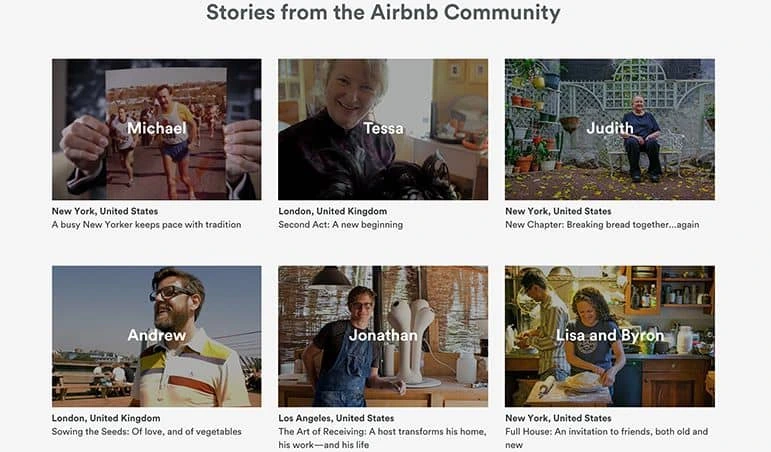
Here’s one of the stories that I especially enjoyed. Airbnb is also experimenting with a brand magazine called Pineapple. On their website, Airbnb describes Pineapple as “a platform for the incredible stories from Airbnb’s extended family to be shared; it is somewhere for readers to see how people live and create connections in cities today.”

This meshes perfectly with the rest of Airbnb’s approach. They focus on the stories and on the people, recognizing that this is the language by which humans communicate, so that is the approach that will attract more customers. There is also a truly genuine element running through Airbnb’s content.
At least I got the sense that they really do care about their communities and the impact that Airbnb has on them. They are invested in the lives of these people. They care. Content marketing best practice? Care about your customers. []
What can we learn from Airbnb?
- Ask yourself, “Would people pick up my content from their coffee table and read it?”
- Always bring it back to the human element
- Be sincere
Note: I found a lot of the information about Airbnb from this post.
3. John Deere
Believe it or not, John Deere is pretty darn good at content. And they’ve been putting an emphasis on content since before most other brands even existed. For some context, let’s take a quick look at the history.
In 1895, John Deere printed the first issue of The Furrow, their brand magazine. This was long before anyone had even mentioned the phrase “content marketing.” By 1912, the magazine was being distributed to 4 million readers. John Deere still produces The Furrow today, which is received by about 2 million global readers.
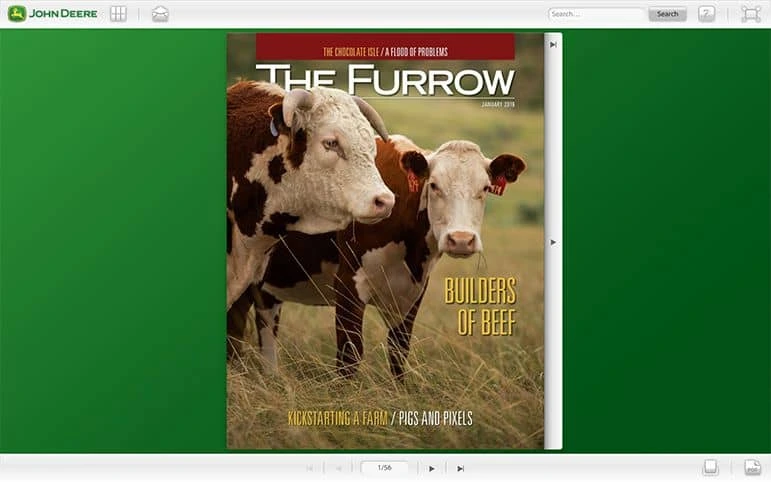
It may not have been hard for the folks at John Deere to realize that agriculture is important to their customers, and, predictably, agriculture is the focus of The Furrow. But it’s the diversity of the topics and stories covered that really makes this magazine stand out. It may be tempting to group all farmers into one category, but from what I’ve seen, they’re a diverse group. In speaking to farmers generally, John Deere has the difficult task of telling stories that a lot of different people will care about.
This is reflected on the topics that are featured in The Furrow. They run the gamut from a piece on the beef industry to coverage of gourmet chocolate production in St. Lucia. Both of these stories are focused on agriculture, but in very different ways. Even so, because they’re interesting, well-written stories, they have a broad appeal that transcends differences in the agricultural community.

I also really like the fact that The Furrow is a magazine, and even more, I like that it’s distributed digitally. Using Lucidpress, your brand can follow John Deere’s lead and create digital magazines to present your story and build your brand. Lucidpress has a great collection of online magazine templates that make the process fast and easy. Lucidpress also has collaboration features that allow a team to work together on the same project at the same time. If stories enhance human connection, then it’s also true that the best stories come from humans working together.
What can we learn from John Deere?
- Utilize the digital magazine medium
- Know what connects your customers to you
- Don’t get stuck telling just one story
Note: The historical information about The Furrow is from this blog post.
4. Jell-O
I thought it’d be nice to wrap this post up with a fun example. Who doesn’t love Jell-O, right? Ok, a lot of you probably don’t like to eat Jell-O, but I dare you to tell me that you don’t find joy in this:
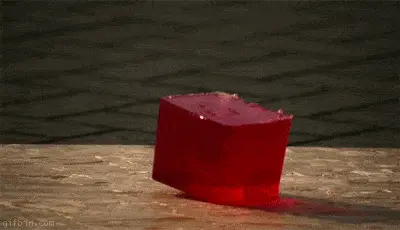
And then there’s this classic scene from Jurassic Park:

Never gets old. But in addition to providing endless entertainment without ever leaving us too full, Jell-O does a good job of brand building with storytelling marketing. The story Jell-O has focused on is people successfully making delicious desserts using their product (a similar approach to Apple, but with gelatin instead of hard drives).
Half of their website is devoted to easy-to-make recipes, and the photos of the finished products come together to form a great example of visual storytelling. Take a look:
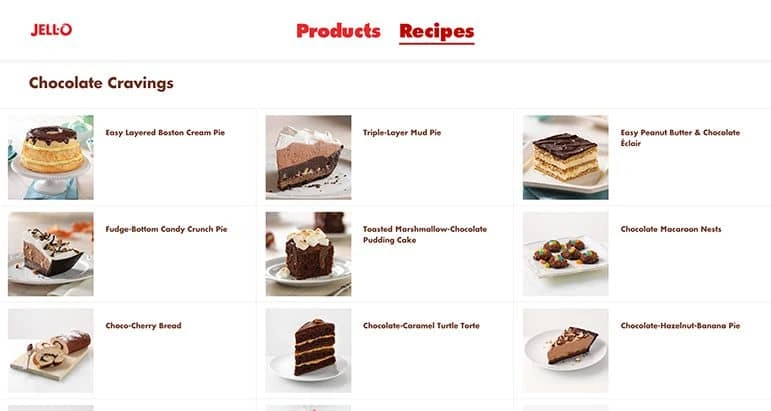
What this page illustrates is that you can get creative with brand storytelling. Recipes might not be the first thing that comes to mind when you talk about storytelling marketing, but because of the way Jell-O presents their recipes, it becomes a story about all the things that you can do with Jell-O. Sure, they left out this application:

But they told a good story, regardless.
What we can learn from Jell-O?
- Think outside of the box when deciding how to Kraft (couldn’t resist) your story
- Make your story actionable—what are customers going to do because of it?
- Don’t forget to make it look good
So now what?
Brands live or die on their ability to enhance human connection. And stories, I have found, are the best way to build connections. So, take a look at your brand. Find the human element, and ask yourself, “How can I make people’s lives better? What story would they like to hear?”
You can jump on a call with some of your customers or maybe send out a survey to find the answers to these questions. Once your brand’s story begins to take shape, you can use Lucidpress to present your story in the best possible way. Whether that’s a magazine, a monthly newsletter, an eBook, or something else entirely. If your customers feel that your brand improves their lives, then they’ll want to be a part of your story. And in the end, your story is your brand. So make sure it’s a good one.
Want to know more about how to build your brand? Download our free ebook on how to build a brand in 2020.
A picture truly tells a thousand words. From pie charts to cartograms, infographics have been around since the first humans learned to scratch symbols into the dirt. After all, an infographic is composed of only three vital elements: visual, content and knowledge—qualities shared by the earliest of cave drawings and the most technical of modern computer-aided data visualization.
Today online tools empower anyone to create infographics, but this visual format is not new. In fact, they are among the oldest forms of communication, and it only makes sense that they’ve retained their function throughout human history. People are visually wired.
Related: 32 stats & facts that prove infographics aren’t dead
An astonishing 50% of the human brain is involved in visual processing, and 70% of its sensory receptors are in the eyes. It takes less than one-tenth of a second to take in new visual scene: 150 milliseconds to process a viewed symbol, and another 100 milliseconds to attach meaning to it.
Every day, people are exposed to increasing amounts of information. In fact, the average person is exposed to five times as much information today than in 1986. As our brains adapt to process more information, the infographic’s efficiency at quickly and clearly conveying a message makes it a more vital form of communication. It’s no wonder the use of infographics in literature has increased by more than 400% since 1990. Likewise, the use of infographics on the internet—where users are barraged with a constant stream of changing information—has grown nearly 10x since 2007.
People of earlier times may have had less data to deal with, but that didn’t make the infographic any less useful for them to share their understanding of the world. Early forms of visual communication helped people of long ago tell stories, document the lay of the land and visualize scientific discoveries. Here are 6 ways infographics changed the course of human history.
Cave paintings
In its most basic form, an infographic is a visual communication method that tells and records a story—and isn’t that precisely what prehistoric cave drawings did? Forty millennia ago, the first storytellers painted the tales of early human culture, recounting births, deaths, massacres and celebrations, as well as plants and animals living among them in the Ice Age. Those early recordings provide invaluable information to modern audiences. For example, the paintings within Brazil’s Serra da Capivara, thought to date back as far as 36,000 years ago, challenged the theory that humans first migrated into South America in about 9,000 B.C.

But cave paintings are more than mere artwork; they were also informative to ancient men. Western European cave drawings depicted complex designs that archaeologists believe are primitive maps of the stars. One particular French cave contained thousands of drawings of people, animals and abstract representations believed to be part of the Summer Triangle constellation. Other cave paintings studied by archaeologists are now thought to be the earliest-known depictions of volcanic eruptions and help modern scientists understand volcanic activity in the early days of human history.
Hieroglyphics
It’s been 5,000 years since the ancient Egyptian civilization thrived, but the society left vast recordings of its culture. Hieroglyphics are a form of infographic used to describe ancient Egyptians’ lives, work and religion, while fabulously preserving their way of life. Not only did hieroglyphics feature drawings that represented objects and ideas, the written language also evolved to represent sounds with symbols.
Like many infographics, Egyptian hieroglyphics were meaningless to early archaeologists without a key. Therefore, the Rosetta Stone, the 1799 discovery that deciphered Egyptians’ pictorial language, is without a doubt one of history’s most valuable infographics.
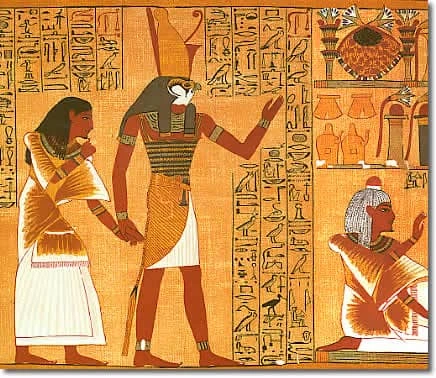
The stone engraving, a decree from King Ptolemy V, features three scripts: Egyptian hieroglyphs, Egyptian Demotic script and Ancient Greek. By comparing the pictorial decree to other known written languages, archaeologists were finally able to decipher the ancient hieroglyphs uncovered across time.
Just as the Rosetta Stone unlocked the secrets of Ancient Egypt, translation and common understanding are key in today’s global society. According to K International, translation can make or break a brand now more than ever before—all because of the e-commerce market. Since 2007, global online sales have increased 17%, and China is now the largest global consumer of luxury goods—25% of all sales.
While words and phrases may vary, images are universally understood around the world.
Maps
Maps were one of the first infographics early people designed and distributed, and cartography has remained an integral science for thousands of years. From primitive maps drawn inside caves and the ancient maps of Babylon to the Age of Exploration’s changing maps and 21st-century maps of the universe, people draw diagrams to help them navigate the world.
The earliest-known maps don’t depict cities, roads or waterways at all, but the heavens above. Dots drawn within caves map out parts of the night sky and its constellations. Dots drawn inside a French cave more than 16,000 years ago map stars as seen by ancient Europeans. The oldest atlas ever discovered, the Dunhuang star atlas, was created on an ancient Chinese scroll almost 1,400 years ago.
The earliest-known map representing the natural landscape was a crude representation discovered in the Czech Republic and has been dated to 25,000 B.C., and ancient Babylonians were already using accurate surveying techniques by 600 B.C.—although their view of the world was limited to the known environment of the time: a circular area surrounded by water.
Regional maps retained the primitive qualities of the Babylonian Map of the World for centuries, but by the end of the medieval period, Europeans were mapping their nautical trade routes using accurate navigational directions.
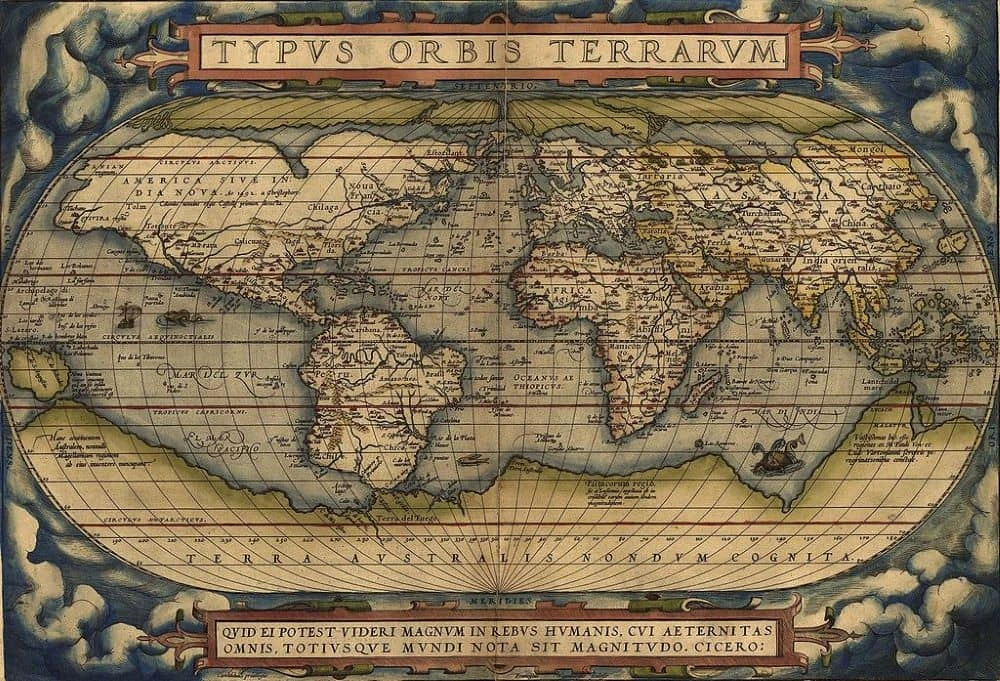
With the discovery of the Americas, Europeans’ interest in mapping piqued as nations struggled to control new lands and resources. The first-known cartographic representations of the Americas—as well as Europe, Asia and Africa—were designed by Spanish cartographer Jean de la Cosa, who sailed across the Atlantic with Christopher Columbus. Were it not for him and a handful of other Spanish and Portuguese explorers, the New World would have remained in darkness, discouraging the settlement that followed.
Even today, maps are one of the most common forms of infographics. Easily-recognizable locations form the basis of many efficient infographics that instantly convey a message. For example, when Fractl needed to create an infographic that was not only timely but could appeal to a large audience, it chose to map the hometowns and locations of 75 Marvel characters. The infographic was highly effective, and the map was featured in 365 publications.
“Maps are great for compiling a lot of information into a single graphic,” explained the map’s designer. “When you look at a map of the United States, you are effectively viewing 50 different data sets at once, but because we see maps all the time, the mind can easily absorb the information being presented.”
Early charts & graphs
Throughout most of human history, data visualization was limited because data was limited. Then, thanks to various sciences, scads of information—about demographics, economics, geography and weather patterns—emerged. And people needed a way to more easily analyze all this information.
By the end of the 18th century, most charts used today—histograms, pie charts, bar and line graphs—were already in use, introduced to the world in William Playfair‘s 1786 publication, Commercial and Political Atlas.
A Scotsman schooled in drafting, Playfair decided to use his skills to illustrate economic data. At the time, such information was commonly represented in tables, but Playfair transformed the data into infographics. In one famous line graph, he charted the price of wheat against the cost of labor, countering the popular opinion that wages were driving up grain costs and demonstrating that wages were, in fact, rising much more slowly than the product’s cost.
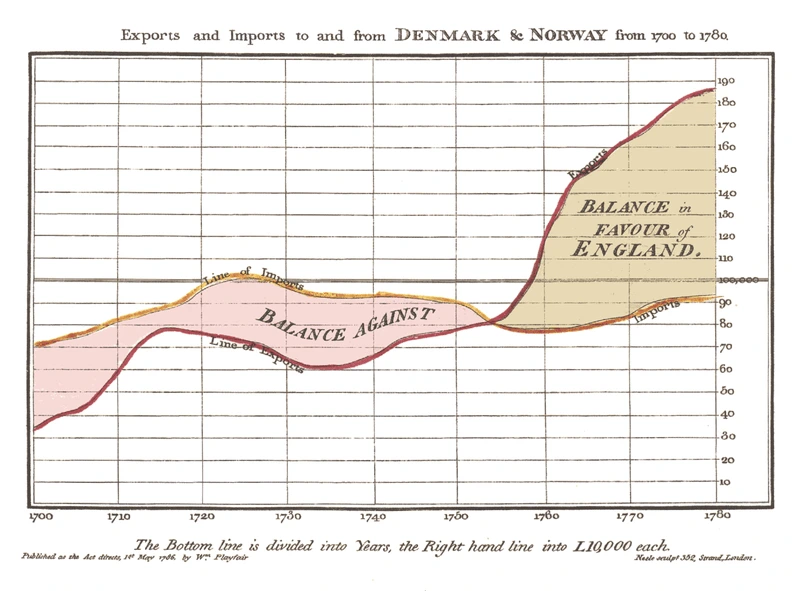
Playfair held a keen understanding of data visualization for his time, and he speculated that the brain can process images more efficiently than words. He argued that good data visualization is about “giving form and shape to a number of separate ideas, which are otherwise abstract and unconnected.” According to Playfair’s writings, data should “speak to the eyes,” because they are “the best judge of proportion, being able to estimate it with more quickness and accuracy than any other of our organs.”
Political diagrams
One of the greatest social issues of the 19th century, slavery was the subject of one of America’s most historical infographics. After the southern states seceded in 1860 and 1861, Union military leaders needed a strategy to invade Virginia.
Meanwhile, the federal Coast Survey department produced a map of Virginia that would prove pivotal in the Civil War. Based on data from the 1860 census, the map depicted slave populations in each of Virginia’s counties, one of the first to represent population with shading—the darker the county was shaded on the map, the more slaves were held there.
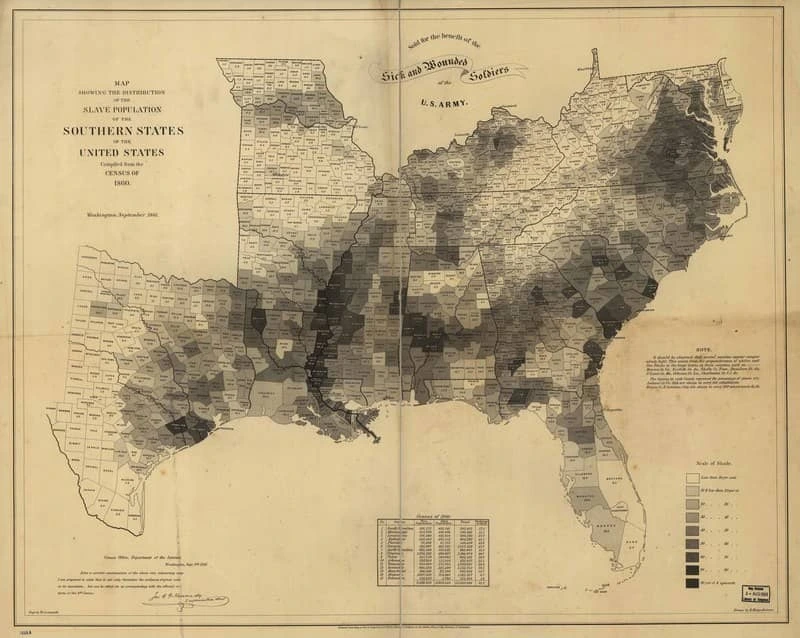
By examining the map, it immediately became evident that eastern Virginia was a slavery hotspot, while the western portion of the state was relatively slave-free. Therefore, Union forces deduced that Virginians in the western counties would likely fight for slavery less ferociously, and they might even change teams.
“It was a breakthrough map,” noted Susan Schulten, University of Denver historian and author of “Mapping the Nation.” “It was an attempt to influence how the government saw the nation, and how the military understood it. It drove Lincoln’s attention to where slavery was weakest.”
Later, when the U.S. Coast Survey produced another map that charted slave density across the Confederacy, President Lincoln consulted the infographic throughout the remainder of the war, relying on it to understand in which areas Southerners would be more and less dedicated to a fight.
Political maps and diagrams continue to influence public policy today. Although the United Nations High Commissioner for Refugees consists of an 8,000 person staff that collects enormous amounts of data on global refugee displacements, the organization has struggled to communicate its information in a meaningful way.
In a new approach, the agency commissioned an infographic to narrate 40 years of refugee data. The interactive graphic highlights where and when refugees emigrate and tells the complex stories of political, social and economic turmoil that lead to each displacement.
Since launching in 2014, the project has accrued more than 5 million page views, has been shared on Twitter to millions via humanitarian organizations such as Amnesty International, and it was even awarded a Gold Medal for Interactive at the prestigious Molofiej 22 Infographic Awards.
A message from Earth
The 20th century saw the advent of mass media, and publications quickly adopted infographics to efficiently convey complex information and data. As programming languages were born, computer-generated graphics pictorially depicted massive amounts of data, advancing all aspects of science and technology. But throughout all the advancements in visual storytelling, one thing remained clear: infographics are a universal language.
Thus, when NASA decided to send a message from mankind to extraterrestrial lifeforms, it determined an infographic would most likely do the job. In 1972 and 1973, aluminum plaques were placed aboard the Pioneer 10 and 11 spacecraft, each depicting a pictorial message. Each plaque featured simple drawings of a nude male and female human, as well as symbols designed to indicate the Sun’s position in the galaxy.
The Pioneer 10 and 11 spacecraft were the first human-built objects capable of enough velocity to escape the solar system. NASA turned to world-famous cosmologist Carl Sagan to design the ultimate message in a bottle. One diagram depicted the chemical makeup of hydrogen, the most abundant element in the universe.
The drawings of the humans included a diagram that pictorially calculates their height compared to the spacecraft, and the man’s right hand is raised as a sign of good will. (Of course no person on Earth can know if extraterrestrial intelligence will identify that raised hand as a peaceful symbol, but scientists hope the gesture is universal.)
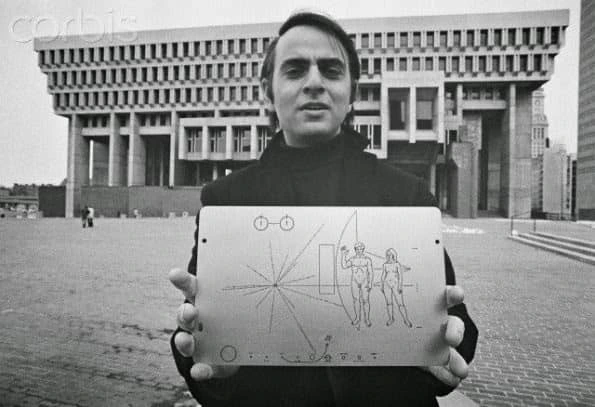
A radial pattern on the plaque consists of 15 lines emanating from a center origin, indicating the distances of pulsars to the Sun, allowing recipients to pinpoint the location of launch in space and time. Finally, a diagram of the Solar System was inscribed on the plaques, depicting the launch location and trajectory of the two spacecraft. With any luck, the universal languages of mathematics and visual storytelling will tell unknown intelligent life that we are here, and we come in peace.
We most certainly live in an era of data visualization. Graphics charting everything from election polls to physical activity are found everywhere from the newspaper and television to the computer and smartphone. But in order to understand the elements of a successful infographic, we must remember that visual storytelling isn’t a new phenomenon, and the elements that worked for the ancients are still at play today.
Ready to make history with your data? Try Lucidpress to create gorgeous infographics for your brand—no expert design knowledge required.
A good content marketing strategy should explain why a company is making the marketing decisions that it is. Anyone reading should see why content marketing is being used, why certain decisions are being made, and why the company wants the image it’s pursuing.
Unfortunately, since content marketing varies as widely as the brands using it, myths and legends about how to make it work still abound. With 70% of B2B brands planning to use content marketing next year, these myths will continue to spread into a new generation of marketing campaigns. That is, unless we marketers agree to let these myths go the way of Bigfoot and Nessie.
New to content marketing? Start off on the right foot with Lucidpress.
Myth #1: Trending topics will always work out
Let’s go viral! There’s this idea that the best way to market a brand is by latching onto an outrageous topic which will immediately grab the attention of anyone around. (Oh look, a shiny thing!) While interesting topics are undoubtedly fun, they’re not always a surefire win. Marketing topics should always coincide with the company’s message and values. Remember that trending topics rarely remain so, and one can quickly change from being adored to being annoying. Sigh—crowds can be so fickle. But setting smart goals for your content, whether it’s brand awareness or targeted selling, will help you keep the company’s mission as your North Star.
An example of doing this the right way? Our sister brand Lucidchart created this hilarious video about dogs (erm, that is, “doggos”) that is not only timely Internet humor—it also shows off what you can do with the product. In this case, the topic and the brand fit neatly into the middle of the viral Venn diagram, and the video has been a huge success.
Myth #2: Keywords are the most important factor
One particularly pervasive myth is that marketers should trust keyword data above all—even over the intentions of potential customers as shown by their search queries. In order for keywords to work at their best, they must be focused on the customer’s journey. SEO tools will only get you halfway there. []
Use keyword data to inform your content marketing strategy, not determine it outright. Think about why someone would search for a particular keyword—and what questions they have that aren’t being answered by existing search results. Match individual keywords to the different personas your brand targets so you can speak to the audience who most wants to hear what you have to say. All of this should lead to more interesting, relevant content that’s more valuable than simply writing about a keyword.
Note: Another myth surrounding keywords is that using them removes any creativity from writing altogether. Not only is this pretty lazy thinking—it actively undermines content writing as a means of marketing the business. SEO and content marketing should work together to support one another, and neither should become too dominant in your strategy. This leads us to our next myth…
Myth #3: All storytelling, no selling
Content marketing is a form of marketing (shocking, I know) which uses storytelling to draw in prospects and excite them about your brand, product or service. Around half of marketers admit to focusing more on the creative work than on measuring the results—which means they’re missing an opportunity to bring themselves into closer alignment with the needs currently driving their customers. You can tell great stories all day long, but if your audience isn’t being moved down the funnel, it does very little for your brand’s bottom line.
To an extent, content marketing can be considered a form of brand building. People often remember the content of a marketing campaign more easily and affectionately than they do the products and services on offer. This has contributed to the belief that storytelling is more important than selling, when in reality they should be equal. The content marketing should enhance your brand’s offerings—not the other way around. And speaking of brand building…
Myth #4: Content marketing is separate from brand building
We touched on this briefly in the previous section, but there is a pervading myth that brand building and content marketing are separate disciplines. In today’s world, they intersect. Brand building is accomplished through marketing; the specific nature of content marketing makes it even more useful to growing brands.
Brand building and content marketing are best mixed together because they build trust and good rapport between a brand and its followers, while simultaneously helping the brand become more visible and easily recognized. Combining the two results in consistently well-branded content that contributes to a brand’s image, reputation and conversion funnel.
Myth #5: Your content should only be hosted on your website
Content marketing can cover a variety of mediums and senses. However, many brands miss out on exciting possibilities and partnerships by keeping all of their work on their own sites. Podcasting, vlogging and guest blogging open doors to entirely new audiences who might not have interacted with your brand otherwise. You can even look for new channels to help distribute your content. For example, we’ve had success with a Lucidpress publication on Medium because it plugs us into active reading communities who are interested in our niche.
Key takeaway
Content marketing has become a popular branding strategy, but it’s still shrouded in a variety of myths which make it less successful than it should be. Toss these myths by the wayside and use these tips to connect with loyal brand followers and new audiences.
Ready to get started? See how Lucidpress can streamline your content marketing efforts today.
A friend of mine says she could not help but be swayed by what people were saying about the importance of social media for increasing sales. Some people kept rhapsodizing about how they were able to achieve rocket sales by establishing brand recognition and strengthening their brand’s presence in social networking sites.
So this friend opened an account on Facebook, created a blog, squeezed in a post here and there, and sent out newsletters to introduce her product—and generated no significant increase in sales at all. Why?
Related: 7 serious social media mistakes brands still make
The truth about the use of social networking sites
My own research shows that I should not rely on luck to sell my brand—not even when I use social networking sites. I cannot expect mere presence in social networking sites to work magic and automatically land me great sales.
How can I successfully market my brand in social media? How can I increase customer conversion rate?
I looked into case studies and marketing research. I read up on what the technical marketing experts had to say. Here’s what I found.
Put your brand where your target market is
Alex Chris is an author and Digital Marketing Consultant. He is an expert in Internet Marketing and SEO. He says that based on updated surveys, Facebook dominates the social media scene today. A massive 1.79 billion people actively use the site monthly.
Alex says that you have put your brand where your target market is. With 60% of people on the Internet using Facebook, there is no greater tool to promote your brand, find new customers and gain a loyal following.
He suggests that you create an optimized Facebook page, add friends to your personal Facebook page, and get as many “likes” as you can. He suggests putting a “like” box in your website. You have to put this “like” box in a conspicuous, readily accessible spot.
Create relevant content
Alex and a great number of other marketing specialists, say that it is not enough to create social presence. You have to create high-quality content for your followers. If you are able to do this effectively, you have a greater chance of turning your followers into constant website visitors, and eventually to customers.
Connect with your audience before selling your product
Kristen Matthews is a creative digital strategist. As an influencer marketing consultant, she has worked on a variety of case studies with innovative brands.
A Huggies case study highlights the need to create not just any content, but one that emotionally connects to your target market—even before you push your brand.
Speak, listen & respond to your audience
Brittany Berger heads the Content & PR Division of Mention.com. She says that when you send out newsletters as part of your marketing campaign, you speak directly to your target market.
Make your audience feel that you are listening to them. You create positive vibes when you respond as soon as you can to any queries or points that they want to clarify.
Do not be too promotional
When I create posts, I am representing a vision, specific objectives, and explicit principles. I am also creating awareness and recognition of my business brand.
I am not simply selling. I am informing and educating my audience.
If I become too promotional and focus exclusively on trying to sell my brand, people may see my posts as self-serving. I may lose my audience.
Online entrepreneur, writer, and founder of UpFuel.com Chris Guthrie agrees that you have to find the right blend of marketing and educational values. The right mix provides true value for your customers. It will also give you the opportunity to sell your brand.
Cater to your audience
I have a website on social media. I have a responsibility to my followers. I have to come up with content that has to do with my particular niche. I have to create posts that are engaging and useful to my audience.
If I want to maintain a loyal following, I have to go out of my way to share relevant posts in a variety of interesting ways that include written articles, videos, info graphics, images, and charts.
I want my followers to feel that they are important to me. If I send out e-mail, I have to respond to queries as soon as possible.
If I do not think my content through and create posts that do not offer anything substantial, I may end up hurting my business reputation instead of helping spark brand awareness.
In a nutshell: what to do
- To sell a product or service to people, build a strong social presence.
- Elicit interest. Build trust.
- Provide appealing and relevant content.
- Use storytelling effectively.
- Find out your audience needs and wants. Tell your story based on these.
When you are able to do these, you will be able to generate more traffic to your website. You will be able to create a bigger following. And you will be able to enjoy a higher conversion rate.
Ready to drive more leads with social media? Grab a copy of our free eBook: How to adapt your brand to social media
How many advertisements do you remember fondly? Probably not that many, considering we’re bombarded with content on a daily basis.
But the ones you do remember seem to creep into your subconscious. It’s like a catchy song that you can’t help but remember.
Good visual content has a lot to do with psychology. Appealing to human emotions will influence people to react to your ad a certain way.
Related: 4 ways to increase conversions with visual content
Corporate Executive Board did a survey on this in partnership with Google. They contacted marketing leaders, vendors, consultants, and over 3,000 B2B buyers to understand the rise of emotion-driven content marketing.
In their report From Promotion to Emotion, it’s revealed that 86% of buyers believe that brands are all selling the same stuff. Unique value propositions are not turning out to be… not so unique. But, brands that connect with customers on an emotional level will see 2x more impact than those trying to sell based on functional value alone.
If you’d like to tap into that influence, here are 7 emotions that drive people to connect with brands—and real-world examples of each.
1. Urgency
Even when your customers want your product, they can still be hesitant. Maybe they feel like they can buy from you any time, so why spend money now? Later, they say, later.
This is when you need to infuse a bit of urgency. Add a timer or an expiration date in your email newsletter or video ad, and buyers will take the cue. No one wants to miss out on a good deal.
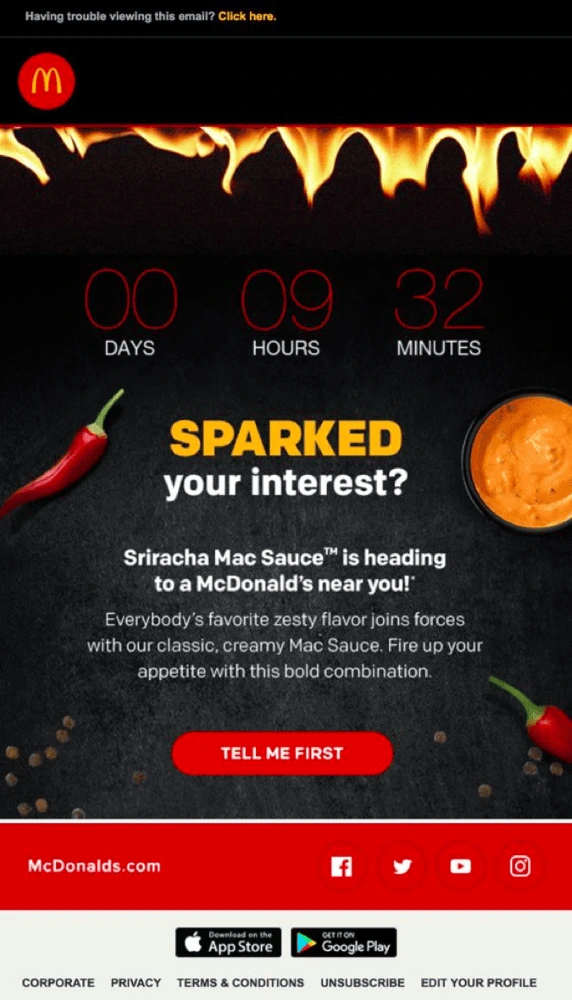
Source: McDonald’s
Big retail & e-commerce brands use urgency (tick-tock) to promote instant consumer action or purchase decisions. However, make sure you have a good reason for incorporating urgency in your offer. For example, countdown timers are often used for festive occasions or limited product runs.
Urgency even works better when you pair it with scarcity. Use phrases like “limited stocks available,” “limited tickets,” or “first come first serve.”
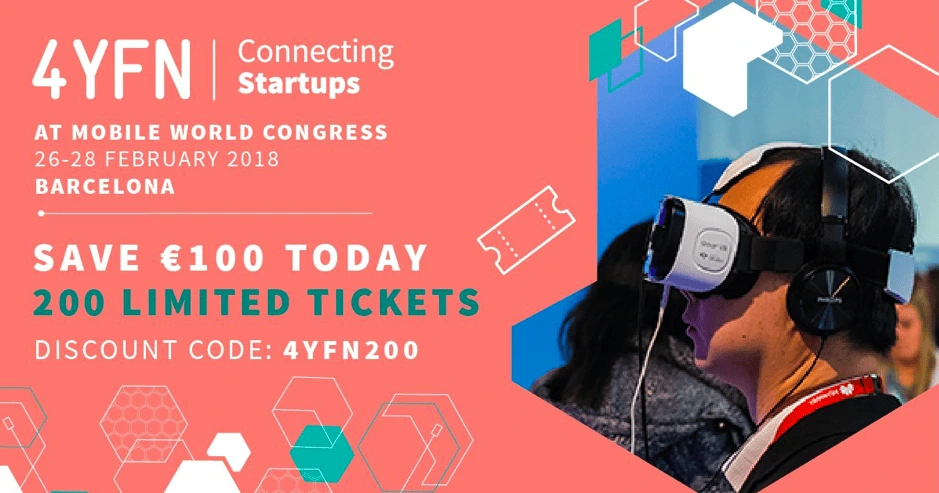
Source: 4YFN
A similar psychological catalyst is FOMO. Fear of missing out is a social worry that if you don’t participate in time, you won’t be able to enjoy the same rewards other people are reaping. One study reveals that around 69% of millennials experience FOMO when they can’t attend a popular event. You can use that fear to your advantage.
2. Desire
Desire is a powerful emotion. Almost every action we take and purchase we make is driven by desire. Many brands channel desires into their visual ads to capture an audience’s interest.
One way to do this is through before-and-after images. Olay took this concept even further with their “Identical Twins” campaign, where one of the twins uses the product and the other does not.
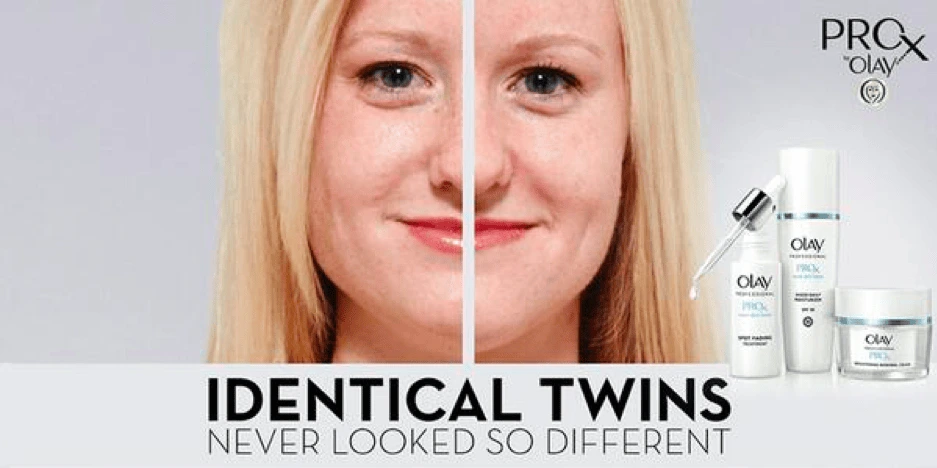
Source: Olay
But, before-and-after images don’t have to be about skin care or weight loss products. Check out this GIF, for example. SiteFlood creatively uses the before-and-after concept to show prospects what kind of results their service delivers.
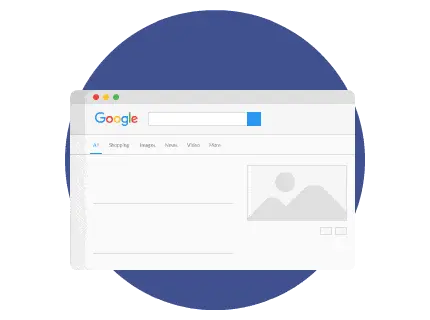
Source: SiteFlood
Similarly, most explainer videos use a “problem-and-solution” format to identify prospects’ needs, then provide a solution to help them fulfill that desire. This video explores the desire to live in the Caribbean, the problems one faces to achieve this, and the solution.
At Lucidpress, we used the same animated format to introduce our brand management platform—complete with white knights, bodyguards and Mama bears.
3. Compassion
We’re social creatures, and that’s frequently reflected in our behaviors and reactions. We care about our family, our friends, and even random strangers. Doing something for others makes us feel good.
Thai Life Insurance produced a series of heart-warming videos that showcase the sentiments of altruism and care, even in adversity. In the end, it’s wrapped up nicely as part of the brand message.
Attaching your brand to feelings of love, care, attachment, altruism and charity can give your visual content a strong emotional pull.
4. Delight
Humor provides more delight than almost any other emotion, but it can be difficult to pin down and execute well. You must know your audience and their sensibilities, so you don’t end up missing the mark, falling flat, or even offending them instead of making them laugh.
Old Spice has perfected the art of appealing to its demographic in a variety of fast-paced, cinematic ad campaigns. It’s delightful, humorous and exciting to watch.
5. Personal care
Advertising is everywhere, and it rarely feels like an ad is speaking directly to you. In this constant deluge of content, personalization is valued more and more. If you want my business, make me feel special. Show me that you care.
Starbucks is no more “special” than any other coffee brand, but they show their patrons that they care. It’s a brand synonymous with warmth, comfort and convenience, and it’s easy to make it your own.
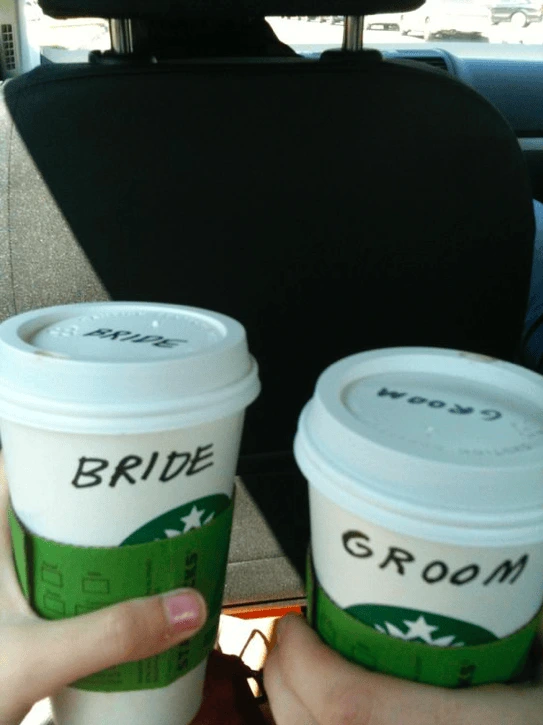
Source: Tumblr
Starbucks proves that it cares about the individual experience by providing a casual meeting space, a work environment, a place to relax, free Wi-Fi and other comforts. Perhaps more importantly, they ask each customer for their name and write it on every cup of brew they order.
In some ways, Starbucks has come to resemble a hospitality brand without actually being one, simply by extending a comforting personal touch.
Introducing customization or personal touches to your brand can make you far more appealing to your audience, because they will feel special and cared for.
6. Trust
Your customers have their own personal tastes, values and opinions. Likes and dislikes. Movies or music that they love or hate.
It turns out that personality will largely determine a customer’s shopping behavior. They buy products and experiences that either reinforce their personality or help them get closer to who they want to be.
So it stands to reason that if you associate your brand with a celebrity they like (or want to be like), that would give them a reason to trust in your brand and buy from you.
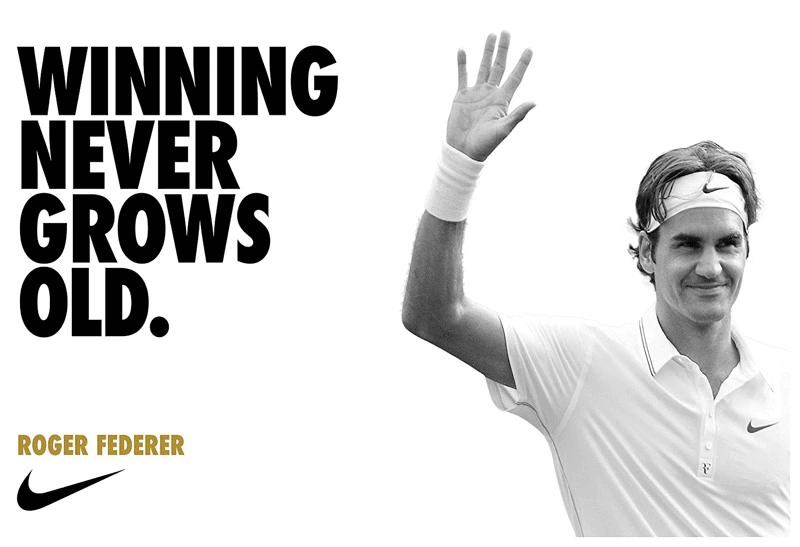
Source: Nike
This is why brands hire celebrities and influencers to drive brand awareness and adoption.
The idea here is to create an image your target customers will like or aspire to. Do some research on who your customers are (or who you want them to be). Once you’ve sketched out a buyer persona, including their likes and interests, you can solidify brand messaging that speaks to their personality and values—and earns their trust.
7. Motivation
Participating in social causes you believe in can be very gratifying. But, that gratification often comes from harrowing personal experiences, or at the very least, a visualization of others’ worst experiences.
CoorDown, an advocacy group for people with Down syndrome in Italy, made a beautifully profound video featuring people with Down syndrome delivering their own messages of reassurance to a future mother who’s worried about what kind of life her child will have.
The video is a rollercoaster of emotions that culminates in the promise of a happy, fulfilling life.
Find a cause that speaks to your brand values or to your employees. You can draw on personal experience or the hardships of others to create stories that inspire hope and motivation for your audience.
Key takeaway
Emotions are fundamental. You don’t need a PhD in psychology to figure out what makes people tick. You just have to do some research on your buyers. Draw up a buyer persona, then create visual content that will resonate with that audience.
When shopping for a new home, real estate buyers want to know what it’s really like to stroll through the kitchen, stand on the balcony or lounge in the backyard. Since they’ll be investing years in a house or apartment, they want to imagine themselves in the space before they contact a real estate agent. Next to physically being there, listing videos provide the best experience for persuading buyers that their dream home is just a click away.
Related: Guide to an effective real estate listing marketing strategy
Although listing videos are big in real estate marketing, few real estate agents actually take advantage of the power of video to immerse and move buyers to purchase. The National Association of Realtors found that 85% of buyers & sellers prefer to work with a real estate agent who offers video marketing… but only 15% of agents actually use video to market their listings.
High demand and low supply gives those real estate agents willing to invest in video an edge in finding potential buyers. With a little practice, it’s easy to create real estate listing videos that’ll get your properties moving.
Planning shots in a listing video
You should already be familiar with the property, so make a shot list of all the rooms, outbuildings, porches, pergolas, and other pertinent features you want to capture beforehand. Focus on the interior first. Plan your shots like you would plan an actual walkthrough with a prospective buyer. Start with the entryway, then move into the living room or the next logical place. This will make the final edit feel natural as you take the buyer from shot to shot.
As a general rule, you’ll want your video to contain around 75% interior shots and 25% exterior. You don’t need to show every nook and cranny of the property. Concentrate on the most visually appealing and emotionally moving parts—the selling points.
One must-have is the “hero shot” that will be the climax of the story you’re telling. It may be a beautiful vaulted ceiling, an indoor pool or a breathtaking mountain view from the backyard. Whatever it is, your hero shot should be the star of your listing video, and you’ll want to place it where it has the biggest emotional effect.
Pro tip: Take still photos from all the vantage points you use to shoot video. Use the images to create a storyboard of your video. The images will work as reminders and guides for the best angles and spots to put your camera. You can import all of your images into a storyboard template and organize them how you want.
Estimating video length
Your video’s length depends on the size of the property. A video for a small, 2-bedroom apartment should be shorter than a sprawling 6-bedroom estate with 10 acres. To estimate length, take the number of planned shots and multiply them by 5 seconds per shot. That’ll give you an approximate run-time.
Ultimately, your video’s length should be dictated by the shots that you capture. You don’t want to rush past the selling points of the property, but you also don’t want to induce yawning. Remember, it’s a video, so prospects can play it back or press pause for closer examination, so err on the side of shorter. For quality control, enlist friends and family to critique the video before you publish it.
Using professional video equipment
Editor’s note: This section contains links to products on Amazon.com. These links are provided for reference only, and should not be taken as endorsements for any of the brands or products listed. Also, Lucidpress does not receive any payment or commission from sales of these products.
At minimum, you’re going to need a camera, a tripod and some editing software. Many of today’s smartphone cameras work well enough to produce decent video footage, but a DSLR camera is a better choice for quality and flexibility.
A fluid head tripod is a must-have. A good tripod keeps your camera steady and lets you produce smooth, fluid movements. Jerky camera movements distract viewers and make your videos look amateurish.
If you’re using a DSLR, buy a zoom lens with a focal length around 17mm-40mm or 16mm-35mm. Wide-angle lenses like these will capture a good chunk of a space without distorting or barreling the image. If your image is too rounded at the sides, your lens is too wide.
For basic video editing software, many operating systems already come with free versions, like iMovie or Windows Movie Maker. These programs are easy to use, but they’re also limited in their color-correction abilities, number of transition choices, and audio enhancement capabilities. To up your post-production game, invest in professional editing software like Final Cut Pro or Adobe Premiere Pro. Both come with powerful video tools but are harder to learn.
If you plan on capturing dialogue with your video, snag a lapel mic or shotgun mic and an audio recorder. However, recording dialogue is a difficult task, especially for beginners. It’s better to find stock music that creates a powerful, emotional effect in the background. Besides, you should assume that a large portion of people will watch your videos on mobile phones with the sound muted.
Pro tip: Handheld gimbal systems aren’t cheap, but they offer the ultimate in flexibility, compactness and convenience, letting you capture smooth, professional video without a tripod. Gimbal systems keep your shots steady even when you’re walking around, so you can create sweeping shots in any direction that look like scenes in Hollywood blockbusters.
Lighting the scene
You can go all out and invest in a basic photography lighting kit to make your listing videos look their best, or you can just shoot on a nice, clear day. Most of the rooms you’ll want to feature will be well-lit on sunny days, so take advantage of nature and show your properties in their true light.
For exteriors, shoot during the “golden hour,” that time just before sunrise or sunset when the sun is in the horizon and casting warmer colors. The warmer light makes exteriors more attractive.
Pro tip: Some of your interior lighting will come from tungsten bulbs, which produce a warmer color than daylight or fluorescent bulbs. When possible, replace tungsten bulbs with ones that have a color temperature of 5500K. When you keep a consistent color temperature in your scenes, it’s easier for your camera to maintain its white balance.
Prepping the area
Before you start shooting, take your shot list and walk through the house. Stow away any distracting objects. If the house is unoccupied, this might be stuff like cleaning supplies, drop clothes or painting equipment. If it’s still occupied, put away any clutter on kitchen bars, pick up dirty clothes on the floor, and take down family photos. If possible, also take down any mirrors that would show your reflection while shooting. Turn on interior lights when appropriate and open window coverings for better lighting.
Pro tip: Don’t shoot towards an open window. Your camera will struggle to balance the intense brightness of the window with the relative darkness of the interior rooms, and your images will suffer. Shoot with the camera pointing away from open windows, or cover them.
Shooting the video
You’ll only need two to three shots per room. You’re not shooting a film, so just get the best angles in the best lighting and move down the shot list.
For interior shots, get a few good tilts (up and down movements) and pans (left and right movements) of each room. If you have a tripod slider or steadicam system, also grab a few dolly shots, moving slowly from left or right. Multiple takes of the same space gives you more choices during editing. You don’t want every shot to be the same pan from left to right. That bores viewers. Instead, mix it up and provide them with a variety of views to hold their interest.
Set up your tripod so the camera is at waist height, not at eye level. Interior spaces look more attractive from a slightly lower perspective. Any pans, tilts or dollies should be slow and smooth.
For a pan shot, start the camera pointing at one side of the room, then use the tripod handle to slowly move it to the other side. Start and stop each camera movement with a five-second pause. This will create a “head” and “tail” for the shot, giving you some room to work with when editing them together.
For exteriors, you’ll need two to three shots that show the front and back yards, any separate structures, and any hero shots. But, don’t just piece together the whole property through multiple images. Prospective buyers want to see the entire home within the context of its surroundings, which could include the lawn, nearby structures or a body of water. Get at least two shots that show a more encompassing vantage point.
If you include shots that are static, use them sparingly. The viewer’s attention is captured by movement and color. You’re making a video, not painting a picture. Keep the action going.
Pro tip: If you want Hollywood-style shots that will really wow house hunters, consider renting an aerial lift for the shoot. These professional lifts get up to 60 feet above the property to capture high-angle aerial shots. They’re safe, easy to set up, and give you the platform to grab dramatic footage that will make your listing stand out.
Video storytelling in real estate
To really sell a piece of real estate, you have to connect with viewers on an emotional level. Good cinematography and editing is key, but without storytelling and music, you’re just presenting moving images. Storytelling can involve following a character as they move around the home doing domestic things, as in this listing video from Savvy + Co Real Estate or this one by The Boutique Real Estate Group.
But, storytelling doesn’t have to include actors or characters at all. It can simply suggest feelings and emotions that connect with viewers. For example, if the residence is occupied, use the existing furnishings to tell the story of the absent individuals who inhabit it.
That doesn’t mean going into personal details, but you could suggest how the spaces are being used by including a close-up of a child’s toy sitting on a dresser, or a porch swing as it moves in the wind. These personal touches tell the story of lives being lived in the home. Such images connect with viewers, letting them imagine their own lives there, turning a house into a home.
Pro tip: If you really want impressive exterior shots, consider investing in a drone. Every year, drones get smaller and cheaper, and the image quality for prosumer models works great for these projects. You could even use them to shoot interiors… if you’re brave enough. They’re challenging to learn, and you can’t just fly them anywhere (per the FAA guidelines), but their sweeping movements and intense aerials create emotional connections with viewers.
Related: Real estate video marketing — The ultimate content marketing tool
Publishing listing videos
Even if you produced a video that could make the list of top 10 stunning real estate listing videos, it won’t matter if no one sees it. Video hosting platforms like YouTube or Vimeo are the best places to store your listing videos. While YouTube provides unlimited storage, Vimeo only lets you upload a specific number of videos at a time. Both let you embed videos on your own website.
After uploading your real estate listing videos to YouTube or Vimeo, optimize them for search engines. Here are some things to include:
- Descriptive titles. Don’t just call it “Farm House Video.” Include more descriptive words like “Property at 1132 N Elm St.”
- Video descriptions. Include a short explanation of the video and property. Add your name, business address and website.
- Free or licensed music. Use either public domain music or licensed stock music so YouTube doesn’t flag your videos.
- Suggested videos. Set your channel to display “suggested videos” so viewers can see your other properties.
Pro tip: Hosting platforms are only one avenue for distribution. Digital lookbooks are mixed-media catalogues made from still images and videos that can showcase your properties in fuller detail. You can create and host them directly on the web for free.
Key takeaway
While these tips are helpful for getting started, rising above the competition means upping your game over time. Listing videos are getting less expensive to produce as equipment and software prices come down. Staying above the fray means finding creative ways to engage potential buyers. The best training is to stay current with video trends in the real estate space. They’ll show you where the benchmark is, and you can use your creativity and skills to exceed it.
Visual representation of your brand matters. Learn how to protect and elevate your real estate brand in this branding essentials guidebook.
Why did you start your business? We’re pretty sure it wasn’t because you wanted to sell one product every blue moon, or because you don’t care about the services you provide.
Let’s be honest: We all want to make a difference, and we want to be recognized for delivering exceptional experiences. Without a positive reputation built on genuine feedback from satisfied customers, you can wave goodbye to local or worldwide recognition.
You’ve probably noticed that bigger brands tend to have this nailed down. You see that red-and-white logo and instantly recognize Coca-Cola, or that blue background and yellow text belonging to IKEA. Even those multi-million-dollar brands had to start from somewhere. How on earth do you create something memorable—something that a customer will recognize and trust right away?
One answer is product packaging. Packaging is the first thing someone will notice on a shelf or when they receive a delivery to their home. The more they relate to it, the more likely it is that they’ll purchase or recommend it to others.
However, before you reach stardom, there are several ways to increase the chance of getting noticed. From the way you speak about your brand to how you package your products, here’s how to tell a memorable brand story.
Write your story early on
Before you get too far in with your products, button up your brand story. Keep in mind that a business is generic and faceless without its history, values, mission, vision and personality.
To refine the story you’d like to convey to the public, ask yourself some of these questions:
- What beliefs drive you and your company?
- What makes your business and product unique?
- How would like to see the business a few (or many) years from now?
- How can your products change the lives of your consumers?
Once you’ve answered these, it’ll be easier to focus your brand story—and that story can inform the choices you make with product development and package design.
Give your product a persona
Don’t think of package design as just a way to deliver your product. To truly convey a message, a story or a brand identity through your product, you should think of it as a person. That’s right, just like in marketing, you’re creating a persona—but this time, it’s for your product. This is where brand personality comes in.
By thinking of your product as a person, it’ll be easier to design packaging that reflects the brand personality and resonates with your target audience. Potential buyers will notice that authenticity and gravitate toward the product before they even realize what it is. They’ll know that it’s been designed for them.
Colors draw in the customer
Without color, the canvas is blank. A customer won’t look twice at your product if it doesn’t stand out to them in the first place.
Think about what feelings you want someone to get from your product. Should it make them feel like having fun, like a quirky craft beer? Should it make them feel cared for, like a health-related product? Make a list of how you want your product to make customers feel, and find ways to translate that to your packaging.
It can be easy to match colors with feelings: calming blues, bright yellows, passionate reds. A customer could be drawn to a certain color, depending on what they’re looking for. Colors can help you convey your brand identity, as well.
Who is your audience?
As with any form of marketing, keeping your audience in mind throughout the process is a must. Who will buy your product, and what product packaging will appeal most to that particular audience? Think about colors, shapes, sizes—even the wording on each individual product’s package.
Customers often read the text on a product to reinforce their purchasing decisions in their minds. [ ] For example, younger audiences prefer brighter, eye-catching colors with quirky shapes and blocky fonts. Older audiences who purchase luxury products prefer colors like black and gold, combined with elegant fonts and sophisticated language. It’s all about knowing who you’re selling to. Once you do, the rest will come far more easily.
Delivery boxes
No matter the size of your business, it’s not only important to have great product packaging on the shelves. When a customer makes a purchase online, they should feel the same excitement for their delivery as they do for the product in the box.
Depending on the size of your business, you might need to batch-order boxes for delivering your products. Businesses often need extra help to meet customer demand. BCS box-making machinery can help to create quality, durable boxing that makes an impact.
Consider sprucing up your boxes with custom-branded stamps, tape and delivery labels—as well as adding extra protection for your product inside each box. Think about padding, branded freebies, and money-off coupons as ways to encourage repeat purchases from your customers.
Logos & graphics
If you’re not including your logo and other branded imagery on your packaging, how do you expect a customer to know it’s you? When people see a familiar logo, they know almost instantly whether they trust that business enough to buy the product.
Graphics, although not always brand-specific, can often make or break your product packaging. If you’re selling healthy products, you’re more likely to succeed with a green, leafy design. Think about what works, and use a bit of common sense to gauge how you want the product to come across.
Product blurbs
Your brand story is important. So important, in fact, that many businesses make space on their product packaging to write a little about how their business started. Other companies write about their values, such as Lush and their natural, eco-friendly approach.
You can probably think of a few other examples of brands who do this well—which means they’re doing things the right way. The care and effort you take here will pay off when customers remember your story and take it to heart. Shoppers will appreciate an attractive design with an inspiring blurb more than one with a cut-and-dry description. Don’t forget that it’s often the packaging of a product that sells it, not just what’s inside.
Don’t over-design it
It’s easy to succumb to this temptation. In trying to make a product the most eye-catching or unique, some companies over-complicate the packing design. Sometimes, these products luck out and sell well, but they do little to build or reinforce the company’s brand.
Don’t get too carried away with embellishing your packaging designs. Stick with simple, clear concepts that your audience will easily understand. Often, it’s the most simple and well-thought design that wins out in the hearts and minds of customers. []
Be consistent
According to famous designer and author Robert Brunner, “Everything you do creates the brand experience. Ergo, design is your brand.”
Just as it’s important to maintain brand consistency in your marketing, it’s important to design product packaging that’s consistent with your brand’s identity and values.
We’re not saying you should slap your logo on everything. But you do need to design concepts that reflect your brand—concepts that could be informed by the logo, typography, color, etc. Even if your product doesn’t share the aesthetic characteristics of your brand, it should feel congruent with its values.
Invest in packaging
Don’t underestimate the power that packaging design can have on your brand. Because your packaging often sparks the first connection between a customer and your product, it’s often the first experience they’ll have with your brand.
On top of the time and money spent on product design, you should also carefully consider your packaging. Design packaging that stirs up emotions of excitement, joy, delight or amazement. Once you’ve created packaging that instantly connects with your customers, your brand awareness and recognition will benefit.
Key takeaway
An effective brand will help sell products and attract customers. If you want your customers to get excited about your new products before they’re even announced, build a strong brand using these concepts.
Bonus: Product packaging infographic
Want a few more tips and pointers on the importance of product packaging? Check out this data-packed infographic from our friends at Uppercut Box.
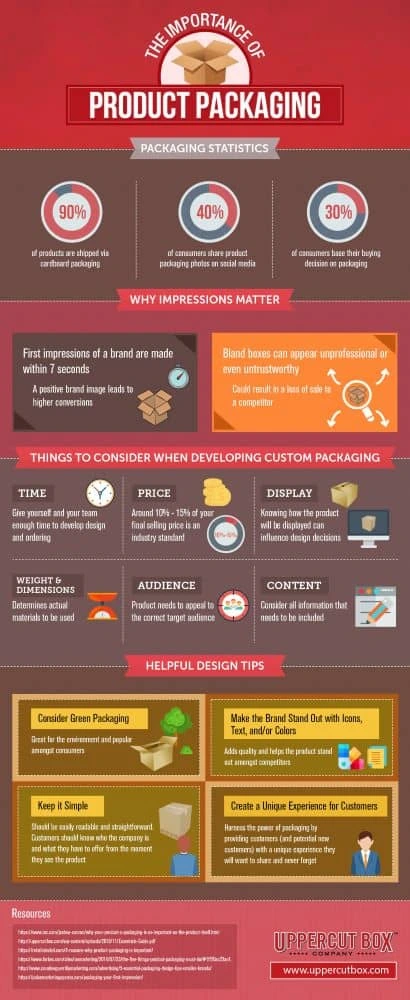
Why talk about sustainability?
You’re probably fed up with the terms “millennial” and “Generation Y,” but they’re still helpful when describing that particular group of consumers.
For example, one trend that keeps popping up is their desire to buy from brands brave enough to set standards of behavior and live by a set of principles.
Related: 5 content tactics to ignite brand engagement with millennials
I’m a millennial, and for the first time this year, I was able to go to my local zero-waste store and buy travel toiletries for my summer vacation. I even paid a lot more for the privilege and left the store with a fuzzy feeling and a huge smile. Does this sound unusual? Trust me—I’m not the only one in my peer group who looks for opportunities like this.
If you’re looking for more reasons to build your brand around sustainability—and examples of brands that are doing just that—read on.
Boosting that bottom line
If you want to show the market that your company is in it for the long haul, having a sustainability strategy is a case of when, not if.
We know that 75% of millennials millennials say sustainability is a shopping priority, more than any other group. [] Yes, we came of age during the Great Recession and aren’t the richest generation (hello Boomers), but we are getting wealthier. And, importantly, we are willing to pay more for things that matter.
The problem with sustainable business practices is the misconception that being good equals less revenue.
Even Forbes agrees that you can earn better returns from investing in good companies. If you’re not positioning your company to look after the planet and its people, you’re already behind. The time is now.
Leading from the front
Do you want your brand to be on the cutting edge, forming relationships with international audiences? Or do you want to be trying to figure out why your quirky social media campaigns aren’t getting the engagement they used to?
The United Nations are fully focused on achieving their Sustainable Development Goals by 2030, and your brand can be part of that through the work of the Global Compact division.
Of course, this is step one in the process. Your brand won’t survive on goodwill alone. It has to produce a steady profit to grow and spread your positive message further.
Step two is telling your story, integrating sustainability into your brand and making sure the entire company is on board and proud of the work you’re all doing.
Telling your “triple bottom line” story
If you’re not familiar with the triple bottom line, it’s the idea that your business should be measuring and reporting not just a financial bottom line, but social and environmental bottom lines, too.
This is how you truly integrate your business with sustainability. There are several ways to get started on this, but some useful resources are:
- B-Corporation. This is a framework any business can pick up and follow. It guides you on best practices for triple-bottom-line business plans, and you get a certification at the end.
- Global Reporting Initiative. The GRI is the go-to resource for sustainability reporting. Using GRI, you can easily figure out what you can report and how to report it.
- Integrated Reporting Council. Integrated reports are becoming increasingly necessary, bringing together financial and non-financial data in one place. It helps your stakeholders get a fuller picture of your company’s performance.
You can use these frameworks that are already created and layer them throughout your business. It’s a time-consuming process to get all of the data in place, but once you have it set up, it’s well-worth the effort.
What’s important to you?
The next part is understanding which issues are important to you and your audience. For smaller brands, your audience will include customers, employees and management teams. For bigger brands, that list might also include governments, local residents and other organizations.
A great place to start with your sustainability efforts is to pick an issue that you all feel strongly about. This will get everyone excited to transition, and while we all know that change can be difficult, successfully launching one project makes it easier to do more.
If you’re thinking of starting a business or just launched one recently, this can still apply to you. Think about your processes as you build them, and ask the question: “Can I repeat this action for the next five years and feel good about it?” If the answer is no, then you have an opportunity to future-proof.
Now that you have an amazing project going on—whether you’re off-setting your carbon output, adding mental health support to your team’s healthcare packages, or engaging your local community in a social development project—it’s time to tell the world.
Using social media
We’re past the point of debating whether social media is relevant. It is. It’s also a fantastic place to tell your brand story in an authentic and engaging way.
The number-one rule here is not to just throw out a few posts about sustainability and expect them to get the engagement they should. Create a new marketing plan with your project at the heart of it, and find ways to tie more of your posts back to sustainability.
The power of Instagram and live-streaming
For Instagram, consider using longer captions. If you have a good reason for a long post, then don’t be afraid. Yes, social media is often about standing out, but that in itself is not a sustainable business practice. If you’re just using pictures of puppies because research shows that puppies get the most likes, then you’ve missed the point of marketing.
Make your social media pages (especially Instagram) reflect your authentic self. Check out @ErinOutdoors or @SophieHellyer, who’ve both attracted loyal communities with their authenticity. Let it showcase the values of your brand so you can attract an audience who cares about those same things.
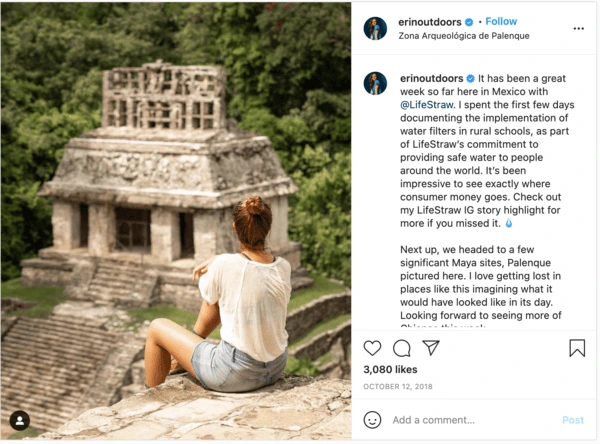
A post shared by Erin Sullivan (@erinoutdoors) on Oct 12, 2018 at 8:00pm PDT
If you have someone who’s particularly good on camera, give them a platform to talk about your project in a live stream. Most social platforms now have a solid live-streaming option. Take advantage and give your audience access to backstage conversations about your brand. Be brave and be there for your community.
Building a community
Having worked in marketing for a long time now, the most common thing I see is a fear to stand up for something important because it might upset some of your customers. You could sell anything to anyone, but that’s not building a brand legacy—that’s trying to make a quick buck.
If you consider community-building to be part of your marketing strategy, then you need to have a positive message. Brands that build positive messaging in their content and communication are the ones that stand out against the negative cycle of mainstream news.
Examples of great sustainable storytelling
There’s nothing like seeing examples that work, so we’ve curated a few samples of brands we absolutely love.
TRIBE — Sports nutrition with a conscience
At Conscious Creatives, we try to encourage physical activity as part of a healthy lifestyle, getting our team healthy through running, cycling, surfing and more. One of our biggest forms of inspiration in this respect is Tribe—a brand dedicated to making sports nutrition products with natural ingredients.
What we love about Tribe is that their marketing plans are based on creating a community. They’re a collection of people who love being outdoors, brought together by sporting events all over the world and a combined effort to rid the world of human trafficking.
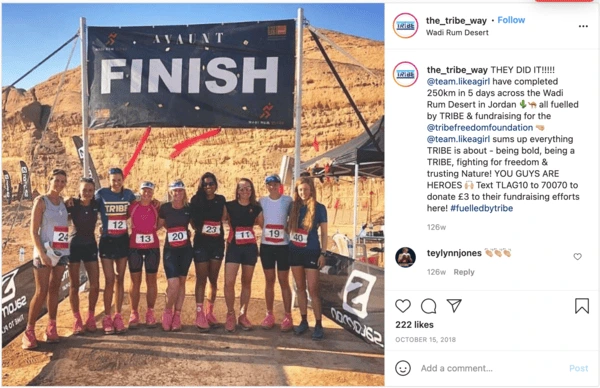
A post shared by TRIBE (@the_tribe_way) on Oct 15, 2018 at 12:46pm PDT
Tribe is a community of nutrition experts who care about the world. It just so happens that they also sell nutrition products.
Lewis Pugh — Swimming to save the seas
An example of someone who definitely fits the definition of inspirational is Lewis Pugh: swimmer, speaker and general mind-boggling human being.
He’s just completed The Long Swim, a 560-kilometer effort spanning the length of the English Channel.
Why would a person attempt such a thing? To raise awareness of the sorry state of our oceans. Lewis’s feat is the start of a worldwide campaign that aims to fully protect 30% of our oceans by 2030.
A real-life hero and conservationist, Lewis defies all logic and pushes himself to the limits to earn media coverage of the cause. See this photo of his encounter with a plastic bag during his long swim. He used a powerful image, a long caption and specific instructions to make our oceans cleaner.
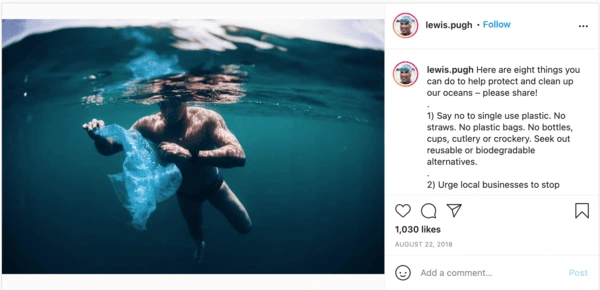
A post shared by Lewis Pugh (@lewis.pugh) on Aug 22, 2018 at 7:19am PDT
That is how sustainable marketing will change the world.
rCUP — Recycling reusable cups
I am proud to share a hometown with these folks. They discovered that only 0.4% of recyclable coffee cups were actually being recycled. So, they set about designing a product made from precisely those cups.
The rCUP is a reusable coffee cup that is affordable, looks great and has some wonderful little design elements that make it really easy to use.
A post shared by rCUP (@rcuponeplanet) on Jul 21, 2018 at 11:32am PDT
Sustainable marketing is so much easier when you’ve got products that make a real difference.
How to get started
If you’re reading this and are equal parts excited and confused, you are not alone. I suggest finding a community of like-minded business folks who are also looking to make more money by doing the right thing.
LinkedIn is a great resource for finding sustainability professionals, and our community is strong in voice. We’re all so proud of the work our peers are doing and the causes that we stand for.
Look into your industry to see which organizations support sustainability. You’ll be surprised to discover wonderful groups ready and willing to help, no matter what stage you’re at. For example, if you work in fashion, the Ethical Fashion Initiative is a wonderful example.
The key, though, is to start.
Don’t be afraid to try. Know you aren’t going to do it perfectly, but also know that simply trying is a great thing. Watch as your community grows and rallies around your brand for years to come.
In the digital age, we are constantly surrounded by bleeping phones and notification alerts. The onslaught of incoming communications can seem incessant and unceasing. Most modern consumers are surrounded by distractions, and marketers have a tough job helping their brands catch the attention of prospects.
Related: Create strong emotional connections with your brand story
Often, an effective approach is to add to the stream of information and hope to outdo competitors by offering big discounts and exclusive deals. These quick wins can help your business reach its short-term goals, but they won’t lead to long-term loyalty from consumers. Brands need to build trust with customers so they come back time and again—a one-off discount can’t achieve this.
Instead, the best-known and longest-surviving brands create and nurture emotional connections with their customers—turning them into faithful followers. To do this, marketers use emotional branding. It can take some time to reach the point where your customers’ actions are fueled by emotion, but it is worth the investment, as repeat customers are extremely valuable.
Why invest in emotional branding?
It costs more to acquire a new customer than it does to keep one. The exact figures vary, with different studies suggesting it can be between 5-25x more costly to attract a new buyer than to retain one. One Harvard Business School study suggests that improving customer retention by 5% will increase a company’s profits by between 25% and 95%.
Every marketer knows that building a strong brand is hugely important in distinguishing a business from its competitors. But, they may not realize just how much it can impact their bottom line. A successful brand goes much deeper than its logo; it creates an emotional connection with customers.
Emotional branding defined
Emotional branding is about building a brand that appeals directly to consumers’ emotions, needs and ambitions. With emotional branding, marketers aim to trigger an emotional response in consumers.
By provoking emotions, marketers can create a bond which disrupts traditional consumer decision-making models. These models are largely based around the idea that consumers make a purchase based purely on logic, but these models are changing.
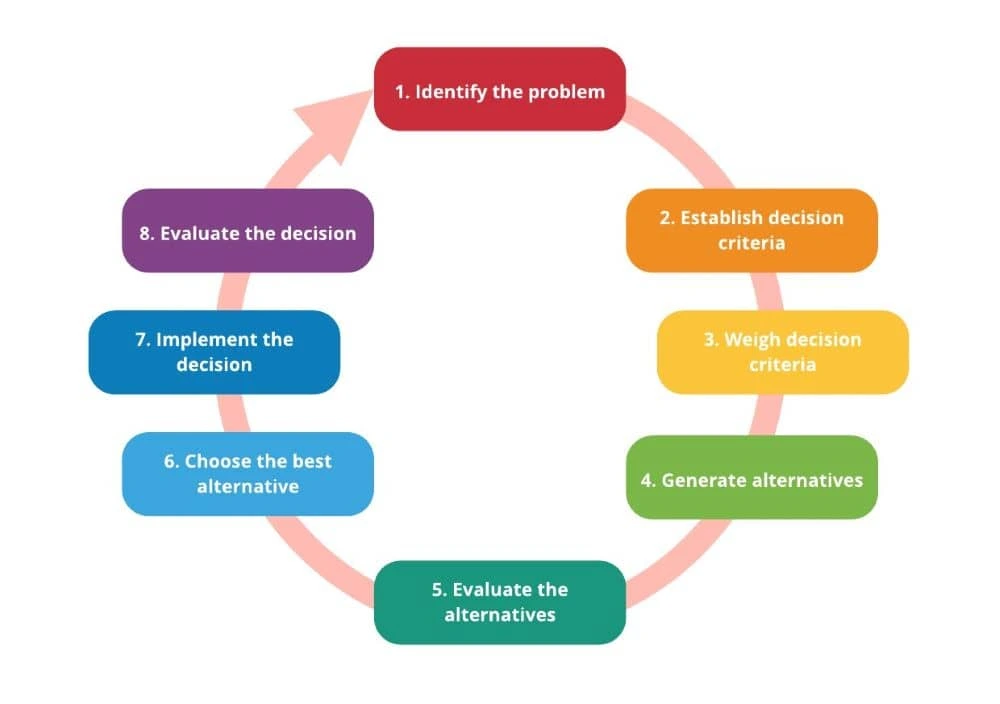
Quizlet’s rational decision-making model,lovingly recreated in Lucidpress
When emotional branding comes into play, decisions can become irrational. When given the choice between two similar products, a consumer may simply follow logic and choose the cheapest or most convenient option. However, when emotion is in the mix, they may choose to buy the brand they relate to most.
It’s easy to see how building an emotional bond with consumers can increase profits and why premium brands like Nespresso and Coca-Cola engage in building emotional connections with their customers.
Often, people choose purchases based on ego rather than necessity. Consumers can show who they are through the brands they choose—and they are willing to pay more and go out of their way to do this. It is up to marketers to position their brands in a way that will connect and resonate with their target audience. When done right, cutting through the distractions of the modern world will come easy.
How to incorporate emotional branding in your marketing strategy
The likes of McDonalds, KFC and Disney employ a number of methods to connect in a meaningful way with consumers. The longer a business is around, the easier this becomes, and many brands take advantage of anniversaries and nostalgia to bond with their market.
But, newly founded businesses don’t need to miss out. Here are just some of the approaches to emotional branding that can be used to bond with consumers.
1. Show your customers you care
To succeed at emotional branding, it’s essential to thoroughly know your audience. You need to treat your customers as people rather than faceless consumers. Do your research, conduct surveys, then decide how you can connect with your audience.
What do they value? What triggers them emotionally?
Once you’ve decided which emotion you want to tap into, this should consistently be evident in your marketing messages. From social media to customer care, a brand should constantly address customers’ emotional needs.
Over the years, e-commerce site Zappos endeared itself to customers by going above and beyond to provide great service. From providing free overnight delivery to a customer in a sticky situation to assisting a hungry helpline caller in need of pizza, the site has built up a loyal following.
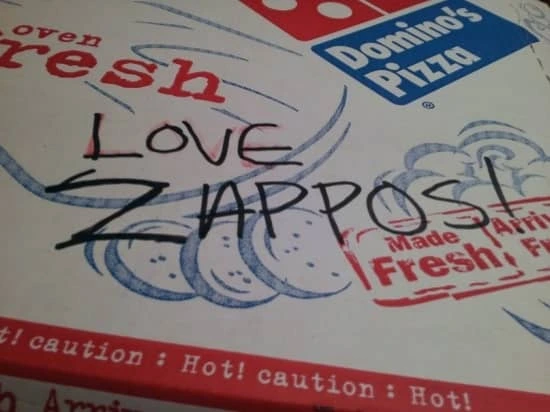
While Zappos provides an extreme example of customer care, creating an emotional connection by meeting and exceeding customer service expectations doesn’t have to be so extravagant.
Apple has built a cult following simply by demonstrating that it understands the needs of its users. Nike recognizes its customers’ dreams and ambitions, and the brand uses marketing to show how it can help with the journey.
French beauty brand L’Occitane simply provides customers with beautifully presented deliveries and free gift-wrapping—making a memorable impression which, for many of its customers, is more appreciated than a discount.
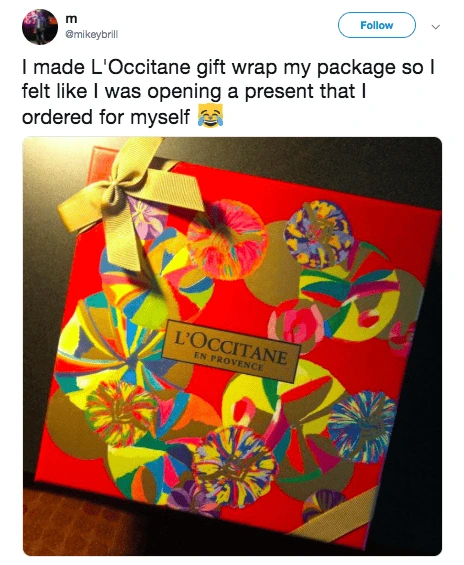
2. Be consistent
For online marketers, consistency is key. Sharing content which demonstrates a consistent tone and style builds both visibility and trust for a brand.
Without the trust of your audience, there is no way you’ll be able to build a strong emotional bond that will keep customers coming back.
Here are some practical ways to ensure brand consistency:
- Set out your brand values. Share them with the whole team to help employees at every level stay on-brand and make decisions that reflect your brand’s true personality.
- Create a set of brand guidelines. Outline your brand’s tone of voice and key design elements like font, color palettes and correct presentation of the logo.
- Put together a social media style guide. This will reinforce some of the elements set out in the brand guidelines, but it will also advise the social media team on which content they should post and how to respond to criticism.
- Use a branded URL shortener. Customize your short links so they are on-brand. This will improve brand consistency and build trust with your audience. For example, Rebrandly links receive up to 39% more click-throughs because consumers trust them.
- Create design templates. From presentations to social media images, make it simple for everyone to create high-quality, on-brand content. Then, make them accessible to the whole organization through a brand templating platform like Lucidpress.
- Monitor brand mentions. Keep an eye on what’s being said about your brand online using Google Alerts or another brand monitoring tool. Determine if your brand is coming across as intended and connecting emotionally with consumers.
3. Give customers an experience they won’t forget

Beyond providing great customer care, consider what other kind of experiences your brand can use to build an emotional connection with customers. Big brands often sponsor concerts and sporting events—or run their own. What could be your brand’s Disneyland?
If you have a brick-and-mortar location, could you host an entertaining event? If you’re working with a smaller budget, could you provide an Instagrammable installation in-store? This is a simple, but impactful, way to connect with consumers in today’s digital world.
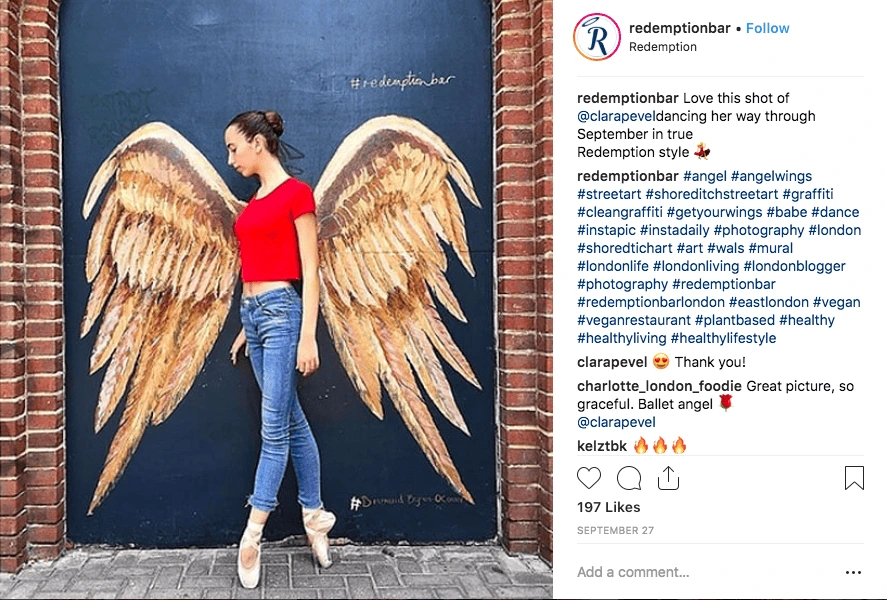
Source: Redemption Bar
Provide a positive experience as customers use your product or service wherever possible. UX is growing in importance for online businesses and is intertwined with the overall brand experience.
Companies like Slack impress customers by providing a helpful and supportive experience through friendly reminders, convenient app integrations, and cleverly auto-populated gifs.
Alternatively, you can use marketing campaigns to align your brand with a particular lifestyle or emotional experience. Coca-Cola’s “Open Happiness” campaign is a clear example of this.
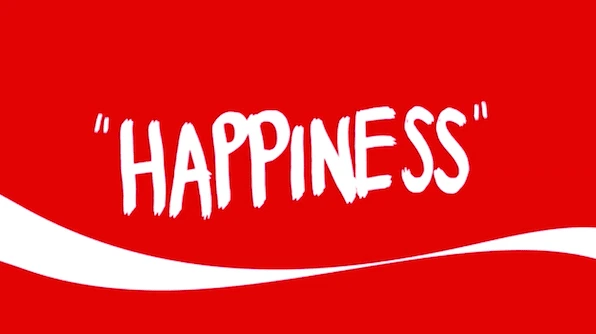
4. Put a friendly face at the center of your brand
Whether it’s a celeb, an Instagram influencer, or an employee-turned-brand-ambassador, sometimes the best way to connect with consumers on an emotional level is through a warm human personality.
Female consumers don’t go through enormous lengths to get one of Kylie Jenner’s lip kits just because of the product’s quality. They do this because of their love for the company’s CEO.
You don’t have to have a famous face to build a close relationship with your audience. Many charismatic CEOs have become the heart of their company’s brands.
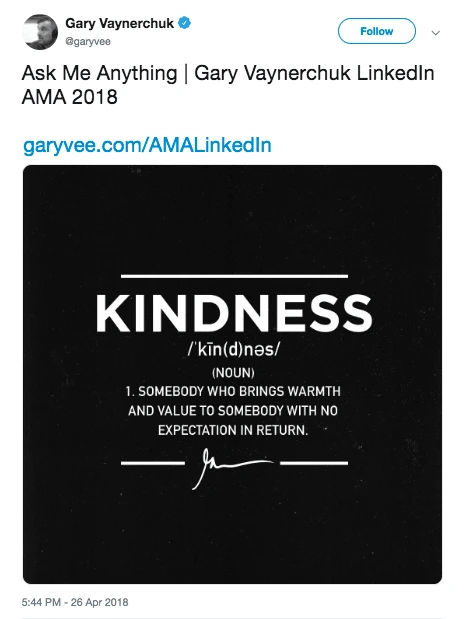
Think of Gary Vaynerchuk or Neil Patel, who have both built strong personal brands and businesses through social media. Their willingness to share knowledge and expertise with consumers has helped them to connect with audiences on an emotional level.
On a smaller scale, it’s very possible for a friendly waiter to drive customer retention by creating personal connections with diners. Brand ambassadors can come in many forms, and they’re a great way to reinforce brand values and build rapport with customers.
Key takeaway
Emotional branding builds lasting relationships with your audience and can improve the profitability and longevity of your business. You want to bring your customers to a point where they can’t imagine going to anyone else to get the products or services you provide.
Big brands are leading in this area, but small businesses can get in on emotional branding through the smallest of gestures and actions. As social media algorithms change and internet browsers seek out online communities, connecting emotionally will become a key strategy for cutting through the distractions of the modern world and reaching audiences.
Learn more about the power of emotional branding & storytelling in our webinar with branding expert David Brier.
To get people interested in your brand and have them become loyal customers, it’s no longer enough to simply produce a good product or provide a great service.
Related: 4 easy tips for effective online brand management
What buyers are looking for today is an impeccable user experience—one that really makes them feel like they’re getting their money’s worth. This is why top brands appeal to their customers’ emotions; they realize most purchases aren’t rational. Your brand exists in the minds of your audience as all the experiences, impressions and interactions they’ve had with you, both positive and negative.
The power of branding is so incredible that 72% of marketers say branded content is more effective than print advertising. To help you harness that power, here’s our list of 9 ways to make people fall in love with your brand.
1. Focus on user needs, not features
This is where many brands go wrong. They choose to toot their own horn and go on about how great their product is, when in reality, the market couldn’t care less about it. What they really care about (whether they’re looking to buy a lawnmower or reaching out to cheap writing services) is what the brand and its product can do for them.
Make sure your brand focuses on how buying your product will solve a particular issue for your audience or address a particular pain point. Make them feel like the hero for choosing you.
2. Research what your target audience wants
While it’s fairly easy to assume that the attention span of most millennials is only a few seconds or that older generations are not present on social media… If you’re basing your branding strategy on these assumptions, you have failed spectacularly right off the bat.
Researching your target audience and identifying their needs is crucial if you want your brand to connect with them on an emotional level. Find ways to speak to your customers—and ideal customers—about what really matters to them.
3. Respond to consumer feedback whenever possible
According to research, 57% of consumers say that brand’s failure to respond to negative feedback is a good reason to cut ties with that brand. Responding to user feedback and acknowledging it, even if it’s negative, can help turn things around if you try your best to remedy the issue.
By responding to customer reviews and feedback, you’re showing that communication is a two-way street, and that your brand is not generic and faceless like all the others out there.
4. Provide a free solution
Obviously, the whole point of marketing and building your brand is to get potential customers to purchase from you—but getting there doesn’t have to involve you pushing for a sale. For example, you can provide your audience with helpful, applicable, free content that will help them overcome a particular problem.
What this does is inspire trust and establish you as an authoritative resource. When they’re ready to make a real purchase, your brand will be their first choice.
5. Deliver more than you’ve promised
One of the most effective ways to create a positive brand experience is to delight customers by delivering more than you initially promised. For instance, if you surprise them with a discount or throw in a free sample, they’ll be thrilled.
While it might be a sizable investment on your part, keep in mind that customer loyalty can be worth ten times more than a single purchase.
6. Find the right distribution channel
While mobile advertising and branding are the trend of the moment, how successfully you’re going to reach your consumer audience depends on how well you’ve done your research.
For instance, if you’re trying to reach older people with your brand, you might assume mobile advertising is off-limits. And while it’s true many of them don’t use social media, they do still use smartphones—which would mean that your brand might benefit from SMS marketing.
Think carefully about all your options, and don’t take any off the table before giving them proper consideration.
7. Tell a story
It’s pretty easy to fall into the trap of making your brand’s message too salesy. A much better strategy is to tell a story with your message. For example, if you’re trying to sell an espresso machine, don’t talk about how it’s made of stainless steel or how it can make you a cup of coffee in less than 30 seconds…
Instead, focus on how amazing that first cup of freshly brewed coffee feels on a lazy Sunday while the kids are still in bed. You’re selling a better quality of life, and your product can make that happen. Figure out how to tell a story that captures what your brand can really do for your ideal customer.
8. Pay attention to the visuals
Up to 90% of purchases are influenced by visual factors—especially color, which can increase brand recognition by up to 80%. Having a website which features eye-catching responsive design is a must, but your brand identify should also extend to your social media, marketing materials and product packaging.
Every visual touchpoint is an opportunity to tell your brand story, so don’t let them go to waste.
9. Find out where your audience hangs out
Make peace with the fact that your brand cannot be all things to all people. While casting a wide net might help you attract a bigger audience, it might not be worth it when you take into account all the marketing expenses.
Instead, find your intended audience online and figure out what they want. Regardless of what your product or service is, there’s a target audience for it out there. It’s up to you to find out where they are, how they communicate, and what they value.
Key takeaway
These techniques will not only make people fall in love with your brand—they will keep them coming back for more. And when it comes to building brand loyalty and driving growth, that’s really the best-case scenario, isn’t it?
Want to know more about how to build your brand? Download our free ebook on how to build a brand in 2020.
Interactive marketing is a customer-oriented approach to marketing that engages the user and requires their participation. The most popular forms of interactive marketing content are polls, surveys, quizzes and games. This type of content can help you drive awareness, engage your audience, generate high-converting leads, convert to sales, or nurture brand loyalty.
Let’s take a look at the four types of interactive content that are most likely to bring you results.
Polls & surveys
Polls and surveys are probably the simplest and oldest form of interactive marketing. They’re a great way to get in touch with your audience, but despite their simplicity, you can use them in several different ways to help you build a genuine connection with your followers.
The easiest and most straightforward way to use polls and surveys is to ask your audience or customers for opinions about your product, service or content.
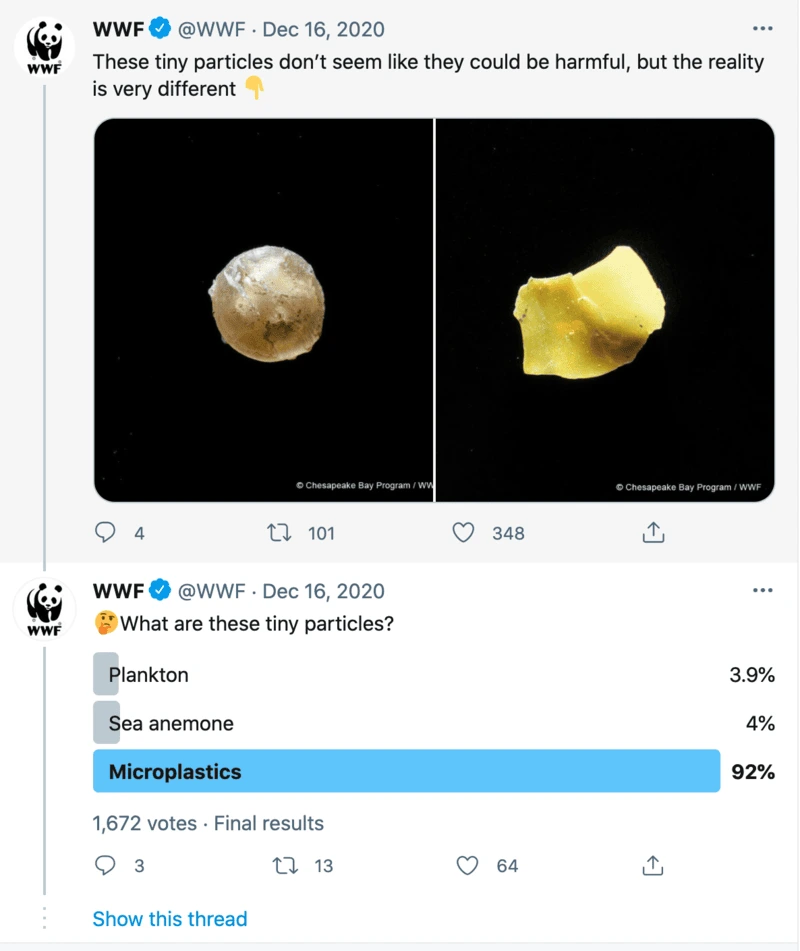
Source: Twitter
For example, many content creators run regular polls to inform their content creation strategy.
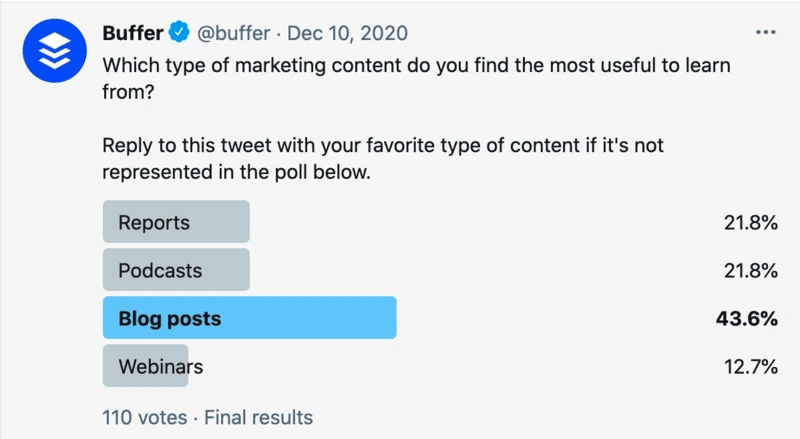
Source: Twitter
While many marketers use polls as part of their content creation process, it doesn’t have to be the only way to engage with your audience or customers.
You can use polls to obtain relevant statistics from your industry and later turn them into a valuable source of unique content that will boost your authority in the business field.
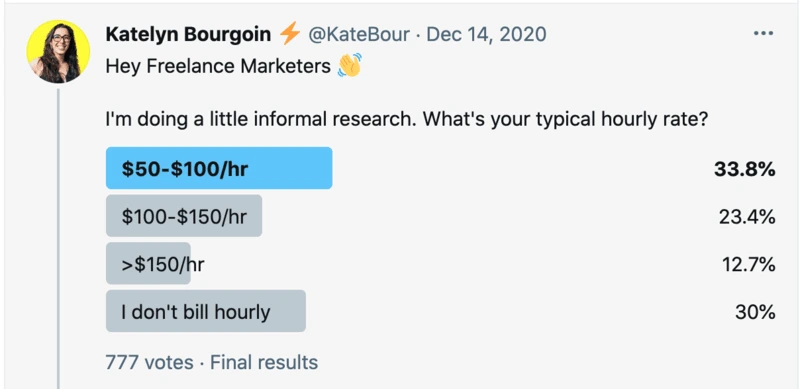
Source: Twitter
Of course, polls don’t have to be all work and no play — if your brand relies on aligning with your customer’s lifestyle, values and interests, you can always use entertaining content to nurture friendly relationships.
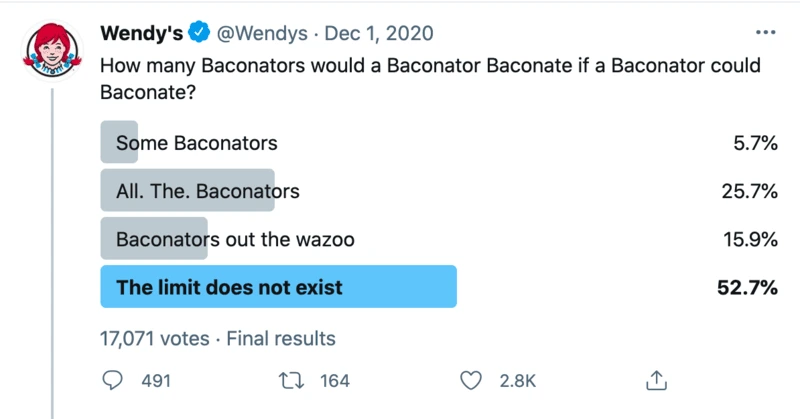
Source: Twitter
If you have any doubts on whether polls draw engagement, you can see the number of votes, likes and retweets in each screenshot. Even though the likes and retweets are often low, the number of people who voted in the polls is much higher, showing that polls really do engage your followers.
Incorporating polls in your content marketing strategy is pretty much a breeze — polls are a regular feature on both Facebook and Twitter, and it only takes a few clicks to create them.
Contests
Another well-known marketing strategy that still delivers amazing results is the gamification of various contests and challenges.
In terms of content marketing, challenges and photo/video contests are a great way to gather user-generated content that can later be used or repurposed for brand development.
Unless you’ve been living under a rock, you probably remember the famous ALS “Ice Bucket” challenge that managed to raise awareness about a rare neuron disease, engage 17 million participants, and collect $115 million in donations that led to a breakthrough in determining the cause of ALS.
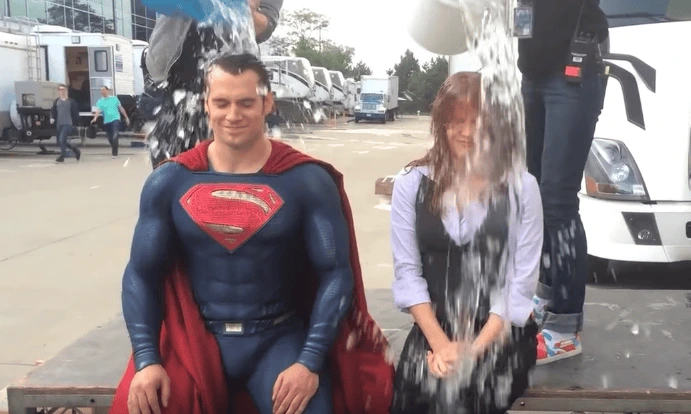
Actors Henry Cavill & Amy Adams do the ALS challenge. Source: YouTube
The ALS awareness campaign challenged people to dump a bucket of ice over their head (or have another person do it to them). Then, participants nominated the next participant — the only way to opt-out of getting showered with ice was to donate money to the ALS Association.
Similarly, you can challenge your audience to a little photo or video contest with a unique hashtag on social media in exchange for a fitting reward. Of course, whatever the topic of the contest is, it has to align with your brand values and product. There’s not much point in organizing a photo challenge depicting the wonders of nature if you’re selling used car parts — but there are plenty of other challenges that would fit splendidly.
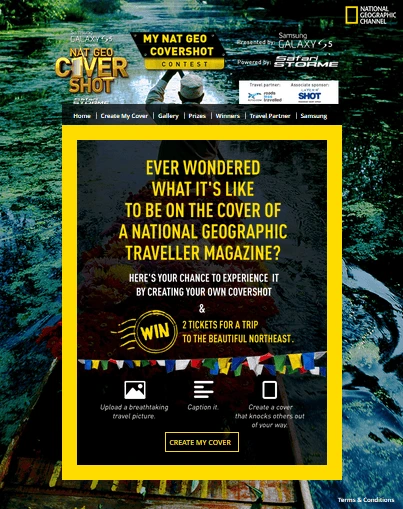
Source: National Geographic
In the end, your contest should neither be too easy nor too difficult. You want people to put some time into connecting with you in exchange for a prize or benefit that seems attainable and worthy of the work it requires. You don’t want to frustrate people or make them feel cheated.
A good challenge will bring out people’s natural curiosity and competitive spirit. The better you are at that, the greater your chances of going viral. If your contest is engaging, people will be eager to share it.
Quizzes
You’ve probably procrastinated by doing dozens of absurd quizzes with titles like “Tell us your favorite One Direction member and we’ll tell you which garlic bread you are.” Apart from being addictive and fun, quizzes can also be a great way to boost your content marketing and sell more. How?
Quizzes have high completion and click-to-conversion rates. They satisfy our need for introspection, self-confirmation, recognition and belonging — making them super clickable, convincing and shareable (qualities you definitely want in your marketing content).
For example, you can capture people’s attention by running a quiz on your website or social media, promising they’ll discover something about themselves (ideally, something relevant to your brand). The results they get can direct them towards a landing page or collect their email address in exchange.
But, don’t think that quizzes are only good for retailers and entertainment websites. This type of interactive content is also a great way to reach out to business clients. By identifying the unique challenges of your B2B buyers, you can create quizzes that offer them practical, customized solutions in the form of quiz results.
Interactive websites
Interactive websites engage and inspire your potential customers to explore content in a way regular blog posts don’t. Take, for example, this piece of sponsored content in The Washington Post.
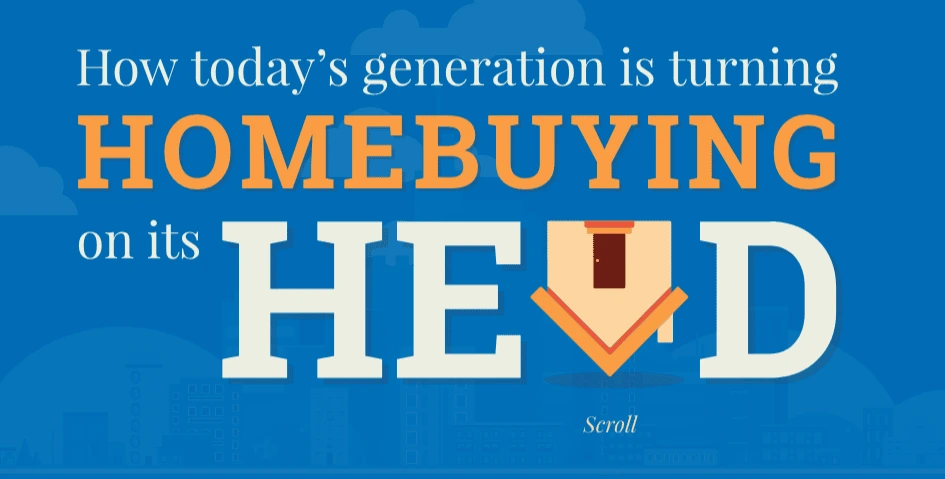
Source: The Washington Post
The National Association of Realtors published an article with the goal of reaching their target market of first-time homebuyers. As the younger generation is more cautious and skeptical about purchasing real estate, realtor marketers knew they had to step up their game.
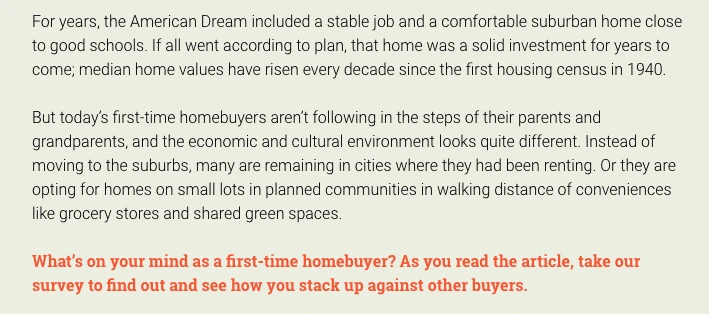
Source: The Washington Post
And the article itself does feel like a game, constantly requiring the reader’s attention and interaction. (For example, there’s an interactive infographic.) Content sections are intertwined with relevant survey questions about personal experiences, opinions and expectations.
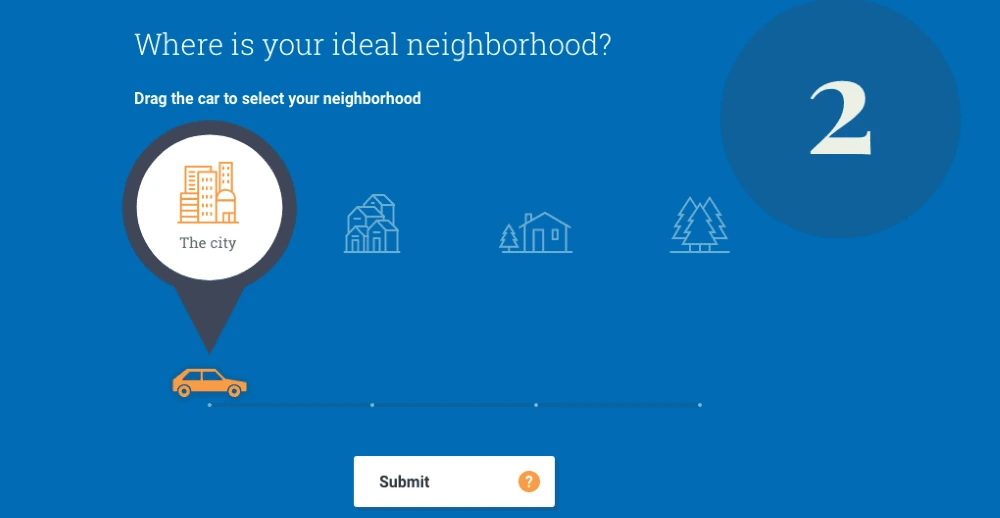
Source: The Washington Post
Apart from reaching a skeptical audience with content that responds to their common complaints and questions, the survey was also a way to help realtors gather data about their ideal customer.
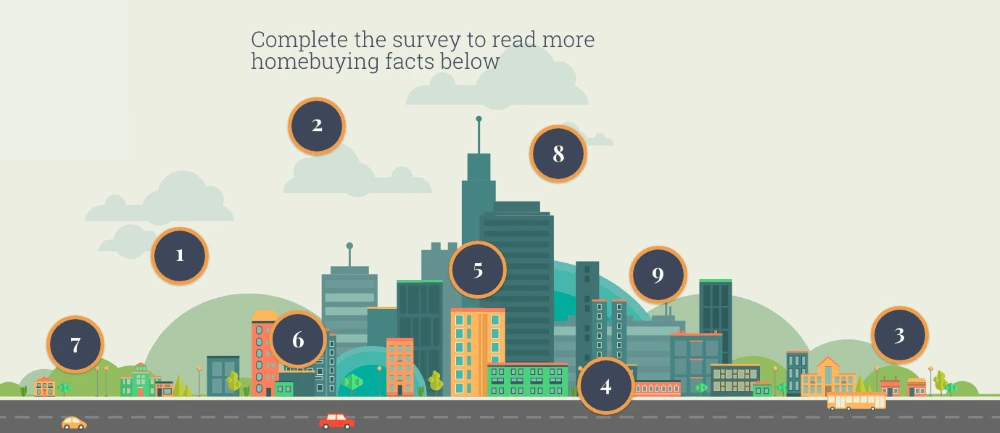
Source: The Washington Post
While interactive websites require extra work and time in development, that investment pays off. Try it on yourself — even if you’re not a first-time home buyer, did you feel compelled to check out the article anyway? Exactly. A great interactive website encourages visitors to explore, click and read(!) your content.
Key takeaway
As the digital sphere grows more personalized, interactive content is becoming the norm. Software developers are keeping up, providing marketers with tools that turn interactive content creation from a daunting task into a 10-minute routine.
If you decide to dedicate more time and resources to this type of content marketing, keep in mind the reward: more pageviews and more conversions. Why not give it a try?
Are you sitting at your desk waiting for that sweet, sweet logo inspiration to strike?
No matter whether you’re a consultant looking to brand your business or a designer looking for new ideas, this article will get you unstuck.
Related: 9 excellent logo redesigns for famous brands
Below, you’ll discover different types of consulting logo ideas from some of the biggest consulting brands in the world.
Whether you’re looking for designs with hidden meanings or something more traditional, the examples below are bound to stir up some creative juices.
Before diving into our pool of inspiration, though, let’s see what makes a good consulting logo and what mistakes you should avoid.
3 golden rules to create a modern consulting logo that stands out
Make sure your logo doesn’t misrepresent your business
The color, the weight of your fonts, the spacing between the letters—everything stirs an emotion.
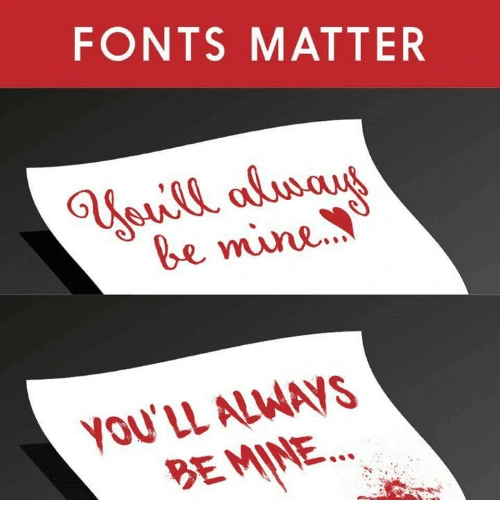
You have to make sure your logo conveys the right story, the right emotion and the right voice for your brand.
For instance, if you want to be perceived as an expert, you wouldn’t want an overly playful design.
Make sure your logo is clear and not too complicated
Yes, it’s true, your logo should tell a story. But, this doesn’t mean a person should figure it out in the blink of an eye.
Here’s what I mean. If you look carefully at Amazon’s logo, you’ll see an arrow pointing from A to Z. This is because they want to show people that they can find almost any product on their platform.
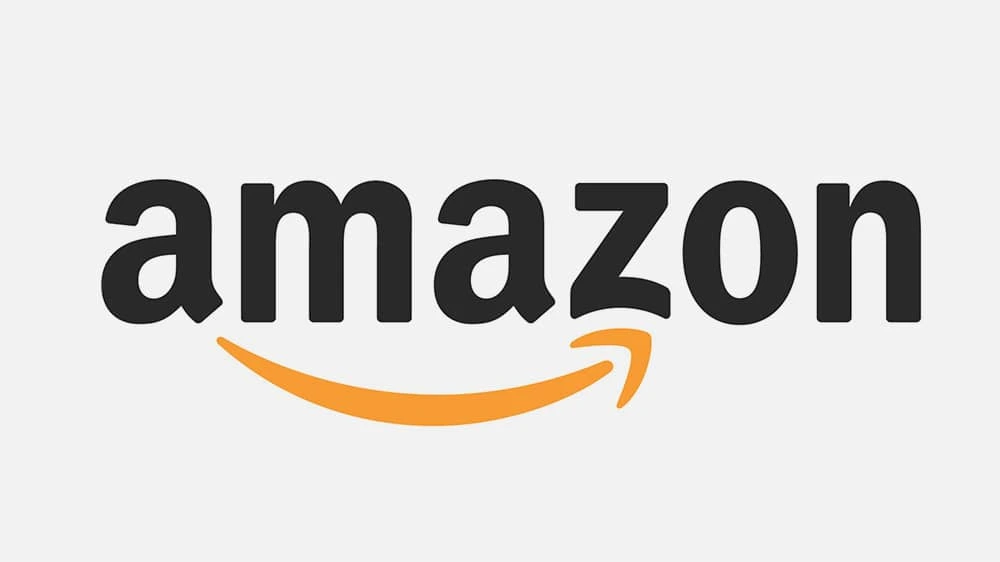
This story now makes sense because I’ve just told it to you. It only took a few seconds, and a logo which was already effective before now seems even more so. It goes to show that you don’t need to overcomplicate your logo to tell a story.
Make sure your logo doesn’t look old or outdated
What would be your first impression if you saw a consulting logo like this? (Yes, we know Hot Wheels is not particularly known for its consulting prowess, but please bear with us for the sake of example.)

A vintage font combined with a childish design… If this actually were a consulting company, you’d probably think they don’t care about how they look—and maybe they don’t care about their customers either, right? Not great.
Of course, this doesn’t mean you have to update your logo every year just to keep up with the trends. You just have to make sure you’re not hanging on to outdated design elements that were only trendy 20 years ago.
And with that, let’s move on to our round-up of consulting logo ideas.
Consulting logo idea #1: Accenture
Accenture is one of the biggest management consulting firms. The company offers strategy, consulting, digital, technology and operations services. Their revenue was around $40 billion in 2018, so we could definitely learn some design lessons from them.

The sign for “greater than” is placed above the letter t to represent the future—a future where you’ve ascended and grown to be greater (>) than (t) you (u) are (re).
As you can see, your next consulting logo can be clean & simple and still have a deeper message to communicate.
Consulting logo idea #2: Capgemini
Capgemini is another consulting giant that can teach us a valuable design lesson.

The key lesson here is that you can build a financial empire… even if your logo isn’t closely related to the services you’re selling.
The Ace of Spades has been present in their logo since its inception, but it has little to do with their business. In fact, it refers to bridge—a card game that the founder of the company, Serge Kampf, enjoys. In bridge, the Ace of Spades is the highest-value card.
It’s simple, it’s sweet, and it works. The lesson? You don’t necessarily need to hire an expensive designer to create a custom logo that’s meaningful to your brand. There are plenty of free logo makers out there that can help you get started.
Consulting logo idea #3: DLA Piper
If you’re offering legal consulting services, here’s what you can learn from one of the biggest global law firms. (How big? DLA Piper has lawyers in more than 40 countries and over $2 billion in revenue—that’s how big.)
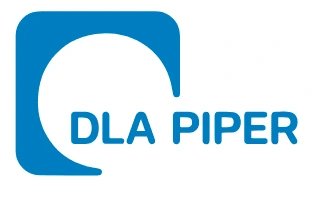
The open-ended shapes represent out-of-the-box thinking. Something you might actually want from a lawyer, right?
If you look at it from a different angle, the logo seems like a talking bubble, which shows they value the art of communication… or that they’re friendly. You decide.
Do you see how the story starts to make sense after you receive more information? And how quickly this story can change, depending on the interpretation?
The point is this: If you’re just starting out and you’re not a giant corporation, don’t fret too much on pinpointing the right story behind your logo. You can refresh the design and infuse more meaning as your brand grows and develops.
Consulting logo idea #4: Deloitte
Deloitte’s revenue was over $40 billion in 2018, and they use one of the most basic design elements in their logo: a dot.

What could we possibly learn from this? Actually, it makes a great point. (Ha!)
Timeless shapes (like the point) and simplicity will never go out of style. You don’t need an overwhelming design that distracts people from getting your message.
Plus, a simple logo will be much easier to integrate in almost any sales collateral or marketing material you develop later.
If you need further proof, just study the logos of some of the biggest brands out there: Nike, Apple, Adidas, Dell, Intel, etc. Enough said.
Consulting logo idea #5: McKinsey & Company
McKinsey & Company is undoubtedly one of the biggest consulting firms you can study and look to for inspiration.

And it can teach you two important lessons.
The first is that you don’t need a fancy or even a creative logo to express professionalism or extensive experience within a field.
In fact, quite the opposite is true. If you study successful companies, you’ll see that most of them refined their logos into simpler, cleaner versions as they matured.
The second lesson here is that even your choice of font can tell a story.
At its core, McKinsey & Company uses a classic custom font because experience, heritage and legacy are what represent them best.
Consulting logo idea #6: L.E.K. Consulting
Want to make your consulting logo stand out while still maintaining a professional, bold look?
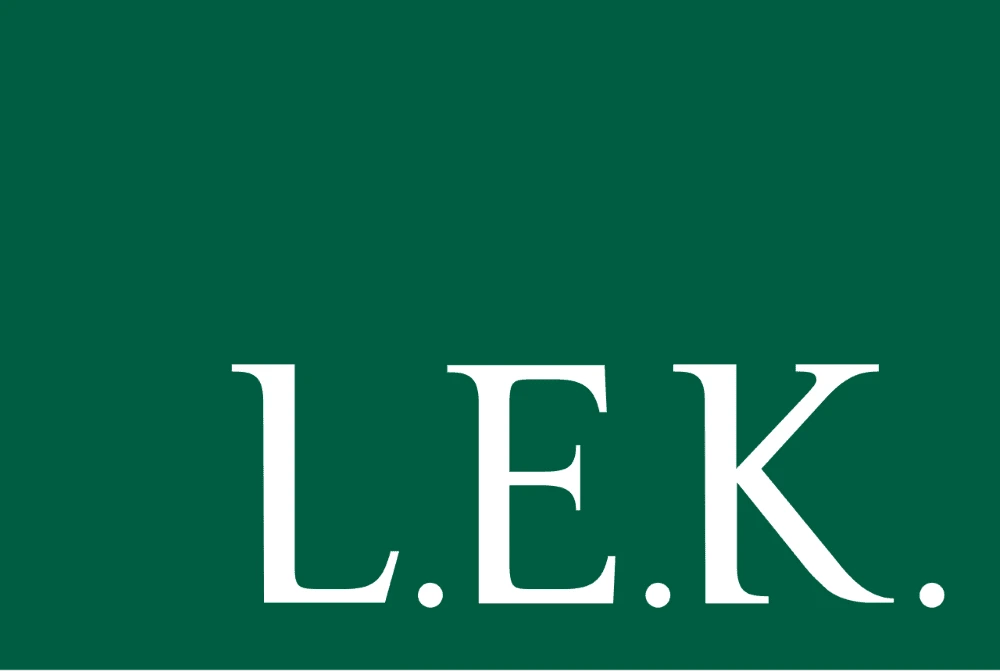
Here’s a key takeaway from L.E.K. Consulting, a global company established in 1983.
Their logo stands out because of some basic design elements and principles like composition, contrast and negative space.
For instance, they draw attention to their logo by using the contrast between the negative space in the top-left corner and the logo in the bottom-right corner.
They also give a bold look to the whole design by leveraging one of the most basic elements—the rectangle—all in combination with a deep-colored background.
Consulting logo idea #7: KPMG
If you’re afraid that your consulting logo won’t be perfect right away, don’t fret.
KPMG proves that no design should be set in stone, even if it’s a logo. You can always change it, and there’s no tragedy in doing that. It doesn’t mean you have to lose sales or credibility.
For instance, here’s how many iterations their logo’s had throughout the years:
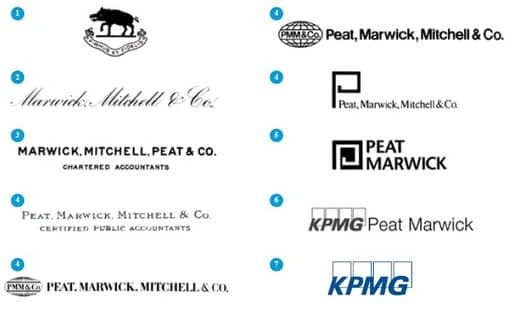
Source: KPMG
As you can see, these weren’t minor changes—in fact, many were radical redesigns. Even its name changed each time the company got a new partner or the shares were redistributed.
Still, the company is one of the largest professional services companies in the world with over $28 billion in revenue for 2018.
Consulting logo idea #8: FedEx
FedEx isn’t a consulting company, but if you want your consulting logo to be more creative and have a hidden meaning, it’s a good example to follow.
If you look carefully, there’s a hidden arrow that communicates speed and accuracy to those in-the-know.
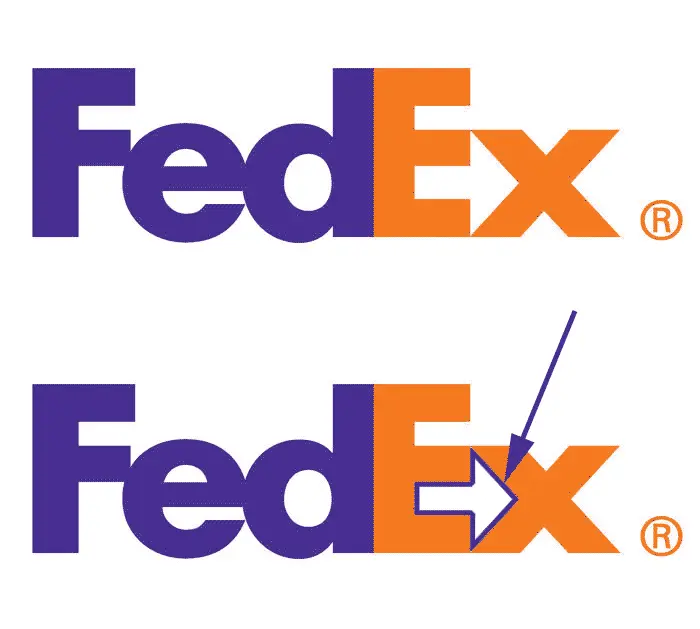
Of course, now the question is, how do you come up with such clever ideas?
It’s simple. It all starts with your unique value proposition, the core message you want to communicate.
Find out that one thing, that most important thing that makes people want to do business with you. Then, incorporate it in your design.
Consulting logo idea #9: Sony Vaio
Sometimes, the hidden meaning in a logo can come from the product itself.
Here’s a clever logo idea from Sony Vaio. Even though it’s not a consulting company, it’s worth mentioning because they managed to create such a simple logo with a hidden meaning behind it. Take a look:
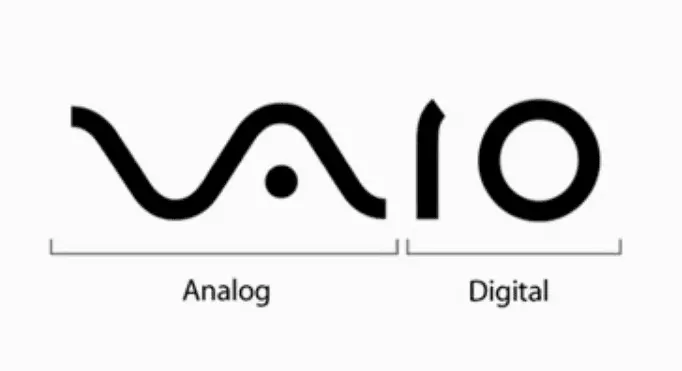
Consulting logo idea #10: Eighty20
If you’re looking for creative consulting logo ideas, Eighty20 is probably one of the best examples you can use for inspiration.
Eighty20 is a business consulting company that uses big data to inform its market research, then they use these insights to help marketers and companies better sell their services.
Their brand is a combination of geeky and creative, and they express that well in their logo. How? Each of the horizontal lines represents a binary sequence. The blue squares represent 1s, and the grey squares represent 0s.
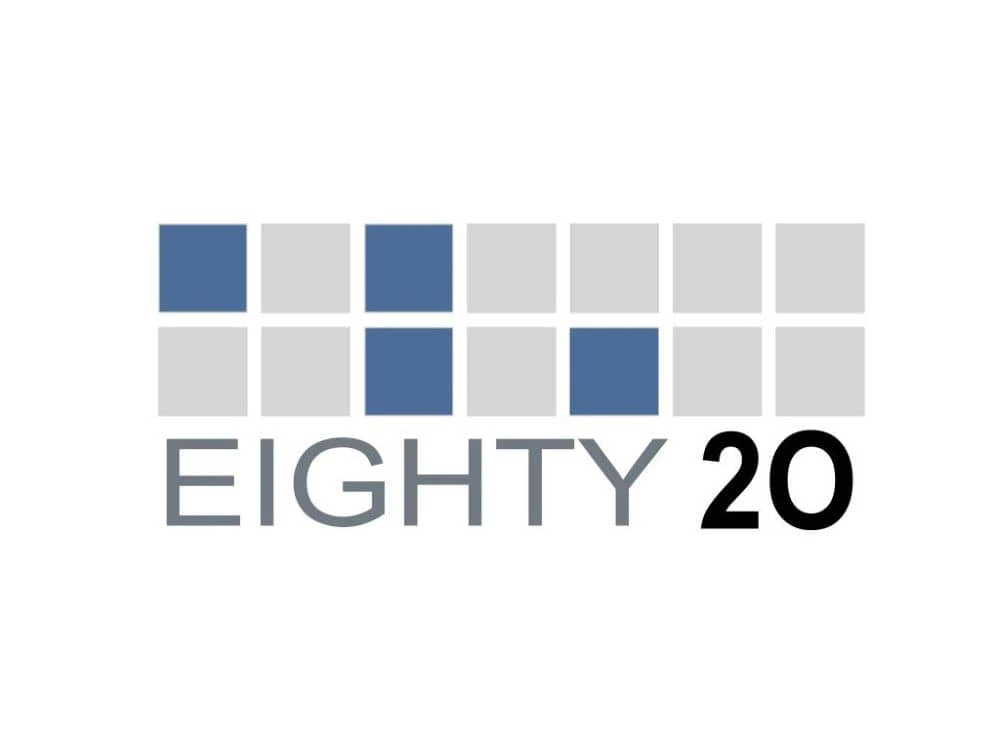
In binary sequence, the top row is 1010000, while the bottom one is 0010100. If you transform these numbers from binary to decimal, it reads… you guessed it: 80 and 20. Pretty clever, right?
Before designing your next consulting logo, do this
There are thousands of logo design ideas out there. The problem is, the more you see, the harder it is to choose one.
Here’s a method professional designers use to come up with great ideas quickly (and easily decide on the right one).
First, stop looking for ideas. Then, define the core message you want to communicate.
Are you fast and precise? Do you offer a complete range of services? Do you have the most innovative solutions or the most comprehensive research? Are you affordable for SMBs, or do you only serve large enterprises?
Only after you define your core message should you start looking for inspiration. Don’t worry—we’ll be right here when you come back.
Ready to start exploring your new brand identity? Try creating a few logo variations in Lucidpress, using your brand colors.
CMO’s are in a unique position to own, understand, and implement customer experience not just as a marketing function but as a fundamental component of every aspect of a business. As a CMO you’ve known for years the importance of cultivating customer relationships and building a brand customers trust. Now, with customers demanding an even more consistent and comprehensive customer experience, you can connect marketing and branding activities not just to leads generated but also to higher sales conversion rates, greater customer retention and higher numbers of brand advocates.
Start at the beginning of this post for CX beginners and go to the end for specific CX measurement and implementation strategies.
What is the customer experience?
The customer experience is the summation of every interaction a customer has with an organization. These interactions span well beyond a conversation with a customer support rep or account manager. Every interaction with your company from the website to the product to your employees impacts a customer’s experience with and perception of your company.
Your product or services should inspire or wow your customers. And then, should issues or questions arise, you should feel confident in your customer support representatives to offer applicable solutions, and provide a memorable customer experience.
Why customer experience matters
Today’s customers expect a personalized customer experience — 33% of consumers who abandoned a business last year left because their experience wasn’t personalized. Another survey found 81% of marketers expect to be competing mostly on the basis of CX within the next two years.
CMOs who focus on developing a comprehensive customer experience program now will find themselves at a significant strategic advantage over those who wait to recognize the importance of delivering an exceptional customer experience.
Customer experience vs customer service
A customer considers the whole picture when thinking about what your business offers and so should you.
Both customer service and customer experience are important pieces in making your business a success. But you shouldn’t draw a hard line between the two. There’s quite a bit of overlap between how a customer uses a product or service and how they interact with the people supporting it. So, you’ll want to approach customer experience strategy and customer support as mostly one-in-the-same.
Customer experience
Customer experience (also known as CX), encapsulates the broader customer journey that people have across your organization, involving every interaction with your customers and your business including customer-facing services.
However, more importantly, it highlights and showcases how the customer experiences your product or service, their interactions with self-service support, their experience in-store, customer service and much more.
Customer service
Customer service is the human part of the customer journey — it’s the assistance and advice given to a customer regarding any of your products or services.
It requires your customer-facing team to have a unique set of skills including patience, product knowledge, and perseverance so they can give the assistance any and all customers need, regardless of where they’re at in the customer journey.
So, what’s the difference between the two?
Customer experience involves the entire journey — from initial queries to purchase, as well as customer service. Customer service offers limited insight into what the customer wants and needs, whereas the customer experience covers a holistic overview. Keep in mind, understanding customer experience often involves analyzing data from teams who aren’t customer-facing but do contribute to a customer’s experience with your product or service.
How to measure customer experience
Customer experience is very important for sustained growth. You need to provide a positive customer experience in order to:
- Build brand loyalty
- Establish brand authority via recommendations
- Gather customer reviews to ensure a solid customer experience
- Retain revenue
- Attract new customers
In today’s market, the customer (not the seller or service provider) is the one with the power. Thanks in part to the rise of the internet, your customers have more options than ever before and it’s very easy to switch their loyalty to a competitor.
Customers also have a great deal of power when it comes to influencing your business’ reputation through online reviews and social media. For that reason, customers are your best resource for growing brand awareness in a positive way if you’re delivering a great customer experience.
To that end, you’ll want to measure the customer experience via the following metrics:
- Customer happiness — Are they happy? Leverage NPS testing strategies or other means of customer satisfaction survey results.
- Customer churn — What’s your customer churn rate and why do they leave? Compare and contrast why certain customers leave and why others stay.
- Customer preferences — What features do they like? What features do they wish your product or service had? Get their buy-in through surveys or personalized nurture campaigns.
- Customer support — What issues or trends are popping up when support is contacted? Sit down with your customer support team. Probe for frequently experienced issues. And while you’re at it, take a good hard (re: analytical) look at the support tickets.
What is customer experience management?
Customer experience management, or CEM, is a strategy used to track, oversee and organize all customer interactions. CEM helps a business focus on the needs of its customers, so your business can connect the dots within the customer experience — and give folks the customer experience they expect, want and deserve.
CEM software can be easily leveraged to bridge the gap between touchpoints or journey steps. And it can be used to automatically collect and analyze customer feedback for you to use, so you can easily and tactfully improve your client experience. A good CEM system delivers deep insights replete with an analytical dashboard, reporting options and other specialized integrations with your customer relationship management software.
11 customer experience strategies
To help you get on your way to creating and nurturing an effective and successful consumer experience strategy, we compiled eleven of the most important and relevant tactics.
So, what are you waiting for?
1.) Understand your audience and create buyer personas
In order to offer a great customer experience, you need to know a lot about your customers. You should know who they are, and what their motivations are — which is where creating buyer personas comes into play. Work hand-in-hand with your support and sales teams to identify customer personas as well as personality attributes.
From there, you can utilize these personas within your marketing and creative efforts, in turn empowering you to cast a wider, more accurate net. Plus it helps you gain a clearer understanding of your customers’ needs and enables your outreach efforts to be personalized to real people with relatable hurdles or experiences.
Spotify is a great example of using data to create a memorable customer experience with their clever, tongue-in-cheek marketing that draws from their users more unusual listening habits. Check out their 2018 advertising campaign — Spotify leveraged metrics and user statistics to create compelling marketing copy that represented actual Spotify users, cultivating a sense of familiarity and building rapport.
2.) Evaluate CX based on your brand’s mission and values
A successful CX strategy starts with creating alignment between your company’s stated value proposition and values and the customer’s perception of your business based on their experience with your company. What gaps are there between customer expectations and experience in your business? Are your internal processes doing a good enough job at supporting your customers? What tools could you use to improve the customer experience?
3.) Use CX-centric tools to help you
Creating seamless customer experiences can feel overwhelming. To get started, you’ll need to understand how customers interact with your product and what they expect from it. Using CX tools can simplify this process for you by capturing relevant customer data and offering actionable insights. Tools like this are equipped with various capabilities such as content management, customer analytics, and customer feedback. For example, try using:
- NPS surveys
- CSAT surveys
- Customer product reviews
- Site analytics (e.g. Google)
- Website heat map
- Churn rate
- Average resolution time (for customer support)
- Social media listening
4.) Work backward to create the ideal consumer experience
Start with the end, ideal experience and work backward toward the technology and processes you’ll need in order to create the ideal consumer experience. Unsure what it is? Start by mapping the customer journey. Doing so helps you identify opportunities where you can make a lasting impression and avoid CX failure as a customer moves between touchpoints. Remember to focus on practical issues too, like autofill on forms to save your users’ time.
5.) Hire team players and get the team invested in customer experience
You can’t deliver a great customer experience without the right employees. You should train your team to pay keen attention to customers — no detail should be spared. This can be as simple as noticing that a customer mentions a birthday and making the effort to give them birthday wishes when they come in. Doing so empowers your team to create a personalized customer experience. So, when you’re hiring, be sure to look for strong interpersonal skills, a solid ability to connect with a wide variety of people and patience.
6.) Eliminate bad or rogue design early on
User experience, or UX, is critical. Customers arrive at your site through a variety of mediums, but your brand needs to remain consistent no matter how a customer gets there. One bad or inconsistent experience could be enough to put them off, sending them to a competitor never to return. To avoid this, create a branded style guide and empower your teams with a brand templating platform, so they can create on-brand content whenever, wherever. Ultimately, you want your content to be easy to consume and even easier for customers to find the information they need from you.
7.) Pay attention to customer needs and use feedback loops
If you’re going to provide an experience your customer truly finds helpful, you need to know what your customer expects, wants and needs. To do this, create a feedback loop — post-interaction and real-time feedback surveys are a good start. From there, support staff can easily follow up over the phone and ask about their experience. Use social media and other means of customer interaction touchpoints to keep tabs on your reputation amongst your existing customer base — and prospective ones, too.
8.) Research your competitors
Take the time to analyze competitors and market trends to build a clear picture of who the competition is and what they’re doing in contrast to your organization. If you know your business needs to improve, use this market research to help you bridge the gap between where you’re currently at and where you want to be. Do this by creating strategic goals and objectives that help you implement a successful CX strategy.
9.) Building systems for effective resolutions
Customer feedback requires a company response. Implement an unobtrusive support system for every stage of the customer lifecycle. Make it easy for your customers to find the support solutions they need — whether it’s a live chat option, text messaging, webinars, social media, self-service solutions, email, or phone calls — you must make yourself available. Be sure to keep your response time promise relative to what’s realistic.
10.) Dial-in your brand personality
Make your brand personality and presence something that customers want to be a part of. A strong personality helps to build a large, loyal customer base. To get started, think about who your brand would be if it was a person. Then, define it relative to your brand mission and values. For example, are you:
- Inspiring, clever and approachable
- Reliable, influential, and authoritative
- Sincere, kind, and compassionate
- Charming, magical, and spirited
Alternatively, check out our brand archetype quiz jump start your brand personality efforts.
11.) Use machine learning or AI to deliver a seamless end-to-end experience
With artificial intelligence, you can set up auto-responses to routine customer queries and guide your customers with curated content. AI customer service interactions reduce the need for staff to attend to every customer query, enabling them to focus on more complicated, high-visibility problems. You could also use AI to segment your customer base and provide a more personalized experience. AI can use information from browsing data, pages visited and past interactions to send targeted messages automatically.
A seamless end-to-end customer experience provides your company a lot more than initial earned revenue — in exchange for going the extra 1% for your customers, you gain brand loyalty and authority within your industry. And in turn, you gain customers for life.
We love a good yarn — and it turns out, consumers do too. The popularity of brands telling their stories continues to grow and grow. It’s a win-win marketing strategy when you can give your audience engaging content and tell the story of your brand’s history, vision, values and goals.
The bar for good content marketing is certainly high these days, with some brands, like Mailchimp, expanding into podcasts and even streaming video series. But you don’t have to be a huge brand with a big budget to tell your story. We talked to brands large and small to see what they’re doing to connect with customers.
Read on to see how brands including Zendesk, Buffy, and Chanty are finding success in their approach to brand storytelling.
Be authentic
For content to really connect with customers, it needs to be authentic and true to what your brand is all about. We interviewed Suzanne Barnecut, Group Manager of Content Marketing at Zendesk to find out how her team takes on brand storytelling.
Suzanne is the editor of Zendesk’s multifaceted content venture, Relate, and spoke to us about creating content that’s people-focused, sales-free, research-based and, above all, authentic.
How do you strike a balance between being personable, maintaining brand voice and inspiring your target audience?
“Relate is focused on where technology meets the human experience. It’s our space to focus less on the tools and more on the people using technology to build better customer experiences and relationships. Our audience may be business leaders, but at the root of it, we’re all just people trying to be effective and more empathic with our teams and customers. So, in a way, our mission as a publication makes it easy to hew to our brand voice — which is that we’re trying to write toward human experiences in an honest, straightforward and personable way.”
Relate incorporates content, a podcast and an annual event. How do the three work together and relate to one another?
“The Relate subbrand has undergone a pretty significant transformation as we’ve grown as a company over the past 4-5 years. What began as a small, intimate event series and storytelling podcast grew into our annual flagship user conference and a customer experience podcast called Repeat Customer. The relationships are dynamic (as relationships naturally are), but the publication and event overlap to provide thought leadership and insight from our leaders and other experts in our space, to examine the wider trends that impact our customers, and to share content that reflects our brand values and point of view. And in all cases, we love to tell stories about the cool things our customers are doing, both with their customers and in the world.”
How does Relate complement the Zendesk product and website?
“The Relate publication is more focused on brand journalism and storytelling, so it’s a relatively sales-free zone. In that way, it functions as a nice complement to the product site and our more traditional corporate blog, which we call the Zendesk Library, where we publish more product- or operations-focused content and customer use cases.”
What research influences your content strategy? Is one source of data prioritized over another?
“We do always try and leverage our own data whenever possible. Our customers can opt-in to anonymously share data so that we can, in turn, share back industry benchmarks and trends with our customers. For example, we have been analyzing data from the Zendesk Benchmark to understand the impact of COVID-19 on customer experience and engagement.
Our content strategy is built around trying to provide useful content that addresses the questions or pain points that people actually have, and we believe that all our content should be informed by research — both our own and that of vetted experts and industry analysts — and by interviewing subject matter experts first-hand.”
How does your team measure success?
“We’re a data-driven marketing org, so we track our analytics pretty closely. Brand awareness efforts, like Relate, always have that hard-to-put-your-finger-on anecdotal value, but that can lead to tangible things like someone deciding to apply to your company over going somewhere else, for example. At large, though, we’re looking at some traditional consumption metrics — average monthly unique users, page views, organic growth — as well as some business metrics to understand our contribution to the pipeline (we have a multi-attribution model) and the opportunities we impact. This also helps us to know which content is resonating with our audience.”
What advice would you give to marketers trying to tell their brand story?
“Brand storytelling has to be authentic, so it’s never going to work to tell someone else’s story. Think about what your company is trying to do at its highest, most aspirational level. How and why did that journey begin — and where did it lead to next? Under that umbrella — whatever it is — there’s a wealth of stories waiting to be uncovered and brought to life.”
Start with a mission
Brand storytelling can make a brand bigger than just any one product. Buffy — a company that sells earth-friendly bedding and is on a mission to build sustainable business practices — benefited from starting with its mission first and its product development second.
We talked to Matt Breuer, Buffy’s VP of Marketing, and Blair Pfander, Buffy’s Creative Director, to see how doubling down on your mission can result in serious customer engagement.
Matt explained the company’s values-centered philosophy: “Buffy has been a mission-driven company from the start. We set out to create an earth-friendly, cruelty-free comforter and our product assortment has expanded pretty organically from that cornerstone idea. Our mission is to help our customers live comfortably without making the planet uncomfortable. The tough reality is that any company manufacturing new things today is by definition unsustainable; closing the loop on our supply chain by 2030 (an undertaking we’ve dubbed Closed Loop Comfort) is really the only way to show up for our values and take seriously our commitment to the planet.”
The brand shares its plan to achieve its mission openly — complete with a timeline and commitment to how the company will make itself even more earth-friendly.
Blair talked more about the impact of the brand’s environmental commitment: “We were thrilled by the level of engagement and excitement around our Closed Loop Comfort supply chain commitment back in April. It was the first time — at least in my memory — that we sent emails without any products on them — and customers were still opening, asking follow up questions, and reflecting deeply on the content. The world is a pretty scary place right now, and people have a lot of options when it comes to home goods and bedding, so the fact that they’re coming to us not only for marshmallow-soft comforters and sheets but for important conversations is meaningful to me.”
Buffy’s creative team turned to Instagram to develop a community around their focus on comfy, earth-friendly products with a notion they call “comfy content.” We were curious — how does the team come up with a steady stream of ideas?
According to Blair, “We find a lot of inspiration just from deep Googling and feed scrolling — artists we’re excited about, memes that make us laugh. The occasional 1970s gardening book scavenged on Etsy.”
The team meets once a month to chart a storytelling course both for product stories and culture stories. Blair continued, “It’s important to us that our community has a reason to return to the feed other than learning about what we make. Making sustainable education accessible and fun is something we’re dialing into more and more.”
We asked how the Buffy marketing team approaches keeping a consistent brand identity. Blair’s advice was to use your brand system as a starting point but then deliberately break the rules every once in a while. “We have a saying on the creative team: ‘Keep Buffy Weird.’ So just as often as we dial into our systems — scannable type hierarchy, saturated color, playful information design — we break it by adding an element that feels a little off, or even slightly surreal. The surreal factor is a critical differentiator for Buffy.”
Blair pointed to the brand’s “squishies” — videos showing hands mashing soft materials, like jello or brioche buns — as one example of Buffy’s weird, surreal and fun style.
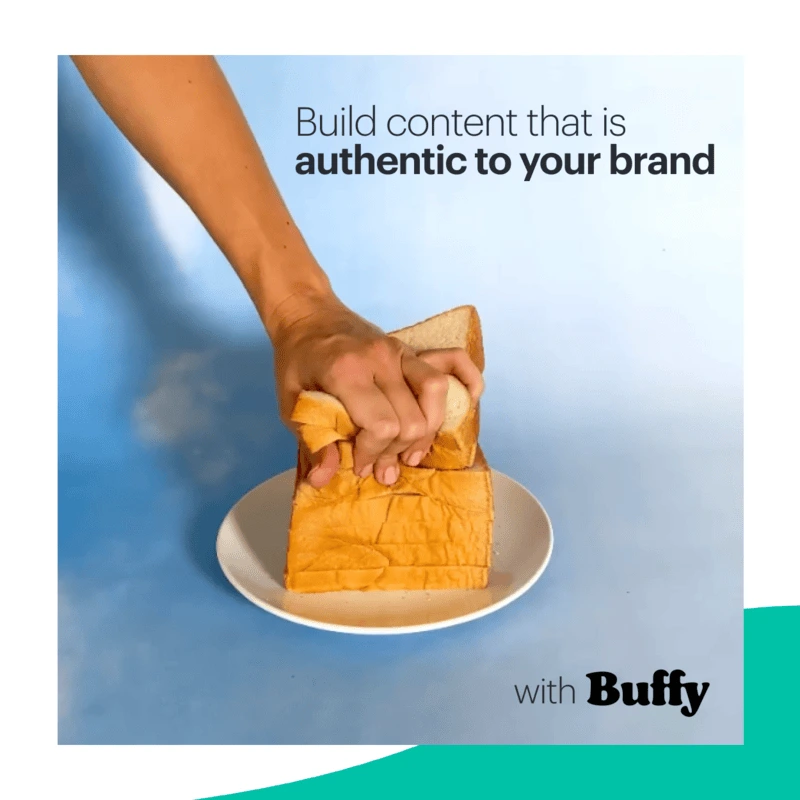
Embrace (and review) the competition
Making your story stand out from the competition in a saturated market is one of the hardest parts of brand storytelling. Chanty, a team communication and collaboration software and Slack alternative, knows this all too well.
But the brand decided to embrace the confusion (and search volume) that comes with many products, multiple solutions and no clear answer on which to choose. Chanty built out comprehensive comparisons of other apps in their niche in the “Team Chat Wars” section of its blog.
We spoke to Jane Kovalkova, Chanty’s CMO, who told us the brand’s Team Chat Wars has built up their brand as the number-one resource for app comparison in their product category.
“This way, visitors come to our website not only to find out more about what we do, but to get an objective comparison of different team chat apps and how they help meet their needs. For example, we’re currently covering an article on Skype alternatives since we know that the topic gets quite a few searches, so we’re reviewing all of Skype’s competitors now. By reviewing, I mean actually testing them and writing down our experience.”
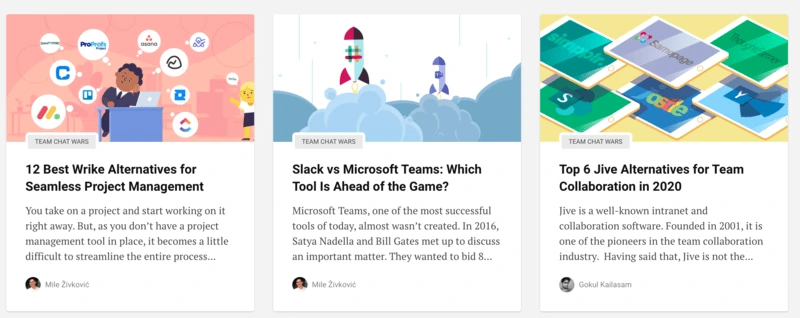
If you’re interested in doing product comparisons, Jane recommends preparing to put time and some money into it. “There are lots of ‘reviews’ out there by affiliate marketers that never even tried the products they review. Make sure to get some hands-on experience with the products you cover and do your best to give your personal impression. Of course, no opinion is objective (that’s why it’s an opinion), but people don’t want to read facts — they want actual experiences with a product, from a real live human being.”
SEO is (still) king
For businesses with fewer resources and a smaller budget, going beyond your product keywords and embracing your industry to produce educational content around search terms can build your brand in an affordable and sustainable way.
Online Degree — a company that offers free introductory college courses — has built out huge research libraries providing information on careers in multiple industries, types of college degrees and universities in every state in the U.S.
The founder and CEO of Online Degree, Grant Aldrich, told us “Brand journalism goes beyond a corporate blog. It provides the latest news updates and informational trends in your industry. It’s also a way to reinforce your mission and values to attract your target audience. In our case, we try to make higher education more accessible and affordable. Our goal is to help people find the best, most affordable educational resources with this kind of content. Not necessarily to drive people to use our services.“
Build community relationships
Natalya Bucuy, Content Marketing Writer at HelpSquad (a U.S.-based live chat service), takes an approach similar to Online Degree with her company’s B2B brand. “We believe that brand journalism that delivers useful content not only to current customers but to the small business community in general is an effective marketing strategy. Even if a piece of content doesn’t immediately bring measurable results, such as converted leads and new customers, it helps build meaningful relationships with the community. That, in turn, builds a strong brand presence that contributes to a company’s success in the long run.”
She pointed to an example of a recent post on Reddit her team created to drive discussion around behaviour psychology and the reasons behind procrastination that linked to a HelpSquad blog post that discussed the topic further. Reddit is notorious for being very picky about content quality and will sniff out any sales pitch, but this post hit mark with 99% upvotes and 73 comments.
Expert content can work in a variety of venues and help your brand increase its reach. It’s worth brainstorming where you can go outside of your own site and social media platforms to tell your brand’s story.
These inspiring strategies and brand story examples are proof that useful content with some outside-the-box thinking can lead to success. Your brand story, told consistently and creatively, could be just what your marketing plan needs. We’ve got some tips on how to get your whole organization on board for consistent storytelling: Check out our ebook The rise of the design democracy: How to maintain a consistent brand story.
The best storytellers know that a good story is more than telling romanticized tales about a life lived. Good storytelling knits together polarity — people, spaces, emotions, conflict and impact — and transforms it into something visible and tangible. While there is a time and a space for waxing poetic, truly compelling storytelling is defined by authenticity and the sum of many parts.
Furthermore, let’s be honest: Try as we might, we can’t all be like Walt Disney. Sometimes we simply can’t feign magic when it’s not there, or perhaps the nature of our work prevents it. Alternatively, we have to practice active listening and cobble together stories from there — because your audience is people too.
To help dispel the myth that we can or must all be like Walt Disney (someday when we grow up), we reached out to the best storytellers we know and asked them to tell us their secret storytelling recipe. Naturally, they delivered.
So without further ado, we’re bringing the TLDR, best-of-the-best storytelling tips to you, so hopefully, you can take something from them and apply it to your stories.
Storytellers featured in this article
- Hanna Reichel — Outdoor industry Brand Strategist, Vermont based
- Jon Carter — Campaign Director for Utah Rivers Council
- Leidy Wagener — Corporate and Foundation Relations Manager at Montana Food Bank Network
- Matt Halpin — Copywriter at Black Rifle Coffee Company
- Natalie Ipson — Media Relations Manager with BYU
How to create compelling stories
Some stories come to life quicker or easier than others. However, regardless of the speed with which you create stories, our blog post participants recommended the following initial tips to nurture an evocative storytelling experience:
Nurture a human connection
“We look for the human element in every piece. Every person has different experiences, but we can connect so quickly through shared emotions. Heartache, love, failure and triumph all feel the same regardless of the circumstances that cause those feelings.”
Natalie Ipson
Remember to center the storyteller’s voice, not your own
“I think that good storytelling from a nonprofit, or even journalistic, standpoint has to be unselfish. When crafting a client story, you are merely a conduit to someone’s story, giving them a voice and platform to be heard. When presenting an organization’s story, you are offering someone an opportunity to support something they are passionate about and believe in. While it certainly doesn’t hurt if you are also passionate about and believe in that work, YOU as an individual aren’t a part of that relationship except as a conveyor of information.”
Leidy Wagener
Leverage technicalities and data when it works
“Everything I write comes back to two questions: How can I most effectively resonate with our customers, and how can I best embody our company mission? We can track the former through analytics. We use all the fancy metrics like click-through rate, ROAS for paid media and so forth. On a technical level, I know what keywords tend to convert better than others when describing our coffee, or which value propositions to use when targeting a higher funnel audience. And I know which CTAs will lead to the most sales. It’s mad science.”
Matt Halpin
Validate passion through messaging
“Especially on the product side, we normally come to stories with a lot of passion, and I do believe that this is an important component of the story: We care. It’s our legacy. Our innovations show that. But passion needs to be validated through straightforward messaging (there’s room for clever, too); it’s easy to forget that not everyone lives and breathes this stuff. I’ve found that one of the most effective ways to demonstrate this is by articulating Problem — Solved.”
Hanna Reichel
The storytelling production process
Jumpstarting the storytelling process can be trying, but our storytellers brought to life their go-to approaches to the storytelling production process without fail. We’ve inverted these suggestions to be reflected as questions for you, the reader, to leverage as an internal checklist as you create stories yourself.
Do I know my audience?
“Every piece of content I create starts with first understanding who my audience is and what that audience needs and wants from me. It’s Communication 101 (so basic!), but so many of us often skip right past that step.”
Natalie Ipson
Do I understand my audience’s triggers or stressors? What can I share that relieves that stress?
People consume content because they want to obtain something. This “something” can be educational, informative, or offer reinforcement for what they already know. Understanding the so-called turning point that pushed your audience into the content consumption phase of their experience is critical. In other words, good storytellers comprehend people’s stressors or triggers, and these folks know how to share information that offers relief or a solution.
What does my audience care about, and am I connected with that passion?
Intersectionality is a critical concept when exploring what your audience cares about and is passionate about. Because for every general group of people, there will be smaller subsets of audiences who experience impact differently. By knowing what your audience cares about (or is impacted by), you can create stories that reflect that passion. Be wary of falling victim to disingenuous gestures or stories — i.e., avoid performative activism, allyship, or storytelling to get content out there.
What is the medium or format I’ll be telling the story from?
“The format in which a story’s told is critical to how you structure your story. A 30-minute speech means you might have a 5-minute intro, 15 minutes for the core content, 5 minutes for a conclusion, and 5 minutes for Q&A. Suppose you are writing a letter to the editor for a newspaper. In that case, you may only have 300 words to tell a story, meaning you are likely limited to focus on just one theme, for a general audience, who you are trying to sway with emotion rather than facts. Facts require lengthy data points. Emotive content requires relatable and experiential content.”
Jon Carter
Do I have a conscious audience, and does my audience care about the story? Why or why not?
“I got the chance to participate in a brand overhaul — we realized that on top of needing a new look and feel, we had to build a conscious audience. We didn’t lack a following, but it wasn’t cohesive or aligned along a particular plotline. This [the overhaul] was cathartic: it was almost as if the audience motivated us to build the product — and the story resonated with our heritage and our audience’s ethos. They inspired us as much as we inspired them. I think being open to what the audience has to teach you is a critical part of storytelling.”
Hanna Reichel
Have I answered key questions? Do I need to explain the basics?
Avoid making assumptions about what your audience knows or doesn’t know. Complicated issues, or uncomplicated ones, can take time to understand, and everyone processes information differently. Guide people through the story with kindness, compassion and attention to detail. Unpack whether or not you need to approach the subject or story from different perspectives or angles. Knowing your audience will help with this part of the storytelling process.
Have I created a “before” and “after” for the story?
“What distinguishes good brands is their ability to deliver common-sense solutions to common problems. So with my product development and marketing teams, I always ask them to do the “Before” and “After” to distill what the design impetus was and what they were able to resolve through innovation. Often this looks like a bulleted list, and honestly, that’s the scaffolding for a good story. The narrative comes alive with human touchpoints: testimonials, personal anecdotes, etc.”
Hanna Reichel
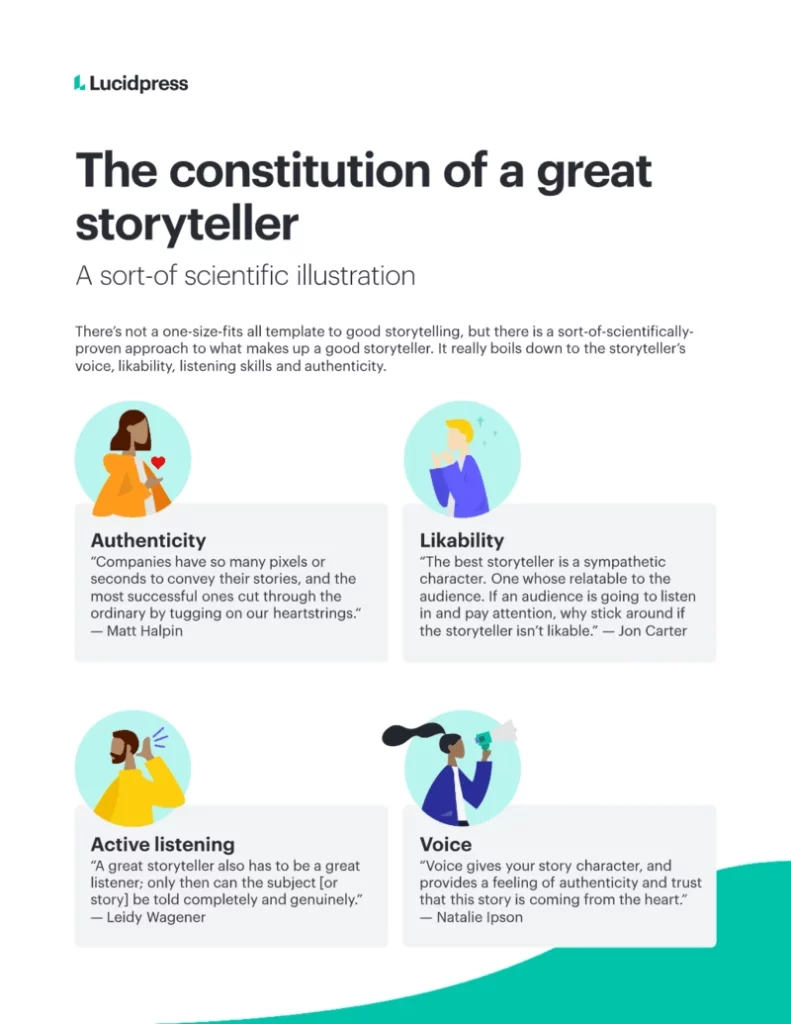
What makes the best stories?
The best stories are immersive ones — the ones people read until the very last sentence. But what exactly goes into making good and great stories? According to our proverbial “Storytellers Board,” it lay in your ability to:
Illustrate relatability and human emotion
“The anecdote of Ernest Hemmingway winning a bet by writing a compelling story in six words is a perfect example of this: “For Sale: Baby shoes, never worn.” Though the attribution to Hemmingway has never been substantiated, the point remains the same: you leave a lasting impression on your audience by connecting with their emotions as quickly as you can (e.g., the initial eight minutes of Pixar’s Up).”
Natalie Ipson
Use conflict as your aid
“The best story has conflict. It gets your attention, it’s entertaining and simply put, it’s like life. Life is full of setbacks and challenges and obstacles. Conflict.”
Jon Carter
Show what’s at stake
“The higher the stakes, the higher the suspense. Great conflict without great stakes, the audience is wondering why they should care.”
Jon Carter
Illuminate all aspects of the story
“A story is great when it is whole, which is a little hard to explain, I suppose. When I think of a great storyteller or story, I think of Chimamanda Ngozi Adichie’s TED talk “The Danger of the Single Story” and how she explains all that we are missing out on when only one aspect of a story or person is told. She is a great storyteller herself, but I think a great storyteller doesn’t fall into the trap of the Single Story and works a subject until it’s illuminated in entirety — even if all of the components aren’t necessarily part of the final result.”
Leidy Wagner
Connect with the audience’s values
“Not all stories we tell in the brand space are emotive at first glance, but we know that purchases — and brand loyalty — are ultimately emotional decisions, so it’s important to connect with the audience’s values. Speak their language, but also stay fluent in yours.”
Hanna Reichel
Related: Brand storytelling examples
What makes the best storytellers?
Every storyteller has their unique approach to pulling threads in a story and experience. However, what it boils down to is your capability to demonstrate voice, likability, active listening and authenticity.
Voice
“Voice gives your story character, and provides a feeling of authenticity and trust that this story is coming from the heart.”
Natalie Ipson
Likability
“The best storyteller is a sympathetic character. One whose relatable to the audience. If an audience is going to listen in and pay attention, why stick around if the storyteller isn’t likable. Why are your friends your friends? Same concept here. If the storyteller can also provide character change through experience, that goes even further in keeping your audience entertained and ready to act.”
Jon Carter
Active listening
“A great storyteller also has to be a great listener; only then can the subject [or story] be told completely and genuinely.”
Leidy Wagener
Authenticity
“Companies have so many pixels or seconds to convey their stories, and the most successful ones cut through the ordinary by tugging on our heartstrings. That could come through humor, a connection over a shared value or experience, or anything else that resonates with us [as humans] more than consumers.”
Matt Halpin
The best storytellers are all around you
The reality is we all have the capability of being storytellers.
However, the best storytellers are the folks who see the heart of a story, do the research and imbue words with rapt attention, tenor and authenticity. Good storytelling, and thus good stories, requires patience and the use of active listening. Keep in mind not all stories resonate with everyone, but (in part) that is the key to creating and nurturing a story — imparting education, conflict, development and relief.
Magic, try as we might, is not always given, but it is earned.
Check out our ebook The rise of the design democracy: How to maintain a consistent brand story.
Storytelling has the incredible ability to connect people on a deep, emotional level. It brings us together as we feel empathy for one another, laugh together and relate to someone else. Figures and stats aren’t emotionally charged and interesting. People want to hear stories that are relatable and trigger feelings within them. And, in the world of marketing, brand storytelling can have a massive impact on your company and the following you receive.
Related: How Airbnb & Apple use storytelling marketing to build their brands
With so many competing brands out there, it’s essential that you set yourself apart from the crowd, make yourself known and tell your brand story. A brand with a compelling story can connect with people in a way that draws them to you and gives you their loyalty. So many companies fail to see the importance in relating to their customer base this way. But, it’s not that difficult to build strong emotional connections with your customers with a captivating history of your reason for being.
How to write a brand story
1. Why do you exist?
There’s always a reason why you’ve made the decision to start your business. It could be something as simple as providing a high-quality product, because you had been disappointed by what was already available—or perhaps it’s something with a deeper, more introspective meaning. Regardless of the reason for your existence, you’ve got to tell your story.
2. Explain your history
Although it may not seem so interesting to you, your customers want to hear the history of how you went from the idea of your company to what exists today. A hard-fought underdog story can be incredibly relatable to many people who have gone through hardships or struggle, and it can be inspirational for someone currently in the same position.
If there isn’t much behind your history, a fun and fantastical story always makes for a memorable experience. As long as you aren’t misleading your customers into thinking you are something that you’re not, a fictional story is a great way to add some interest to your history.
When you’re building a brand story, you’ll also develop your own tone of voice and other assets. Make sure to keep those all in one place so they’re easy for anyone to find. Create a brand style guide using this handy template from Lucidpress.
3. Who are the characters involved?
Every story needs to have some characters in it. Your brand story will have at least a few characters: those individuals who were involved in some way or another with the conception and development of the brand. Any number of people can be a character in the story of your brand, including:
- Company founders
- Customers
- Neighbors
- Co-workers
- Chance encounters
When you’re looking to dig deep into the core of your brand story, first identify who was at the heart of the creation of the brand. And, as the brand evolves and continues to grow, more characters may be added into the story as they emerge. Keep your story and characters updated as needed.
4. State your mission
Your mission statement is essentially your basic reason for being. It outlines several things for your customers to learn about your brand:
- Why you’re in business
- What need you’re fulfilling
- The problem you’re solving
In outlining your mission statement, you’ve got to remember to stay true to yourself. After all, you and your company must live and breathe this mission statement in order to stay true to the brand and protect your brand’s reputation. If your mission statement includes environmentally friendly practices, but you drive a gas-guzzler or are found to be improperly disposing of your waste, you will significantly tarnish your brand and mission statement. But, when you live your mission statement, you show yourself and your brand to be more authentic and trustworthy.
5. What are your failures?
There are few stories of success that are without their fair share of obstacles, downturns and downright fails, so don’t be afraid to share that part of your story with your customers. After all, conflict is what makes any story interesting.
Some of the most successful people you’ve heard of have been through their fair share of failures:
- J.K. Rowling felt like the biggest failure she knew after a failed marriage, job loss and being on the verge of homelessness.
- Bill Gates dropped out of Harvard and a business he co-owned went under.
- Steven Spielberg was turned down by the University of California, not once, not twice, but three times.
Oftentimes, we feel the urge to skip over these failures and just leave a gap in our stories. But, it’s generally within those gaps that the most change and development takes places. Don’t sugarcoat the tough times, but instead be honest with your customers. You’ll be shocked at how well honesty about failure and struggle is accepted and appreciated.
Brand story example
At Lucidpress, our mission is to help every person, business or brand present themselves, so they are understood. We developed our brand story as follows:
Setting
In two decades, the digital landscape has transformed the way brands present themselves — and the world now expects great design.
Conflict
However, design isn’t a universal skill. Combine that with nearly everyone in an organization creating content and you get bad design and inconsistent branded content.
Due to this, many companies turn to strict brand controls, creating large content request backlogs for central creative teams, or else employees are allowed to create content in the wild with little direction.
Resolution
We created a brand templating platform to offer a better way. Through Lucidpress, companies scale content creation while protecting their brand.
When brands stay consistent through brand templating they last longer, grow faster, and drive more revenue.
Creating a brand story using these steps can help solidify that emotional connection with your customers, to build a bond that is hard to break. Don’t overlook the importance of writing your brand story and building that relationship.
Want to know more about how to build your brand? Download our free ebook on how to build a brand in 2020.
Telling the right story for your brand can connect you with customers and help your brand grow. But good storytelling, like any other skill, is something you have to work at. So, we asked around and got storytelling podcast recommendations from fellow marketers who love a good yarn. Here are the top 12 picks, including a few of our own favorites.
1. Building a StoryBrand
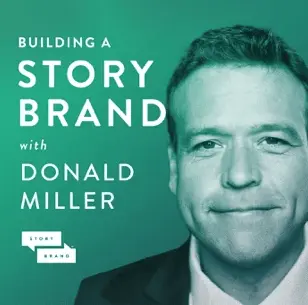
Building a StoryBrand is lauded for its entertaining episodes and inspiring insights. Donald Miller brings in big names like Matthew McConaughey and Seth Godin to talk about storytelling and crafting clear messages that will speak to your customers.
This podcast came highly recommended by Trevor Rappleye, the CEO of CorporateFilming, who said Building a StoryBrand will help you simplify your message and drive sales.
Listen to Building a StoryBrand
2. All Selling Aside
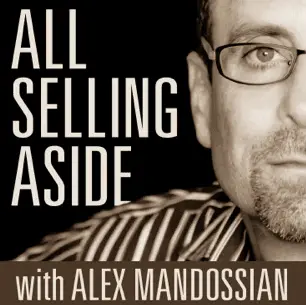
This podcast is for those who find themselves in the unfortunate position of having to sell when they actually hate selling. Host Alex Mandossian will walk you through different strategies to use the power of storytelling to achieve your sales goals.
Carol Tompkins, Business Development Consultant for AccountsPortal, recommends All Selling Aside because “it focuses on teaching consultants like myself, as well as other professionals, how to ethically influence others both personally and professionally, rather than just focusing on selling all the time.”
3. Be The Drop
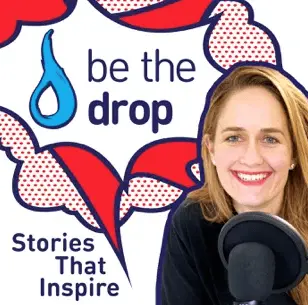
Be The Drop is all about the intersection of business and good communication, and it’s sure to lift your mood. The show hosts diverse guests each week to hear how they inspire and motivate the people around them. This recommendation also came from Carol, who said that Be The Drop can ultimately help you manage your business more effectively by improving your communication skills.
4. Business of Story
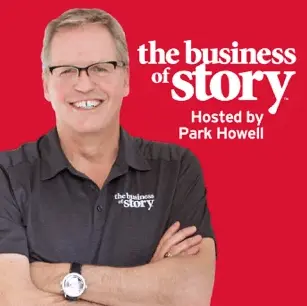
Business of Story is another great bet for brand storytelling highlights. There are nearly 300 episodes, and the show even won a “Best Small Business Podcast” award in 2017. It comes recommended by John Peterson, editor at Safe Drive Gear. He told us Park Howell’s show features “brilliant business owners and entrepreneurs, handpicked influencers, startup founders, and more. The topics are always inspiring, and it leads you to astounding discoveries.”
5. Under the Influence
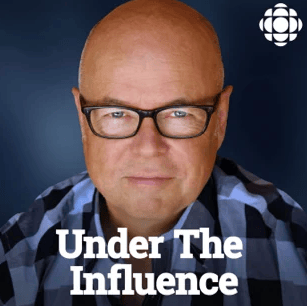
This popular CBC Radio program was recommended to us by Kevin Carney of Organic Growth. He says, “It’s my absolute favorite podcast about marketing and advertising, as it talks about strategy, not day-to-day tactics.” This pod isn’t specifically about storytelling, but it offers a behind-the-scenes look at the ad industry that’s sure to leave you with some interesting anecdotes.
6. The Employer Branding Podcast
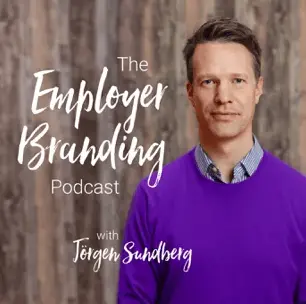
The Employer Branding Podcast offers an international take on branding in business. This recommendation came to us courtesy of Dwight Zahringer, President of Pure Cabo. He says, “Weekly episodes are 20 minutes long and super digestible, covering tons ofbranding topics with a human focus. Plus, they interview some pretty cream-of-the-crop guests from Fortune 500 companies like SalesForce to L’Oreal to Deloitte. So you’re really hearing the best insights.”
Listen to the Employer Branding Podcast
7. How Brands Are Built
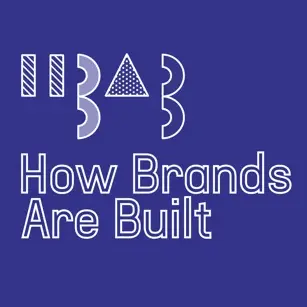
This podcast offers a view of the nitty-gritty, everyday details of branding. Also recommended by Dwight, he told us, “How Brands Are Built is fantastic for understanding how to share and build momentum around your origin story. Rob Meyerson interviews an eclectic group of folks for his episodes, from marketing analysts to logo designers. You really get a 360-degree view of what’s involved in a persuasive original story, plus how to share it for max impact.”
Listen to How Brands Are Built
8. Business Storytelling Podcast
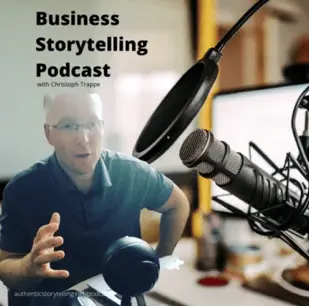
The aptly named Business Storytelling Podcast hosted by content marketer Christoph Trappe will show you how to harness the power of stories to get results. Emma Bourke, CMO at Zodiac Guides, told us this podcast “provides invaluable tips … with content that’s relevant, engaging and educational.”
Listen to Business Storytelling Podcast
Editors’ Picks
We also wanted to throw in our own top picks to get your storytelling juices flowing. Without further ado, here are some of our faves, including some outside-the-box recs and Lucidpress’s very own podcast.
9. The Visual Storytelling Podcast

The Visual Storytelling Podcast can help you round out your storytelling skills with a fresh point of view. This podcast from Disney Artist Chris Oatley will walk you through how visual artists tell stories. Touching on subjects like children’s stories and character development may have surprising impacts on your own storytelling endeavors. If anything, it’s a nice break from the world of business podcasts.
Listen to The Visual Storytelling Podcast
10. On Writing

On Writing will give you a different perspective on storytelling and can help you refine your techniques. Host Joshua Pomare talks to writers of all stripes to dig into the writing and publishing process. If you want tips from the true pros of storytelling, this is the podcast to listen to.
11. Nonprofit Storytelling Living Room
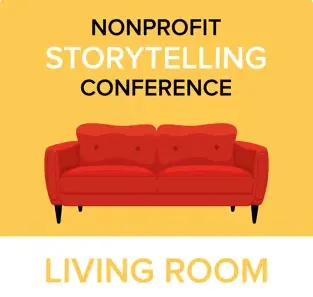
This limited series features speakers from the Nonprofit Storytelling Conference with eight different episodes doing a deep dive on how to use storytelling to accomplish your nonprofit’s goals. It’s one of the best industry-specific shows we’ve come across and can help you craft engaging stories for your audience.
Listen to Nonprofit Storytelling Living Room
12. Brand Land
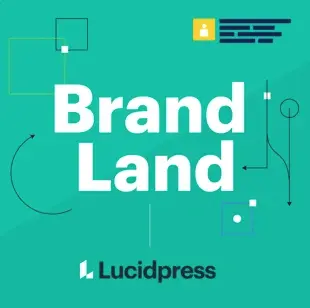
Well, well, well, what have we here? Yes, it’s our very own podcast, Brand Land. Our Director of Marketing, Garrett Jestice, talks to a new guest every week from diverse fields. The show is all about how to build a trusted brand, and each guest brings their own unique insight to give you tips on brand strategy, content creation, customer experience, storytelling and more.
We tell stories every day. Whether it’s a quick ditty to a friend or a long anecdote to your grandchildren, storytelling is ingrained in us. In our professional lives, we also tell stories. We tell stories to persuade someone to support a project, inspire a team, or explain a complex problem.
Storytelling is an essential skill in the professional world, but you may not be using it to its full advantage. Successful business storytelling can set you apart from your competitors and bring in loyal customers, which is why it’s essential to know how to craft a great story. We’ve created this quick guide to break down the business story writing process so you can fine-tune your storytelling skills and reap the benefits.
What is storytelling in business?
Business storytelling takes abstract concepts and complex messages and solidifies them into simple and attainable terms. It can help your customers take a non-tangible concept and relate it to concrete ideas and emotions. Storytelling in business is also the heart of inbound marketing. It’s not facts and figures that stick in our minds — it’s the stories and emotions they invoke that leave us wanting more (or have us running out to buy the new iPhone).
How many Super Bowl commercials can you remember that left you in tears? Or, ask someone and chances are they can tell you the reason why they donated to a cause or bought something. It may surprise you how often those reasons link back to a story the company told. So without further ado, let’s break down business storytelling so you can get writing.
Steps to creating a story
1. Know your audience
We’ll stress this until we’re blue in the face: Know your audience. This important piece of work will determine your message, your medium, your distribution … it may already determine your product or service. The extra time you take to dive into your audience’s demographics will pay off greatly in the long run. Without specific information on their wants and needs, you could end up with a real disaster. For example, if you are set on sending out flyers or a brochure when your audience is largely a Gen-Z crowd, you’re going to fail. Younger audiences expect that useful information is most likely going to come in digital form.
As you start research on your target market, it can help to define your buyer personas. A buyer persona can also help provide direction for the first few steps as you build out the foundation of your story. Make sure to move past age, gender and other obvious sections of their demographics. Find out what their triggers and stressors are. Even better, find out what pushed them into the content-consumption phase of their customer experience.
2. Determine your message
This, of course, is coming as number two because it doesn’t matter how long or short or where you are publishing it — your story needs to have a core message. It will be the foundation of your story moving forward. Eke out whether your story is to raise funds, advocate for an issue, explain a service or something else.
To help determine the point of your story, try summarizing your story in one simple sentence. Or give it the old elevator pitch (30 seconds or less!). If you’re unable to, you don’t have a core message, so go back to the drawing board.
3. Include a story arc with conflict and resolution
The best storytellers know that all good stories have an arc that involves a wonderful conflict apex with a tapering resolution. The conflict will be the lesson of how your character overcame a challenge. Your conflict is what will connect you to your audience through relatable experiences. Without that conflict, your story is going to be a bit boring or fall flat with your audience.
And don’t forget that every good story has a closing. Use your resolution to wrap up the story, provide context around the conflict and leave your audience with a call to action.
4. Select your medium and layout
Stories come in all shapes and forms. Some are watched, some are listened to, and others are read. There are several different ways you can distribute your story: in a video, in copy on your website, through in-person or virtual presentations, via social media, etc.
Picking the right medium for your story will probably depend on your resources and budget. Just remember that no matter which medium you choose, you want to make your message relatable to your audience.
5. Produce it
Once you’ve chosen your medium, it’s time to produce your story. The production phase will probably include a larger team than you imagine. You’ll want writers to help with a script and other creatives to aid in backdrops for a visual story or layouts for a written story. Involve your social media team to make sure what you produce will translate well on social platforms.
6. Distribute it
You’ll almost always want to share your story on social media and via email. If you’ve chosen a written story, don’t forget to publish it beyond your blog; get it guest-posted or shared on other publications. Digital stories are great on your own social media platforms, but also be sure to include them on Vimeo and YouTube. The more places you share your story, the more engagement you’ll get.
Do’s and don’ts of business storytelling
- Make the customer the hero of the story.The focus of your story should be on your audience or customer. Hone in on events you’ve witnessed or lessons you’ve learned, but try to keep yourself out of it. Your story shouldn’t be about how great you are; it will alienate your audience and could pull them away from you.
- Keep it simple: stick to one storyline and one message.Don’t let unnecessary details detract from your message. Some of the most memorable stories are straightforward and rely on the “less is more” principle. Certain details are important to include, such as emotions, the expression on a face, etc. These kinds of details help immerse your audience without distracting from your core message.
- Include a call to action.Don’t forget to include your call to action! Outline specifically what you want your audience to do after reading/watching/listening. It can be as simple as a colorful share button at the bottom of a screen or a quick callout at the end of a video.
- Don’t make it a sales pitch or an advertisement.Your audience is already overwhelmed with ads day in and day out. The purpose of storytelling is to further a brand or foster community outreach. Don’t use a really good story to simply sell a specific product or service you provide. Instead, use it to grow brand awareness or reach out to donors and investors.
- Include a hook and make it engaging.If you ever took a writing course in school, you’ll remember how important that first paragraph is. How often your teachers stressed having a good hook to draw the reader in. It’s no different with your content. You need a good hook that will draw your audience in, and then you need to continue that momentum throughout to keep them engaged.
Some great brand storytelling examples
A recent example of effective business storytelling has been Best Buy’s commercials in recent years. The company’s most recent campaign, “Dear Best Buy,” is an homage to the letters children write to Santa Claus, only these letters are specific to the strange times we’re currently living in. The ad starts out with a customer asking for holiday gift-giving advice and ends with a Best Buy employee providing recommendations.
Another great brand story comes from TOMS. The shoe company shares stories of not only its customers but also the people it serves through each purchase. By doing so, TOMS created a movement that increased sales and built a community.
We’d be remiss if we didn’t include Apple in our brand storytelling examples. Apple uses real-life stories to describe exactly how its products benefit users, and oftentimes a script isn’t even needed. The company’s latest commercials for AirPods show customers using the extensive features of the earphones throughout everyday experiences like catching the metro or walking home. Apple leaves the technical jargon at home, letting the music do the talking.
As you pull out that computer or lay out your pen and paper to write your story, remember that in the end, storytelling is always about your audience. What do they need and what do you have that can help them? If you’re stuck, go out and talk to people. The best storytellers know that they don’t have the only stories to tell. Chat with a colleague, a friend or a peer. Inspiration could strike from anywhere, and just remember that storytelling is a trial-and-error process. Your first run at it may not be astounding, but as they say, practice makes perfect!
We’ve got some tips on how to get your whole organization on board for consistent storytelling: Check out our ebook The rise of the design democracy: How to maintain a consistent brand story.
Real talk: Trying to find a strong content marketing example is like looking for a needle in a haystack, mostly because there are just so many stinking options. Seriously though — between social media algorithms, walled gardens, SEO, paid ads and everything else under the marketing sun, we’re inevitably served some sort of content marketing experience that’s designed to get our goat and draw us in.
So, how do you decide what counts as “the best content marketing examples?”
:eyebrow wiggle:
>Related: Examples of great marketing initiatives
How we evaluated the general existence of content marketing
The best content marketing tells a story. Well, not just any story, a good story. One replete with emotions, thoughtful cadence and something that ties it all together — good content marketing speaks to you on some level. Which is to say that the best content marketing does these three things:
- Keeps the throughline (or red thread) obvious
- Knows its audience — e.g., where to exceed expectations and where to keep it simple
- Creates a sense of camaraderie
So, without further ado, here are our fave examples of good content marketing:
1. Mailchimp’s original content
Mailchimp, the beloved marketing platform that helps small businesses do everything from email to website building and analytics, is also putting out the best content in the game. The brand is undoubtedly #1 in our book, and whenever the subject of good content comes up, we all inevitably sigh and get big heart eyes over whatever Mailchimp has recently put out.
The brand has not one but two content platforms: Courier, which offers marketing advice from experts and articles about trendy small businesses and Mailchimp Presents, a collection of original podcasts, movies, and video series that “celebrates the entrepreneurial spirit.”
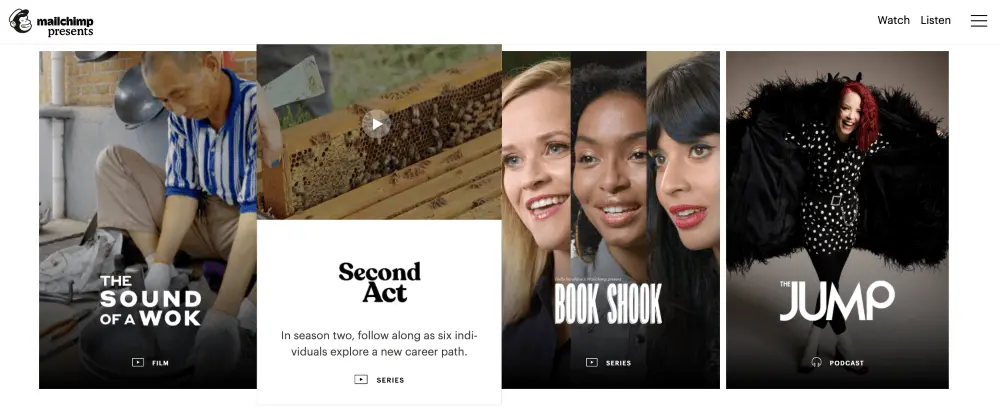
Right away Mailchimp’s red thread is obvious — the brand story, a celebration of entrepreneurship and creativity, is loud and clear. And while the budget involved in this level of production is nothing to sneeze at, money will only get you so far. Mailchimp has perfected the art of taking human stories and turning them into content that’s relevant, interesting and, above all, inspiring.
While we’re gushing, we encourage you to watch one of our favorite pieces, Noodle School: a short documentary about students in Lanzhou, China, learning to make traditional hand-pulled noodles.
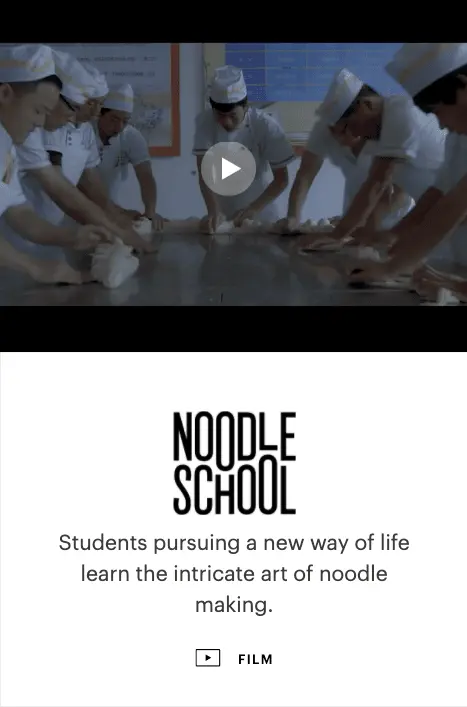
2. Great Jones’s food media
Great Jones has made a name for itself offering high-quality cookware at affordable prices, complete with a jewel-toned aesthetic that sets millennial hearts aflutter. And true to the brand’s hip ethos, its content does not disappoint.
The Great Jones Digest is filled with mouth-watering recipes and interviews with the movers and shakers of the food world. Is it a blog, per se? We’re not sure. Is it a perfect amalgamation of product placement and food-celebrity endorsements wrapped in genuinely good content that rivals large publications like Bon Appétit? Yes.
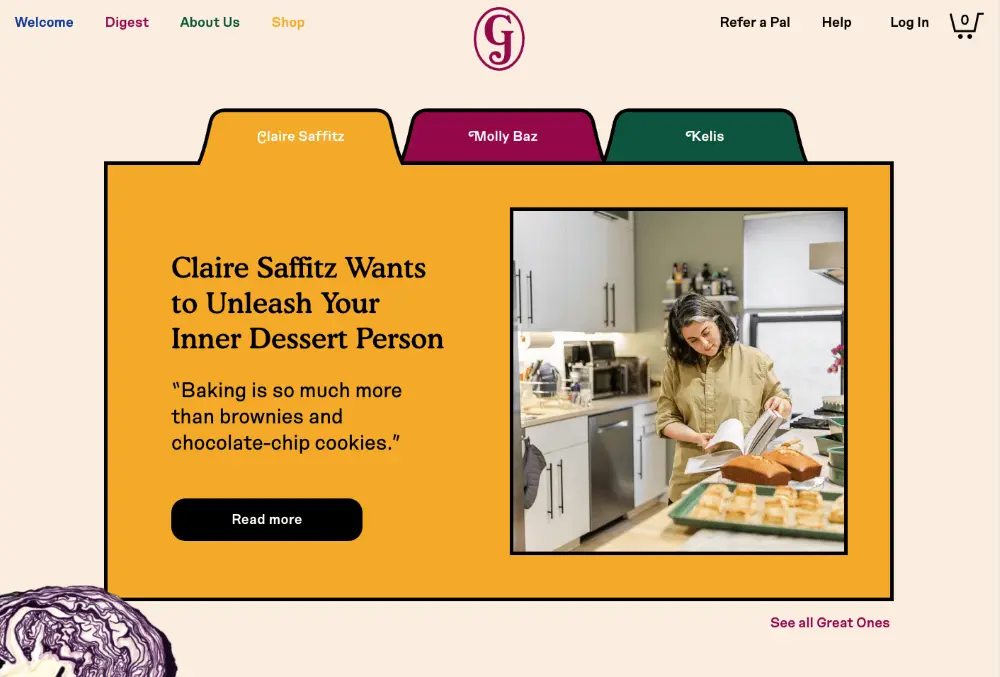
(The brand also has an extremely well-curated Instagram that does wonders for their marketing.)
There are a few elements at work here, and combined, they pack a powerful punch: content that’s relevant to a culinary-inclined audience (recipes!), trusted endorsements, pleasing design and format, showy but not annoying displays of the product. Yes, it is the whole package, but working even one or two of these tactics into your own content marketing can help move the needle.
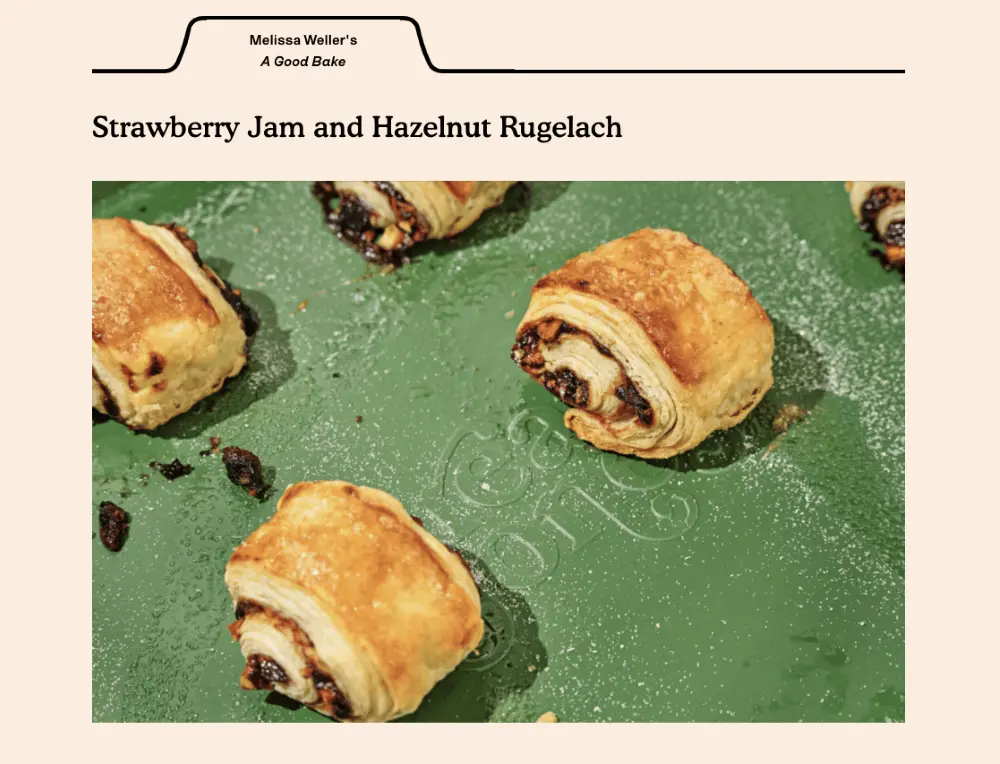
Thanks, we’re hungry now.
3. Trello’s straightforward blog
Alas, good content doesn’t have to be the flashy, big-budget crème de la crème. Sometimes it’s as simple as offering a well-written blog post.
The Trello blog, whose content is also served up in a weekly email newsletter, offers uncomplicated articles full of good advice on topics that appeal to the wide-ranging workers of the world. What makes it special? Good-quality writing on topics that we’re genuinely interested in.
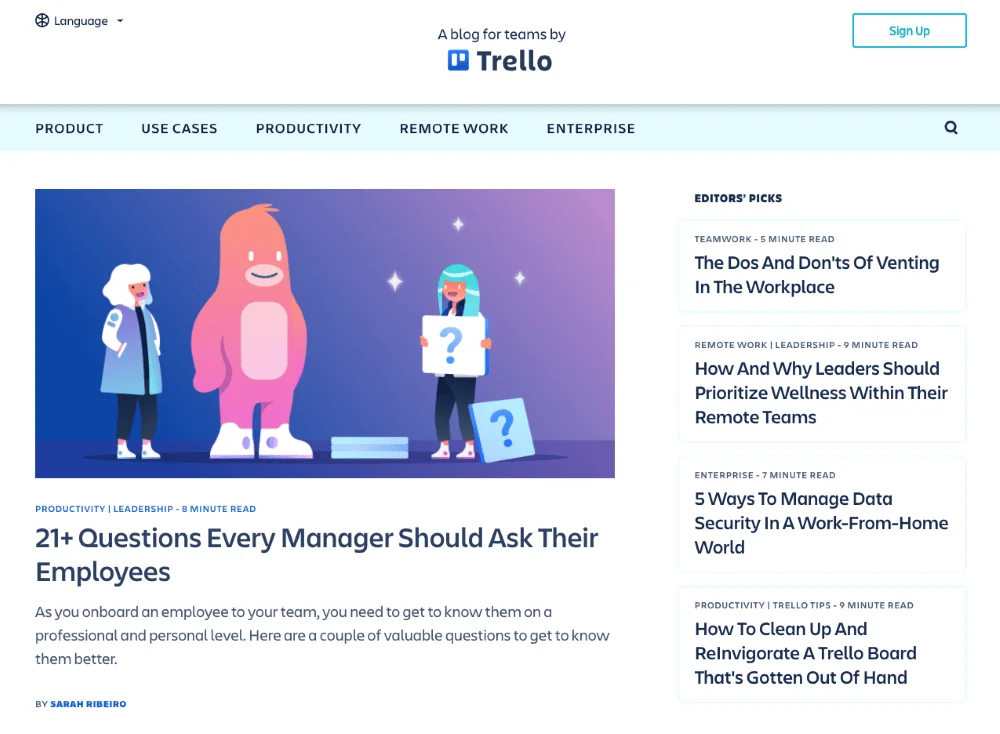
With topics including how to manage work anxiety, productivity hacks and mastering work-life balance, Trello’s content will resonate with anyone on the 9-5 grind. The blog also manages to work in plenty of product-focused tutorials for its customers in a way that doesn’t feel pedantic or out of place.
Take note: Spending time to do the simple things well can really elevate your content. A good blog can be small but mighty.
4. Tushy’s customer testimonials

Americans are intensely private about their bodily functions. It’s taboo to talk about poo — likely a result of their Protestant roots — regardless, they aren’t big fans of bidets because, well, bidets clean your bottom region. And that means you poop.
Enter: Tushy.
Tushy is “the modern bidet for people who poop.” Or “the modern bidet that saves your ass, saves your money, saves the planet and saves the world.”

Pretty exciting stuff, eh? Real people, on the john, in real life. Well, kinda. But, how do you get people to actually buy a bidet when a.) we’re afraid of our own b-holes and b.) when we’re afraid of bidets?
- One — Tushy lowered the barrier of entry. Buying and installing a bidet is intimidating. So, Tushy made the installation process ridiculously easy (both writers on this post have installed Tushys in their respective abodes). Plus, traditional bidets aren’t exactly renter-friendly (in the sense that you can’t exactly uninstall your personal, full-size bidet when you move). Tushy, on the other hand, is totally transportable.
- Two — Tushy harnessed the power of social proof to destigmatize talking about our bathroom habits. Because, in a world of information and option overload (and marketing campaigns galore), it’s hard to know who to trust and what information just a total crock of bullsh*t. So instead of leaving you high and dry, they ensure you have unobstructed access to what other Tushy enthusiasts have to say about that bidet life.
Customer testimonials are about as timeless as they come — plus they’re some of the most effective, easiest marketing content you can get. All you have to do is ask for it.
5. Ruffwear’s interactive content and social media
Pets, though more specifically dogs, mean a lot to us — they’re our companions, support animals, entertainment sources and more.
Ruffwear’s “My Dog is My” campaign spotlights the various ways in which dogs contribute and participate in our lives, presenting great opportunities for people to see the product in action, worn by dogs like their own in some way, shape or form.
Ruffwear uses its “My Dog is My” marketing in a variety of ways, however, there are three worth highlighting here:
Ruffwear blog
The Ruffwear blog is a great space to share “My Dog is My” stories, without necessarily needed to have a scoped out marketing campaign, replete with photographers and such.
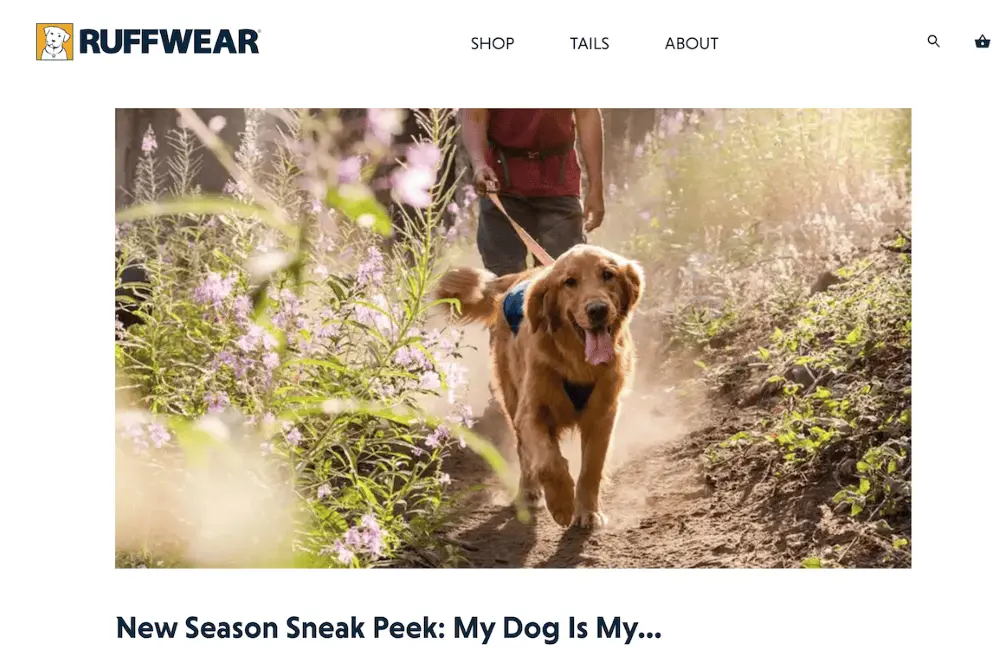
Core homepage
Ruffwear has an incredibly diverse range of customers — as highlighted by the various core homepage content stories related to the “My Dog is My” campaign.
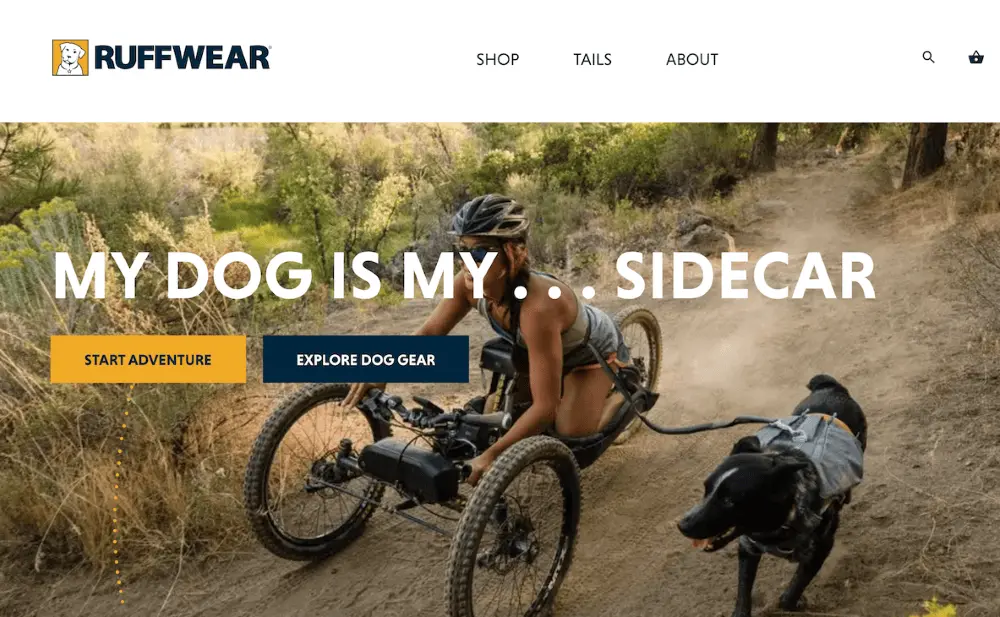
Social proof
Ruffwear leverages customer participation and real-life examples of their product in action with the social media hashtag #mydogismy. Crazy to think that there are already 350K posts of various pups in Ruffwear threads.
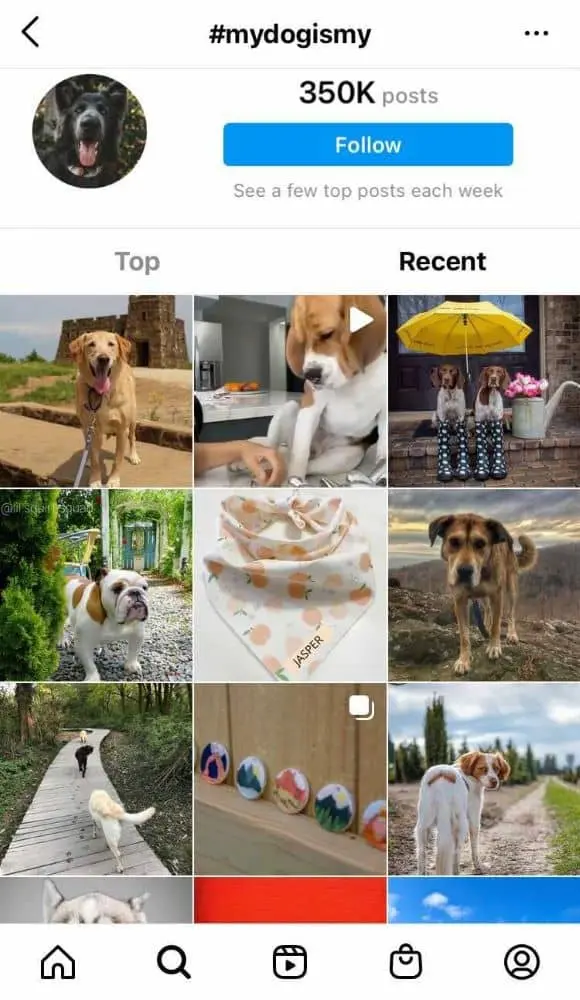
If there’s one takeaway to be had from Ruffwear, it’s that you don’t need a giant marketing budget to create effective content — you just need a creative way to encourage your customers to share their stories.
Overall, pups and people are the heart of Ruffwear’s “My Dog is My” content marketing campaign. By encouraging customers to use the hashtag and highlight their pup, Ruffwear effectively creates a community of Ruffwear-lovers and dog-lovers alike.
>Need more info? Check out measuring marketing effectiveness
6. Cricut’s celebrity endorsement
Hey, you, put down the pinking shears and the granny square afghan! You may think you know DIY, but you have no idea. Cricut takes crafting to the next level and blasts open your world of DIY crafting opportunities with its cutting machines.
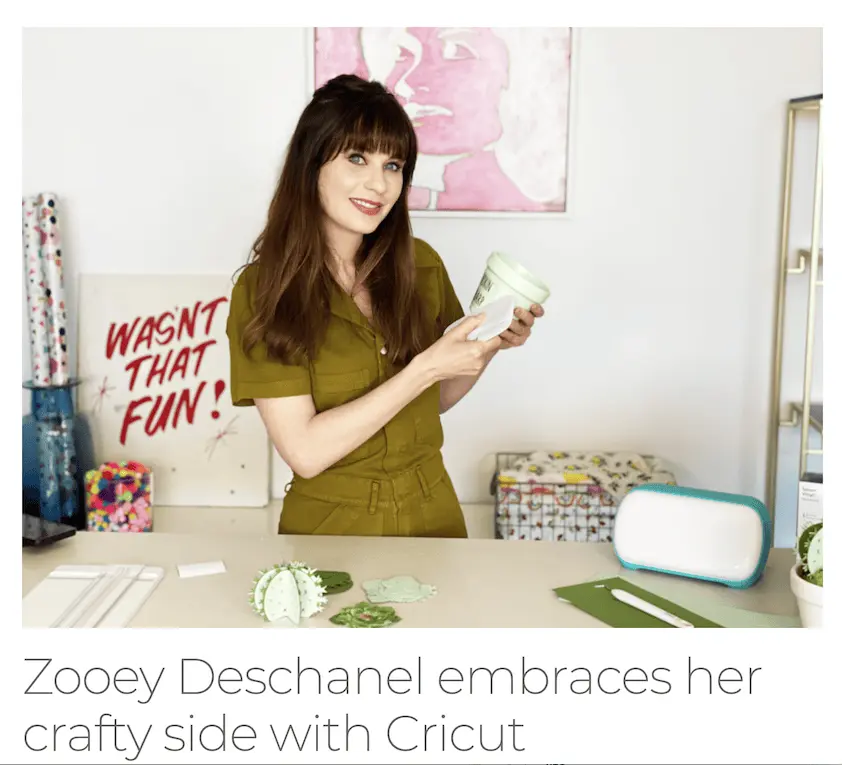
Celebrity endorsements can go one of two ways — great or poorly. In Cricut’s case, the brand’s endorsement and collaboration from Zooey Deschanel were pretty stinking spiffy.
A key component of successful celebrity endorsements is knowing your audience. Now, there’s something to be said about an ironic celeb collaboration, but again, that content’s effectiveness depends on your audience. So Cricut’s decision to work with Deschanel was a well-informed and smart one. Because not only does Zooey Deschanel stars as the ultra-crafty Jess in “New Girl,” but Deschanel happens to be quite the craft enthusiast in real life.
7. And Bud Light’s celeb highlight we couldn’t resist
At the end of the day, a Bud Light is just a Bud Light. You can’t change it, dress it up or put lipstick on that ole pig. You know exactly what to expect when you’re drinking a Bud Light, aka a BL Smoothie — cold and gold. Anything else would be absurd.
Bud Light manages its customers’ expectations well. Case in point: Bud Light’s use of Post Malone in the 2020 Superbowl ad for Bud Light Seltzer.
Everyone and their cousin is coming out with an alcoholic seltzer, so Bud Light needed a creative way to stand out in the crowd without alienating its current base and most loyal customers.
And, yes, having ample money in your marketing budget is a pretty beautiful thing, but, more importantly, the Bud Light marketing team enlisted assistance from customers for the final verdict — “the marketing team decided it couldn’t decide which of two Bud Light Seltzer ads it should air during the actual game so it’s letting fans vote between one featuring the rapper Post Malone in a convenience store and another of him in bar.”
So how can you use this inspiration and take action? It’s never a bad idea to brainstorm with your team and identify what it is you like about certain campaigns and then see how you can take those principles and apply them to your own brand’s content. Ask what resonates with your audience and what would surprise them, who supports your product, and what you yourself would actually be interested in creating.
For more tips on creating effective content that resonates, take a peek at our free mini-ebook: Brand templating: How creating more effective content that gets results.